第一章:前言
1.1 为什么要学习 File 和 IO 流?
- 假设我们现在正在玩《黑悟空》游戏:

- 突然,这个时候,我们需要上厕所(很急):
提醒
网络烂梗:我知道你很急,但你先别急;我都不急,你急什么?

- 此时,我们非常希望能将当前游戏的进度保存下来,以便下次读档继续玩(不想从头再玩):
提醒
- ① 游戏的进度是保存在内存中的,而内存是不能永久化存储数据的,一旦程序停止,数据丢失。
- ② 为了解决这个问题,游戏就需要提供
存档功能和读档功能:- 存档:就是将游戏的进度(数据)保存到文件中,以便可以永久化存储数据。
- 读档:就是从文件中恢复游戏的进度(数据),这样下次就可以接着上次的进度继续玩。

- 这个背后就涉及到了两个知识点:
- 文件在哪里(文件的位置)?
- 如何传输数据(如何将数据保存到文件中,如何从文件中读取数据)?
提醒
- ① 在 Java 中,如何传输数据,需要使用 IO 流技术(存储和读取数据的解决方案)。
- ② 在 Java 中,文件的位置(文件的路径),需要使用到 File 类。

1.2 学习 File 和 IO 流的意义
- ①
程序与外部数据的交互:程序的运行往往需要依赖外部数据(用户输入、配置文件、日志文件等),而 IO 操作是程序读取和写入这些数据的唯一途径。 - ②
持久化存储:程序运行时的数据通常存储在内存中,但断电或程序关闭后会丢失。通过 IO 操作将数据写入文件或数据库,可以实现数据的持久化存储。 - ③
系统功能的基础:许多系统级功能(日志记录、文件管理、网络通信)都依赖 IO 操作,如:Web 服务器需要读取静态文件、接收客户端请求并返回响应。 - ④
提升程序的灵活性和可维护性:通过读取配置文件或命令行参数,程序可以在不修改代码的情况下调整行为,从而提高灵活性和可维护性。
第二章:File(⭐)
2.1 概述
- FIle 类的对象就表示一个路径,可以是
文件的路径,也可以是目录的路径。
提醒
- ① File 类是用于操作
本地文件系统的资源(文件或目录),即:只能处理file://协议的 URI。 - ② File 类并不能处理网络上的资源,如:
https://xxx。
- File 类的对象表示的路径,可以是存在的,也可以是不存在的。
2.2 创建 File 对象
- File 类提供了一系列的重载构造方法用于创建 File 对象:
| 构造方法 | 说明 |
|---|---|
public File(String pathname){} | 根据文件路径创建 File 对象 |
public File(File parent,String child){} | 根据父路径对应的文件对象和子路径字符串创建文件对象 |
public File(String parent,String child){} | 根据父路径字符串和子路径字符串创建文件对象 |
提醒
- ① 之所以创建 File 对象,是因为 File 对象身上有我们想要的方法。
- ② 对于 Java 而言,字符串路径仅仅只是字符串而已(和 "abc" 没什么区别),不能和本地文件系统上的文件产生联系!!!
- ③ 对于 Java 而言,只有将字符串路径转换为 File 对象之后,此时的字符串路径才是真实的文件路径。
- 示例:
java
package com.github.file;
import java.io.File;
public class Test {
public static void main(String[] args) {
// 字符串路径
String pathName = "D:\\develop\\apache-maven-3.9.9\\README.txt";
// 将字符串表示的路径,变为 File 对象
File file = new File(pathName);
System.out.println(file);
}
}1
2
3
4
5
6
7
8
9
10
11
12
13
14
15
16
2
3
4
5
6
7
8
9
10
11
12
13
14
15
16
- 示例:
java
package com.github.file;
import java.io.File;
public class Test {
public static void main(String[] args) {
/* 字符串路径 */
// 父路径
String parentPath = "D:\\develop\\apache-maven-3.9.9";
// 子路径
String child = "README.txt";
// 将字符串表示的路径,变为 File 对象
File file = new File(parentPath, child);
System.out.println(file);
}
}1
2
3
4
5
6
7
8
9
10
11
12
13
14
15
16
17
18
19
2
3
4
5
6
7
8
9
10
11
12
13
14
15
16
17
18
19
- 示例:
java
package com.github.file;
import java.io.File;
public class Test {
public static void main(String[] args) {
/* 字符串路径 */
// 父路径
String parentPath = "D:\\develop\\apache-maven-3.9.9";
// 子路径
String child = "README.txt";
// 将字符串表示的路径,变为 File 对象
File file = new File(new File(parentPath), child);
System.out.println(file);
}
}1
2
3
4
5
6
7
8
9
10
11
12
13
14
15
16
17
18
19
2
3
4
5
6
7
8
9
10
11
12
13
14
15
16
17
18
19
2.3 常用 API
2.3.1 判断系列
- 判断 File 对象表示的文件(目录)是否可读、可写、可执行:
java
public boolean canRead() {}1
java
public boolean canWrite() {}1
java
public boolean canExecute() {}1
- 判断 File 对象表示的文件(目录)是否是文件还是目录:
java
public boolean isFile() {}1
java
public boolean isDirectory() {}1
- 判断 File 对象表示的文件(目录)是否存在:
java
public boolean exists() {}1
- 示例:
java
package com.github.file;
import java.io.File;
public class Test {
public static void main(String[] args) {
/* 字符串路径 */
String parentPath = "D:\\develop\\apache-maven-3.9.9";
String child = "README.txt";
// 将字符串表示的路径,变为 File 对象
File file = new File(new File(parentPath), child);
// 判断系列的方法
System.out.println(file.canRead()); // true
System.out.println(file.canWrite()); // true
System.out.println(file.canExecute()); // true
System.out.println("--------------------------");
System.out.println(file.isFile()); // true
System.out.println(file.isDirectory()); // false
System.out.println("--------------------------");
System.out.println(file.exists()); // true
}
}1
2
3
4
5
6
7
8
9
10
11
12
13
14
15
16
17
18
19
20
21
22
23
24
2
3
4
5
6
7
8
9
10
11
12
13
14
15
16
17
18
19
20
21
22
23
24
2.3.2 获取系列
- 获取文件的大小:
java
public long length() {}1
提醒
- ① 该方法只能获取单个文件的大小(单位是 B(字节)),不能获取文件夹的大小。
- ② 如果想要获取文件夹的大小,需要遍历文件夹下的所有文件,并就每个文件的大小累加起来。
- 获取文件或目录的绝对路径:
java
public String getAbsolutePath() {}1
- 获取构造方法中的路径:
java
public String getPath() {}1
- 获取名称:
java
public String getName() {}1
提醒
- ① 如果是文件,包含文件名(
README)和后缀名(.md),即:README.md。 - ② 如果是目录,就是目录名。
- 获取文件最后修改时间(毫秒值):
java
public long lastModified() {}1
- 示例:
java
package com.github.file;
import java.io.File;
public class Test {
public static void main(String[] args) {
/* 字符串路径 */
String parentPath = "D:\\develop\\apache-maven-3.9.9";
String child = "README.txt";
// 将字符串表示的路径,变为 File 对象
File file = new File(new File(parentPath), child);
// 获取系列方法
// 只能获取单个文件的大小,单位是 B(字节)
System.out.println(file.length()); // 1279
// 不能获取文件夹的大小,不同操作系统上的行为可能不一致
System.out.println(new File(parentPath).length()); // 4096
}
}1
2
3
4
5
6
7
8
9
10
11
12
13
14
15
16
17
18
19
20
2
3
4
5
6
7
8
9
10
11
12
13
14
15
16
17
18
19
20
- 示例:
java
package com.github.file;
import java.io.File;
public class Test {
public static void main(String[] args) {
/* 字符串路径 */
String parentPath = "D:\\develop\\apache-maven-3.9.9";
String child = "README.txt";
// 将字符串表示的路径,变为 File 对象
File file = new File(new File(parentPath), child);
// 获取系列方法
// 可以获取文件的绝对路径 D:\develop\apache-maven-3.9.9\README.txt
System.out.println(file.getAbsolutePath());
// 可以获取目录的绝对路径 D:\develop\apache-maven-3.9.9
System.out.println(new File(parentPath).getAbsolutePath());
}
}1
2
3
4
5
6
7
8
9
10
11
12
13
14
15
16
17
18
19
20
2
3
4
5
6
7
8
9
10
11
12
13
14
15
16
17
18
19
20
- 示例:
java
package com.github.file;
import java.io.File;
public class Test {
public static void main(String[] args) {
/* 字符串路径 */
String parentPath = "D:\\develop\\apache-maven-3.9.9";
String child = "README.txt";
// 将字符串表示的路径,变为 File 对象
File file = new File(new File(parentPath), child);
// 获取系列方法
// 获取构造方法中的路径 D:\develop\apache-maven-3.9.9\README.txt
System.out.println(file.getPath());
// 获取构造方法中的路径 D:\develop\apache-maven-3.9.9
System.out.println(new File(parentPath).getPath()); // apache-maven-3.9.9
}
}1
2
3
4
5
6
7
8
9
10
11
12
13
14
15
16
17
18
19
20
2
3
4
5
6
7
8
9
10
11
12
13
14
15
16
17
18
19
20
- 示例:
java
package com.github.file;
import java.io.File;
public class Test {
public static void main(String[] args) {
/* 字符串路径 */
String parentPath = "D:\\develop\\apache-maven-3.9.9";
String child = "README.txt";
// 将字符串表示的路径,变为 File 对象
File file = new File(new File(parentPath), child);
// 获取系列方法
// 可以获取名称,如果是文件,就包括文件名和后缀名
System.out.println(file.getName()); // README.txt
// 可以获取名称,如果是目录,就是目录名
System.out.println(new File(parentPath).getName()); // apache-maven-3.9.9
}
}1
2
3
4
5
6
7
8
9
10
11
12
13
14
15
16
17
18
19
20
2
3
4
5
6
7
8
9
10
11
12
13
14
15
16
17
18
19
20
- 示例:
java
package com.github.file;
import java.io.File;
import java.time.Instant;
import java.time.LocalDateTime;
import java.time.ZoneId;
import java.time.format.DateTimeFormatter;
public class Test {
static DateTimeFormatter df = DateTimeFormatter.ofPattern("yyyy-MM-dd HH:mm:ss");
public static void main(String[] args) {
/* 字符串路径 */
String parentPath = "D:\\develop\\apache-maven-3.9.9";
String child = "README.txt";
// 将字符串表示的路径,变为 File 对象
File file = new File(new File(parentPath), child);
// 获取系列方法
System.out.println(file.lastModified()); // 1723596528000
final LocalDateTime localDateTime = LocalDateTime.ofInstant(
Instant.ofEpochMilli(file.lastModified()), ZoneId.systemDefault());
System.out.println(df.format(localDateTime)); // 2024-08-14 08:48:48
}
}1
2
3
4
5
6
7
8
9
10
11
12
13
14
15
16
17
18
19
20
21
22
23
24
25
26
27
2
3
4
5
6
7
8
9
10
11
12
13
14
15
16
17
18
19
20
21
22
23
24
25
26
27
2.3.3 创建系列
- 创建一个空的文件:
java
public boolean createNewFile() throws IOException {}1
提醒
- ① 细节 1:
- 如果当前路径表示的文件是不存在的,则创建成功,返回 true 。
- 如果当前路径表示的文件是存在的,则创建失败,返回 false。
- ② 细节 2:如果当前路径的父路径是不存在的,方法会抛出 IOException 异常。
- ③ 细节 3:该方法只能创建文件,不能创建文件夹;如果路径中不包含后缀名,那么创建的就是一个没有后缀名的文件。
- 创建单级文件夹(不常用):
java
public boolean mkdir() {}1
提醒
- ① 细节 1:在 Windows 中,文件夹中是不能包含同名的文件或文件夹的。
- ② 细节 2:该方法只能创建单级文件夹,不能创建多级文件夹。
- 创建多级文件夹(单级文件夹,常用):
java
public boolean mkdirs() {}1
- 示例:如果当前路径表示的文件是不存在的,则 createNewFile() 创建成功,返回 true
java
package com.github.file;
import java.io.File;
import java.io.IOException;
public class Test {
public static void main(String[] args) throws IOException {
File file = new File("a.txt");
boolean newFile = file.createNewFile();
System.out.println(newFile); // true
}
}1
2
3
4
5
6
7
8
9
10
11
12
2
3
4
5
6
7
8
9
10
11
12
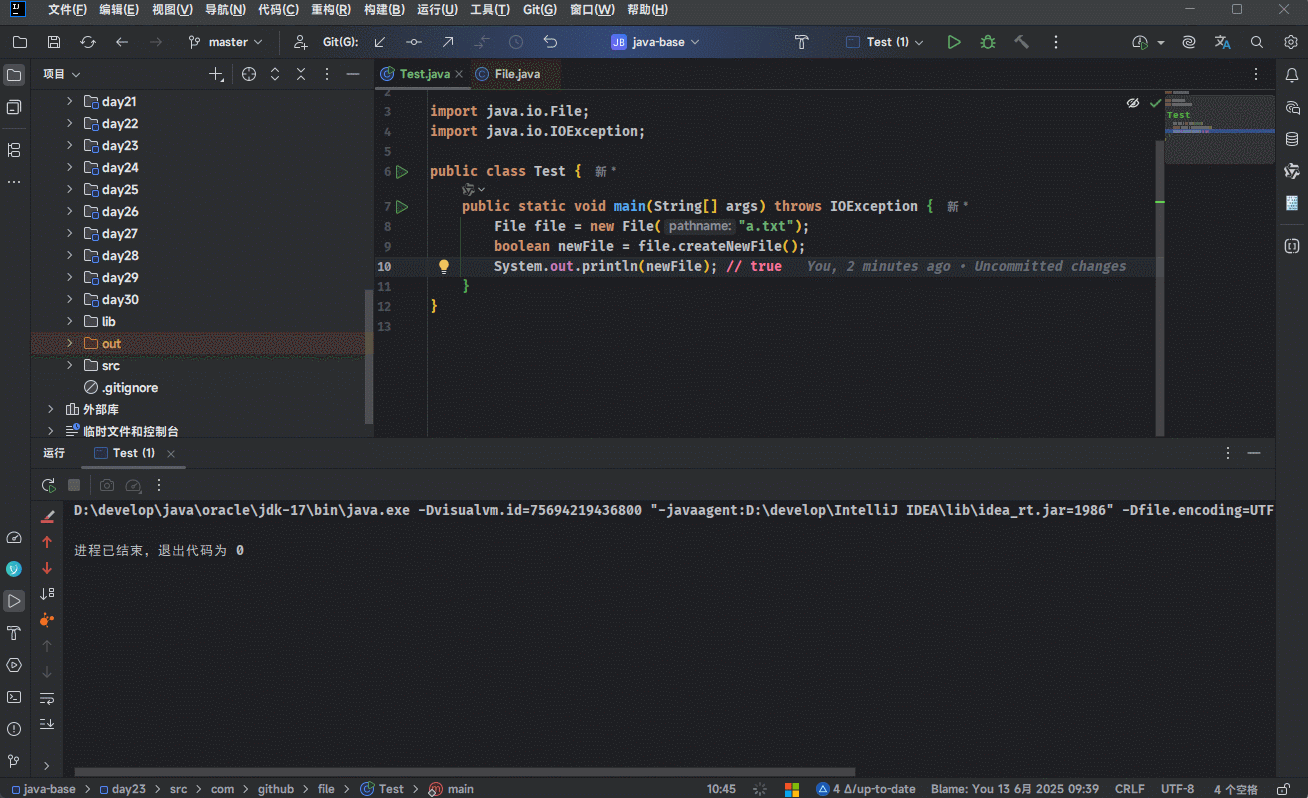
- 示例:如果当前路径表示的文件是不存在的,则 createNewFile() 创建失败,返回 false
java
package com.github.file;
import java.io.File;
import java.io.IOException;
public class Test {
public static void main(String[] args) throws IOException {
File file = new File("a.txt");
boolean newFile = file.createNewFile();
System.out.println(newFile); // false
}
}1
2
3
4
5
6
7
8
9
10
11
12
2
3
4
5
6
7
8
9
10
11
12
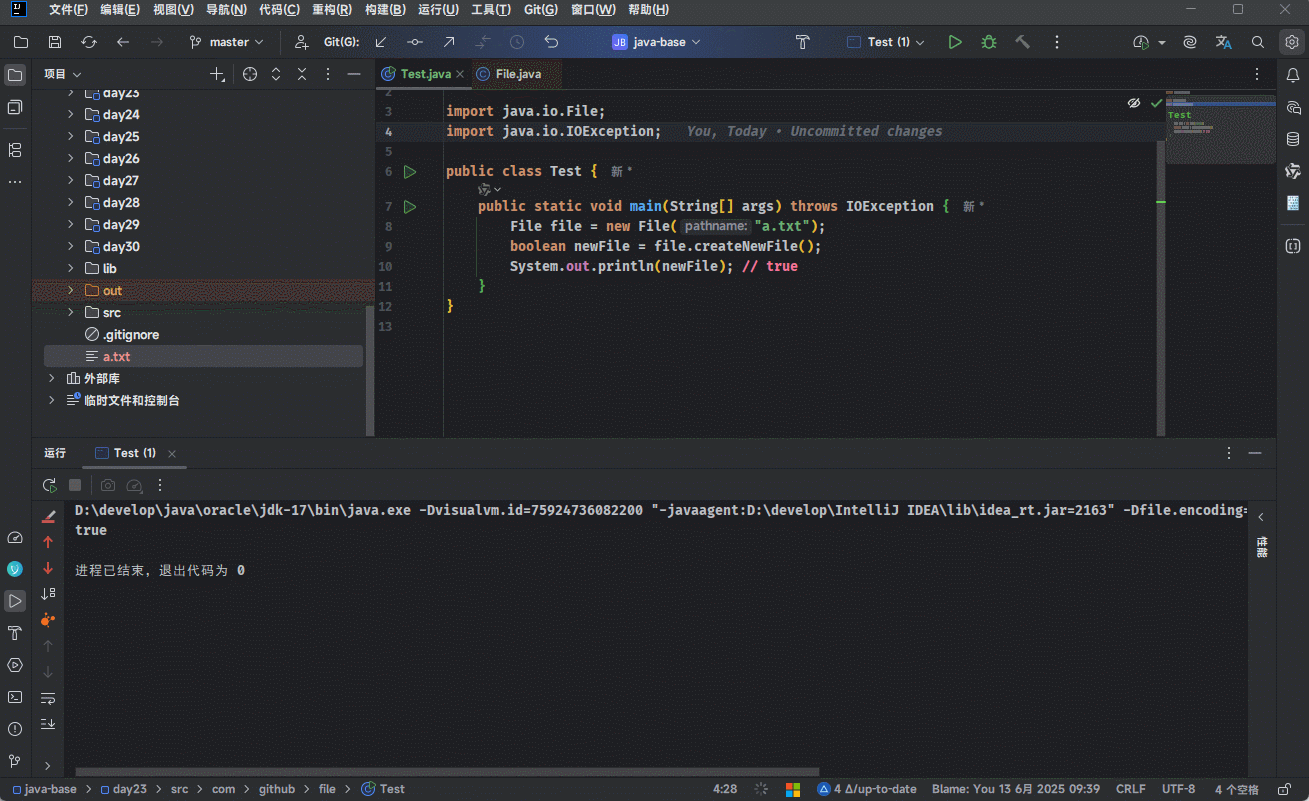
- 示例:如果当前路径中的父路径是不存在的,则 createNewFile() 会抛出异常
java
package com.github.file;
import java.io.File;
import java.io.IOException;
public class Test {
public static void main(String[] args) throws IOException {
File file = new File("aaa/a.txt");
// ❌ 由于父路径不存在,将会抛出异常
boolean newFile = file.createNewFile();
System.out.println(newFile); // false
}
}1
2
3
4
5
6
7
8
9
10
11
12
13
2
3
4
5
6
7
8
9
10
11
12
13
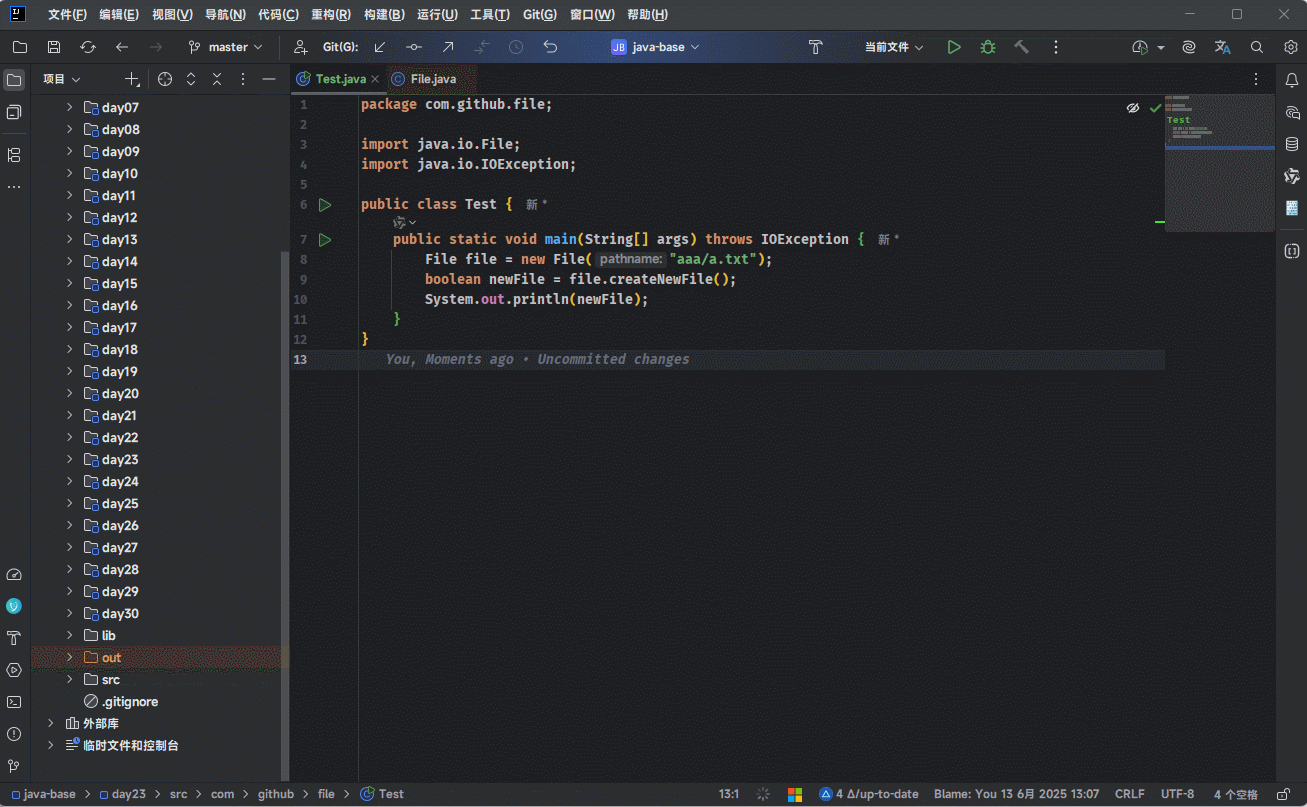
- 示例:createNewFile() 方法只能创建文件,不能创建文件夹
java
package com.github.file;
import java.io.File;
import java.io.IOException;
public class Test {
public static void main(String[] args) throws IOException {
// 如果路径中不包含后缀名,那么创建的就是一个没有后缀名的文件
File file = new File("abc");
boolean newFile = file.createNewFile();
System.out.println(newFile);
}
}1
2
3
4
5
6
7
8
9
10
11
12
13
2
3
4
5
6
7
8
9
10
11
12
13
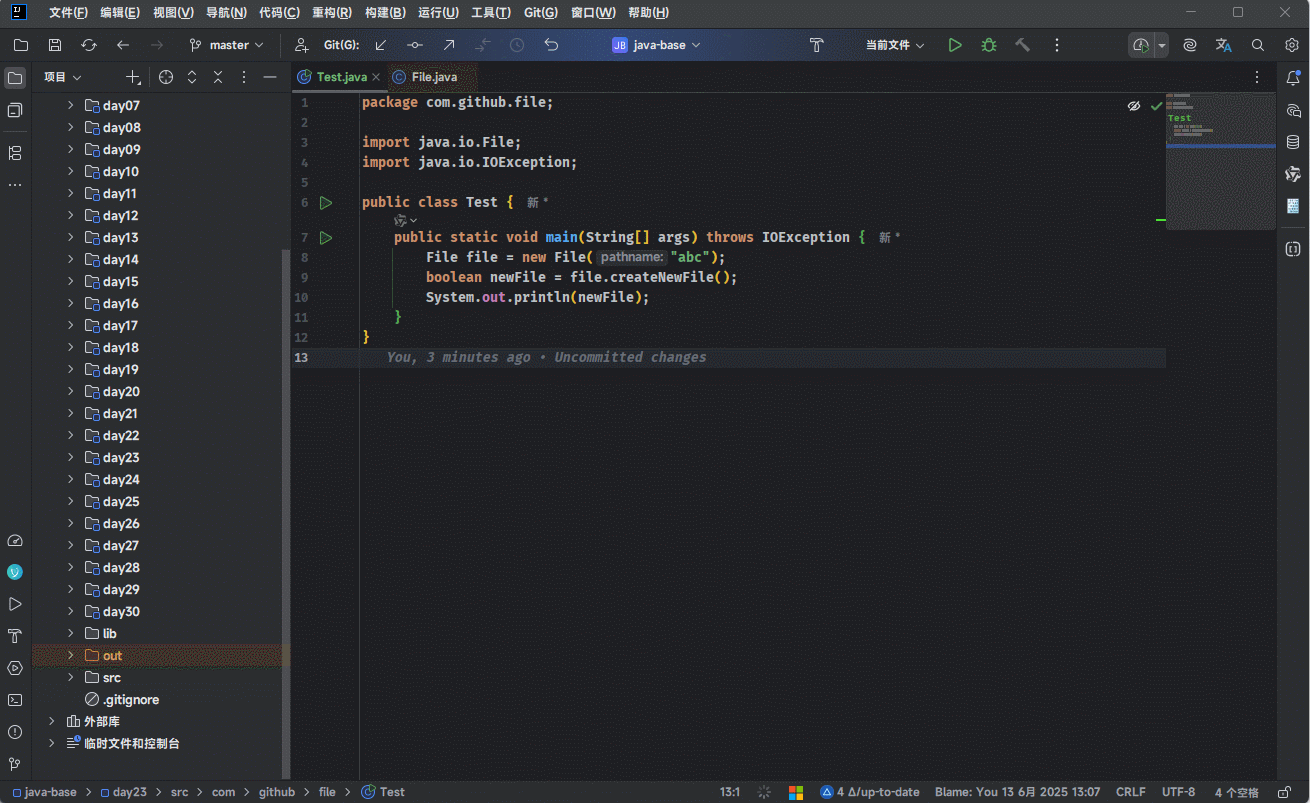
- 示例:mkdir() 方法只能创建单级文件夹
java
package com.github.file;
import java.io.File;
public class Test {
public static void main(String[] args) {
File file = new File("aaa");
boolean b = file.mkdir();
System.out.println(b);
}
}1
2
3
4
5
6
7
8
9
10
11
2
3
4
5
6
7
8
9
10
11
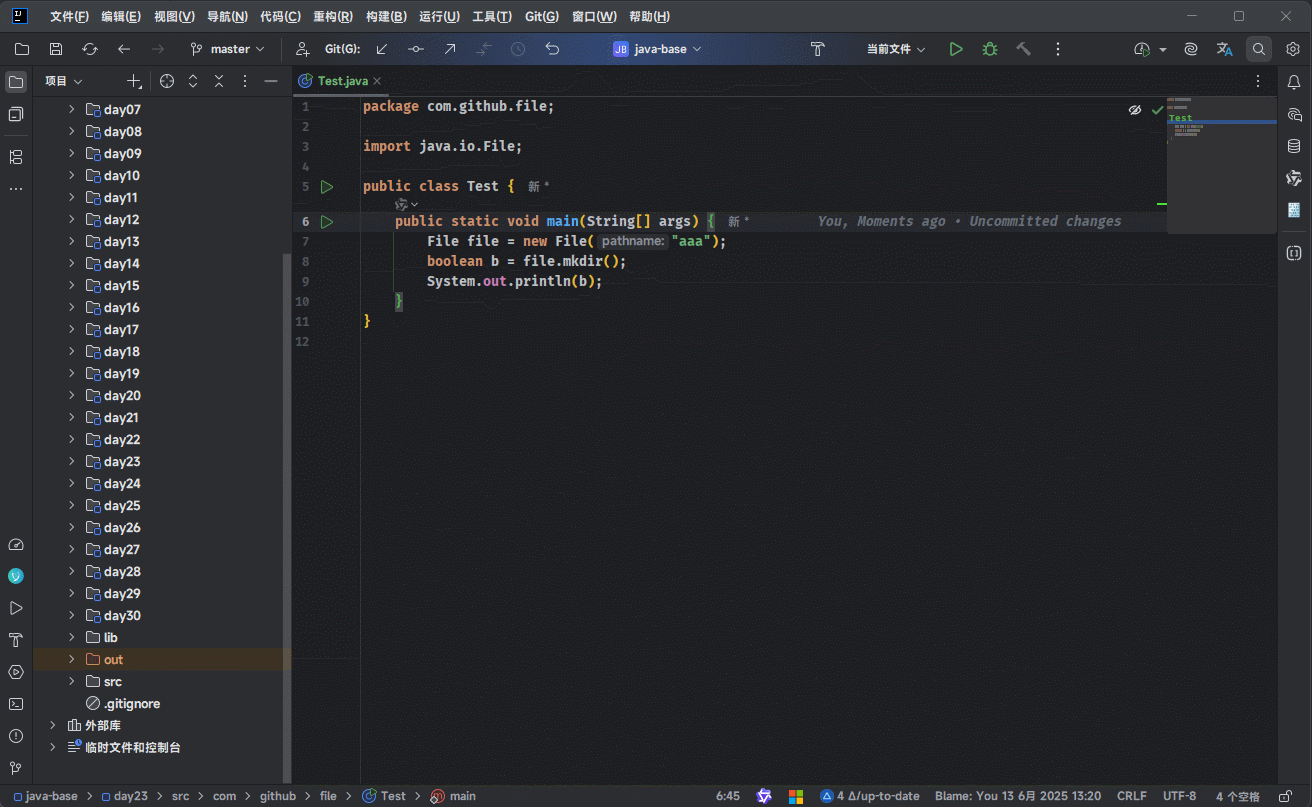
- 示例:mkdir() 方法不能创建多级文件夹
java
package com.github.file;
import java.io.File;
public class Test {
public static void main(String[] args) {
File file = new File("aaa/abc/ccc");
boolean b = file.mkdir();
System.out.println(b);
}
}1
2
3
4
5
6
7
8
9
10
11
2
3
4
5
6
7
8
9
10
11
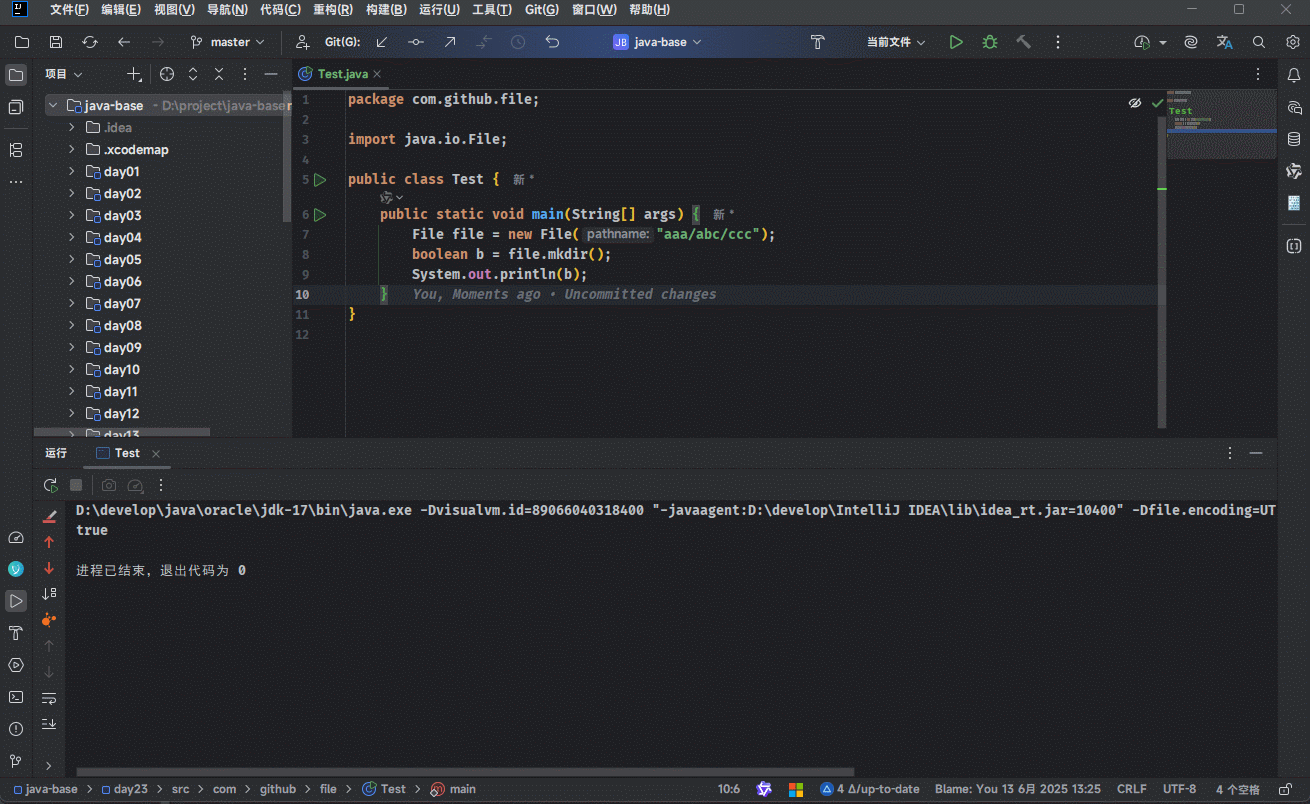
- 示例:mkdirs() 可以创建多级文件夹
java
package com.github.file;
import java.io.File;
public class Test {
public static void main(String[] args) {
File file = new File("aaa/abc/ccc");
boolean b = file.mkdirs();
System.out.println(b);
}
}1
2
3
4
5
6
7
8
9
10
11
2
3
4
5
6
7
8
9
10
11
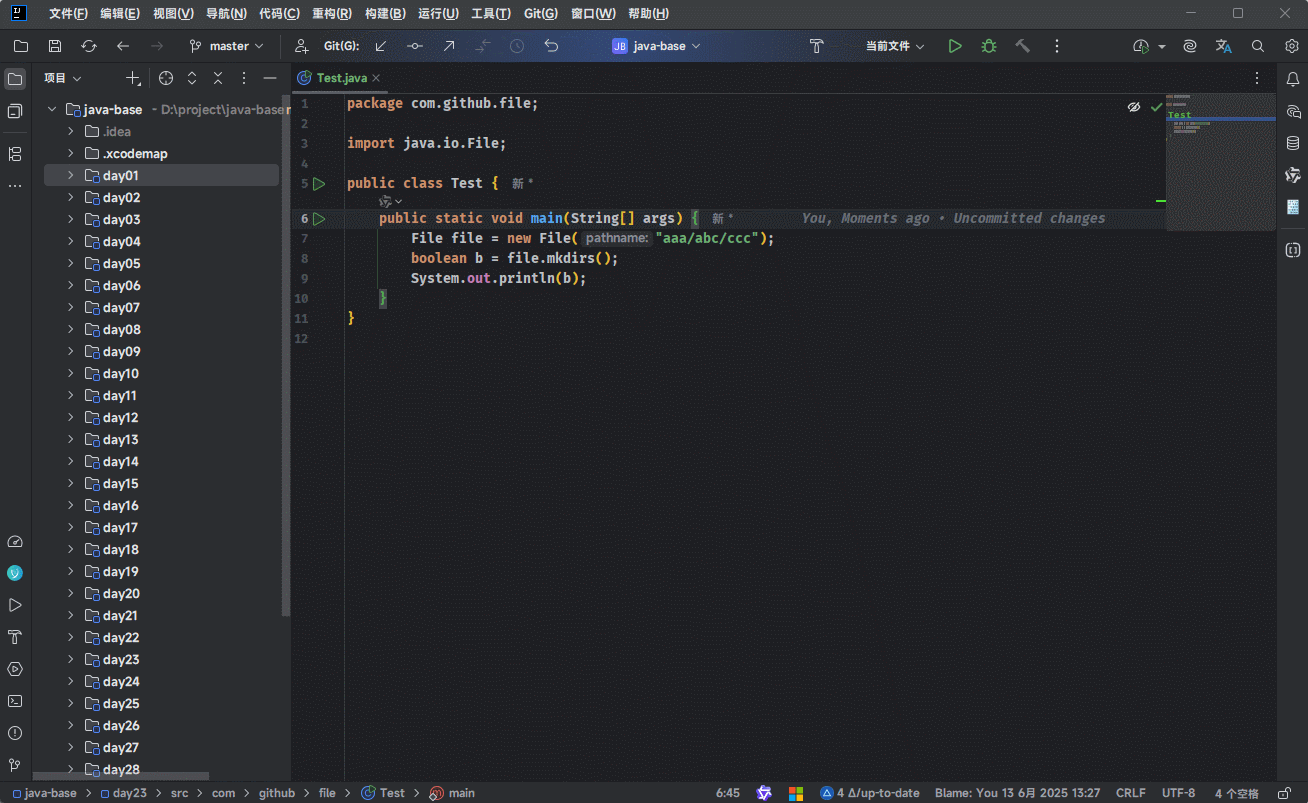
2.3.4 删除系列
- 删除文件(空文件夹):
java
public boolean delete() {}1
注意
- ① delete 方法默认只能删除文件和空文件夹!!!
- ② delete 方法是直接删除,并不走回收站!!!
- ③ 如果想实现删除文件夹,需要从最里面的文件夹一层一层向外删除子文件夹中的所有内容,最后再删除自己(递归)!!!
- 示例:删除文件
java
package com.github.file;
import java.io.File;
import java.io.IOException;
public class Test {
public static void main(String[] args) throws IOException {
File file = new File("aaa");
boolean b = file.delete();
System.out.println(b);
}
}1
2
3
4
5
6
7
8
9
10
11
12
2
3
4
5
6
7
8
9
10
11
12
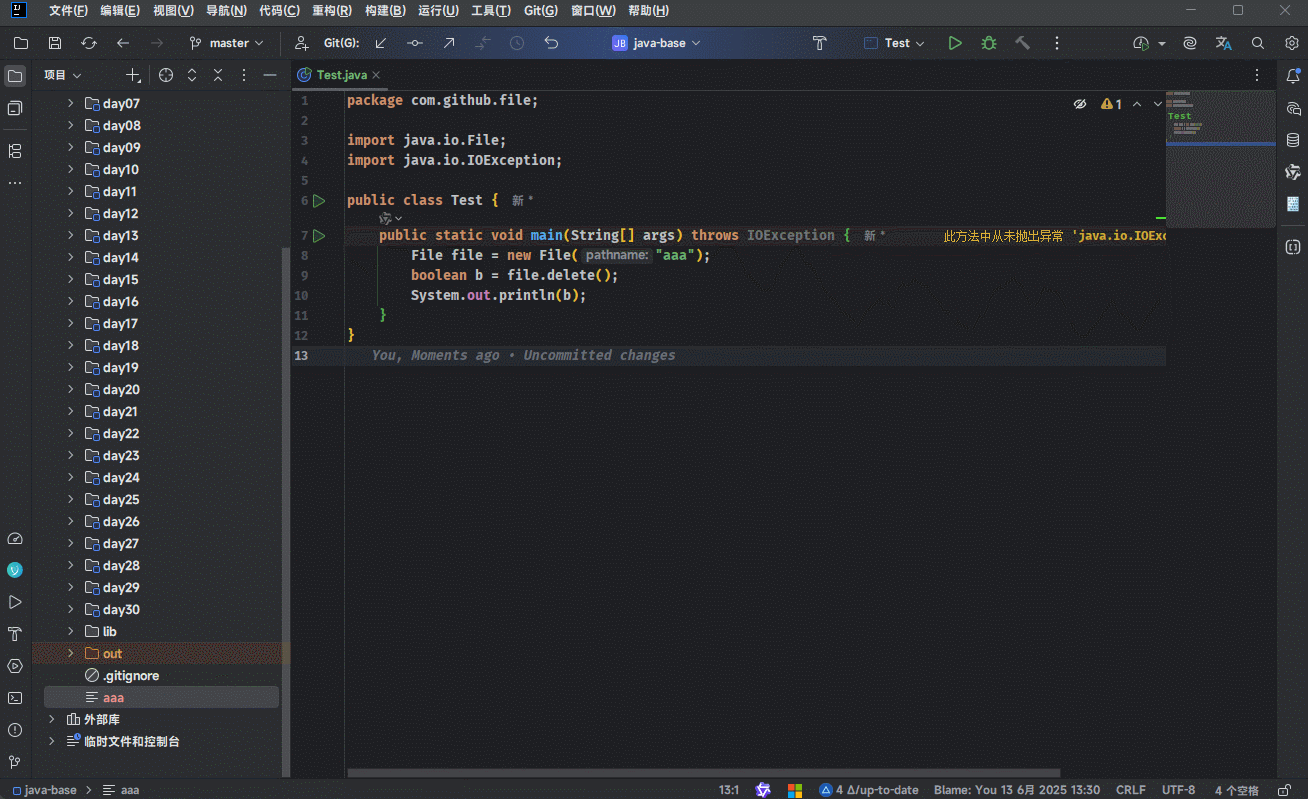
- 示例:删除空目录
java
package com.github.file;
import java.io.File;
import java.io.IOException;
public class Test {
public static void main(String[] args) throws IOException {
File file = new File("abc/bca/ccc");
boolean b = file.delete();
System.out.println(b);
}
}1
2
3
4
5
6
7
8
9
10
11
12
2
3
4
5
6
7
8
9
10
11
12

- 示例:不能删除有内容的文件夹
java
package com.github.file;
import java.io.File;
import java.io.IOException;
public class Test {
public static void main(String[] args) throws IOException {
File file = new File("abc");
boolean b = file.delete();
System.out.println(b);
}
}1
2
3
4
5
6
7
8
9
10
11
12
2
3
4
5
6
7
8
9
10
11
12
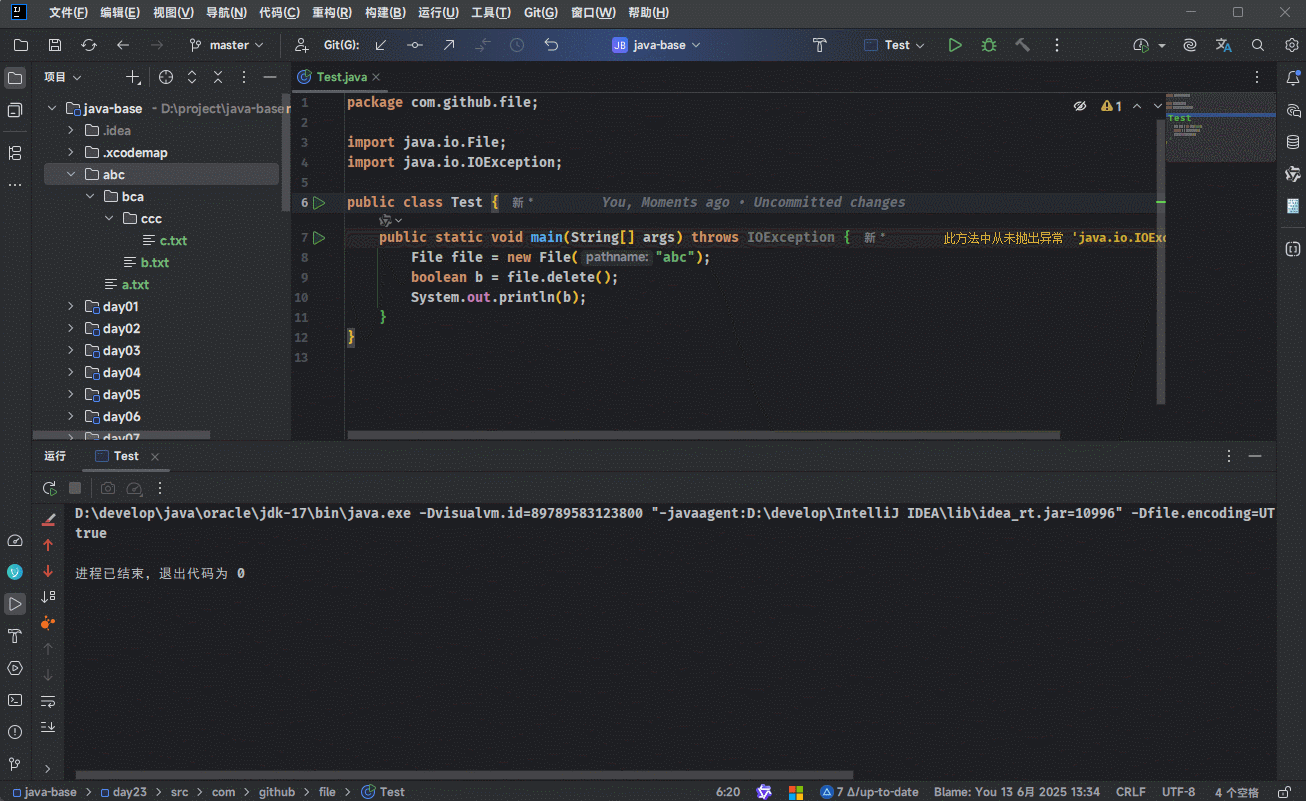
2.3.5 获取并遍历系列
- 获取当前路径下的所有内容(文件和文件夹):
java
public File[] listFiles() {}1
注意
- 细节:
- 当调用者 File 表示的路径不存在时,返回 null。
- 当调用者 File 表示的路径是文件时,返回 null。
- 当调用者 FIle 表示的路径是一个空文件时,返回一个长度为 0 的数组。
- 当调用者 File 表示的路径是一个有内容的文件夹时,将里面所有文件(包含隐藏文件)和文件夹的路径放在 File 数组中并返回。
- 当调用者 File 表示的路径需要访问权限时,返回 null。
- 解决 null 问题(空指针异常):直接调用
Objects.requireNonNullElse(files, new File[0])方法,即:如果 files 返回 null ,就转换为一个长度为 0 的数组。
- 示例:
java
package com.github.file;
import java.io.File;
import java.io.IOException;
public class Test {
public static void main(String[] args) throws IOException {
File file = new File("abc");
boolean b = file.delete();
System.out.println(b);
}
}1
2
3
4
5
6
7
8
9
10
11
12
2
3
4
5
6
7
8
9
10
11
12
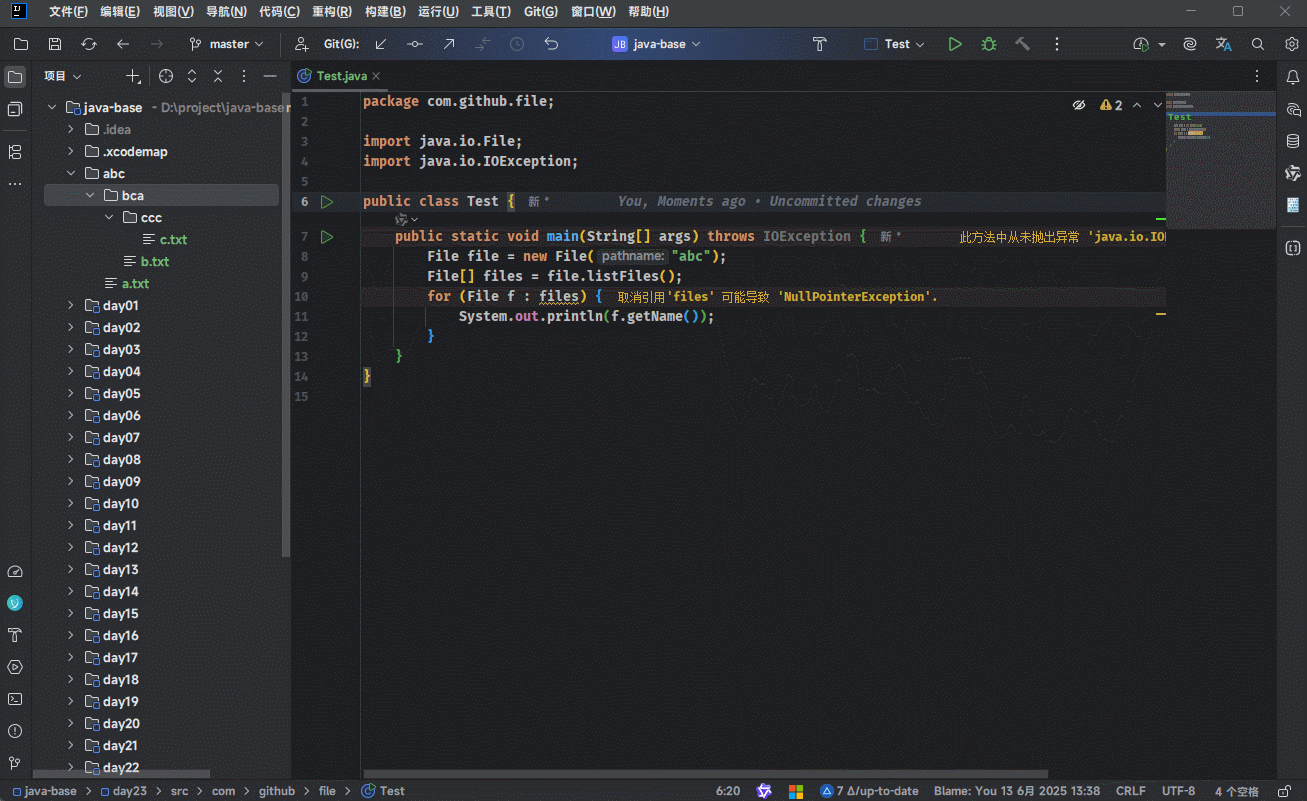
- 示例:
java
package com.github.file;
import java.io.File;
import java.io.IOException;
import java.util.Objects;
public class Test {
public static void main(String[] args) throws IOException {
File file = new File("abc");
File[] files = file.listFiles();
for (File f : Objects.requireNonNullElse(files, new File[0])) {
System.out.println(f.getName());
}
}
}1
2
3
4
5
6
7
8
9
10
11
12
13
14
15
2
3
4
5
6
7
8
9
10
11
12
13
14
15
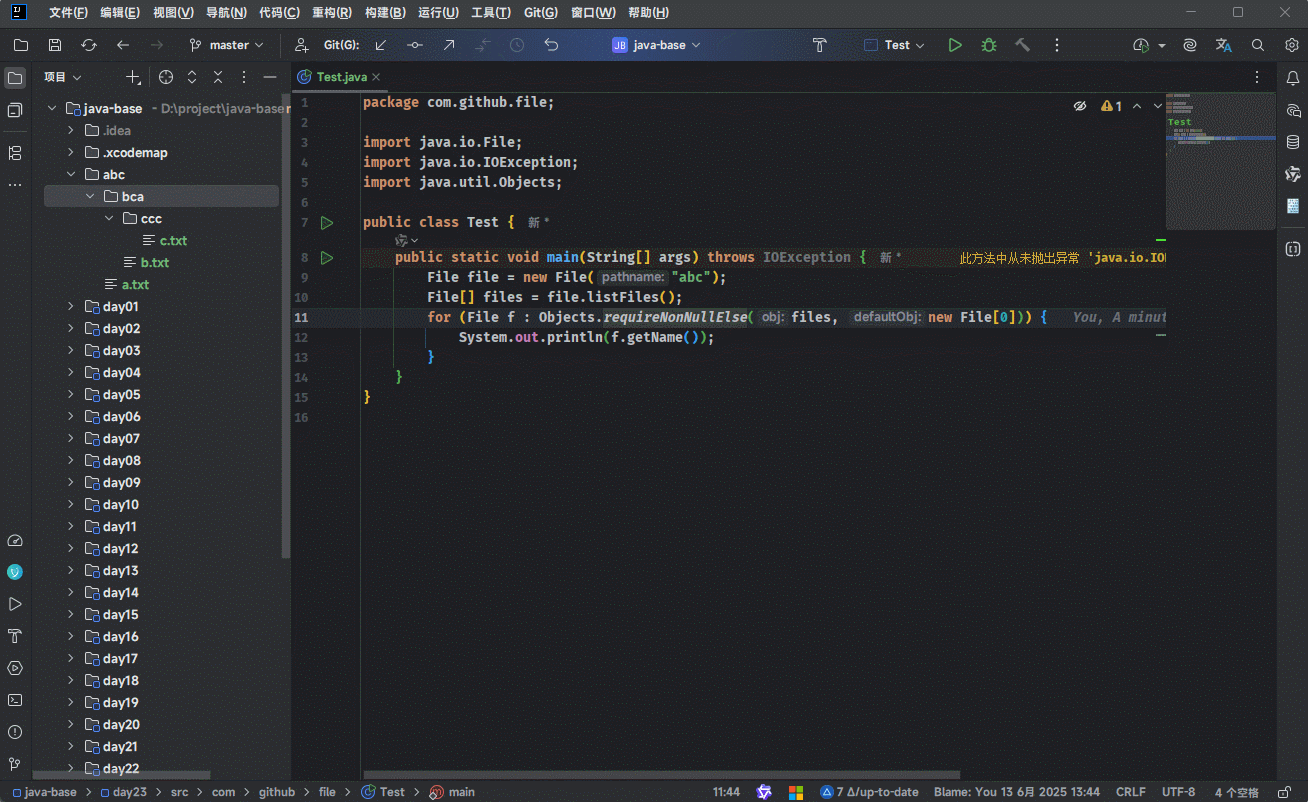
2.3.6 所有获取并遍历系列
- 列出可用的文件系统根:
java
public static File[] listRoots() {}1
提醒
- 对于 Windows 系统而言,所谓的文件系统根,就是盘符,如:C 盘、D 盘、E 盘等(有几个盘符就有几个文件系统根)。
- 对于 Linux 系统而言,所谓的文件系统根,就是
/。
- 获取当前路径下所有内容(文件和文件夹)的名称(不常用):
java
public String[] list() {}1
- 利用文件名过滤器获取当前路径下所有内容(文件和文件夹)的名称(不常用):
java
public String[] list(FilenameFilter filter) {}1
- 获取当前路径下所有内容(文件和文件夹,常用):
java
public File[] listFiles() {}1
- 利用文件过滤器获取当前路径下所有内容(文件和文件夹,常用):
java
public File[] listFiles(FileFilter filter) {}1
- 利用文件过滤名获取当前路径下所有内容(文件和文件夹,常用):
java
public File[] listFiles(FilenameFilter filter) {}1
- 示例:
java
package com.github.file;
import java.io.File;
import java.io.IOException;
public class Test {
public static void main(String[] args) throws IOException {
final File[] files = File.listRoots();
for (File file : files) {
System.out.println(file.getPath());
}
}
}1
2
3
4
5
6
7
8
9
10
11
12
13
2
3
4
5
6
7
8
9
10
11
12
13
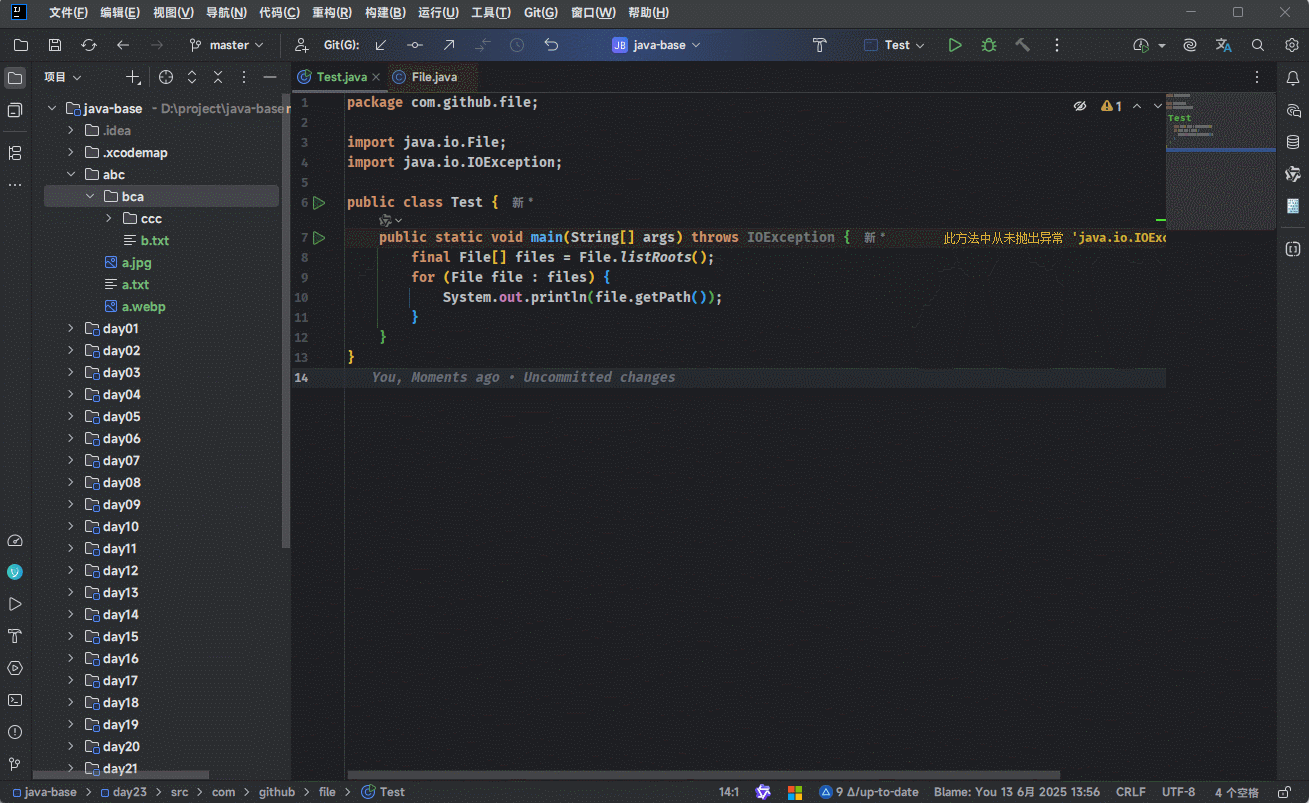
- 示例:
java
package com.github.file;
import java.io.File;
import java.io.IOException;
import java.util.Objects;
public class Test {
public static void main(String[] args) throws IOException {
File file = new File("abc");
File[] files = file.listFiles(f -> f
.getName()
.endsWith(".jpg"));
for (File f : Objects.requireNonNullElse(files, new File[0])) {
System.out.println(f);
}
}
}1
2
3
4
5
6
7
8
9
10
11
12
13
14
15
16
17
18
2
3
4
5
6
7
8
9
10
11
12
13
14
15
16
17
18

2.4 综合练习
2.4.1 综合练习一
需求:在当前项目中的 aaa 文件夹下创建一个 a.txt 的文件。
示例:
java
package com.github.file;
import java.io.File;
import java.io.IOException;
public class Test {
public static void main(String[] args) throws IOException {
File file = new File("aaa/a.txt");
boolean newFile = file.createNewFile();
System.out.println(newFile ? "创建成功" : "创建失败");
}
}1
2
3
4
5
6
7
8
9
10
11
12
2
3
4
5
6
7
8
9
10
11
12
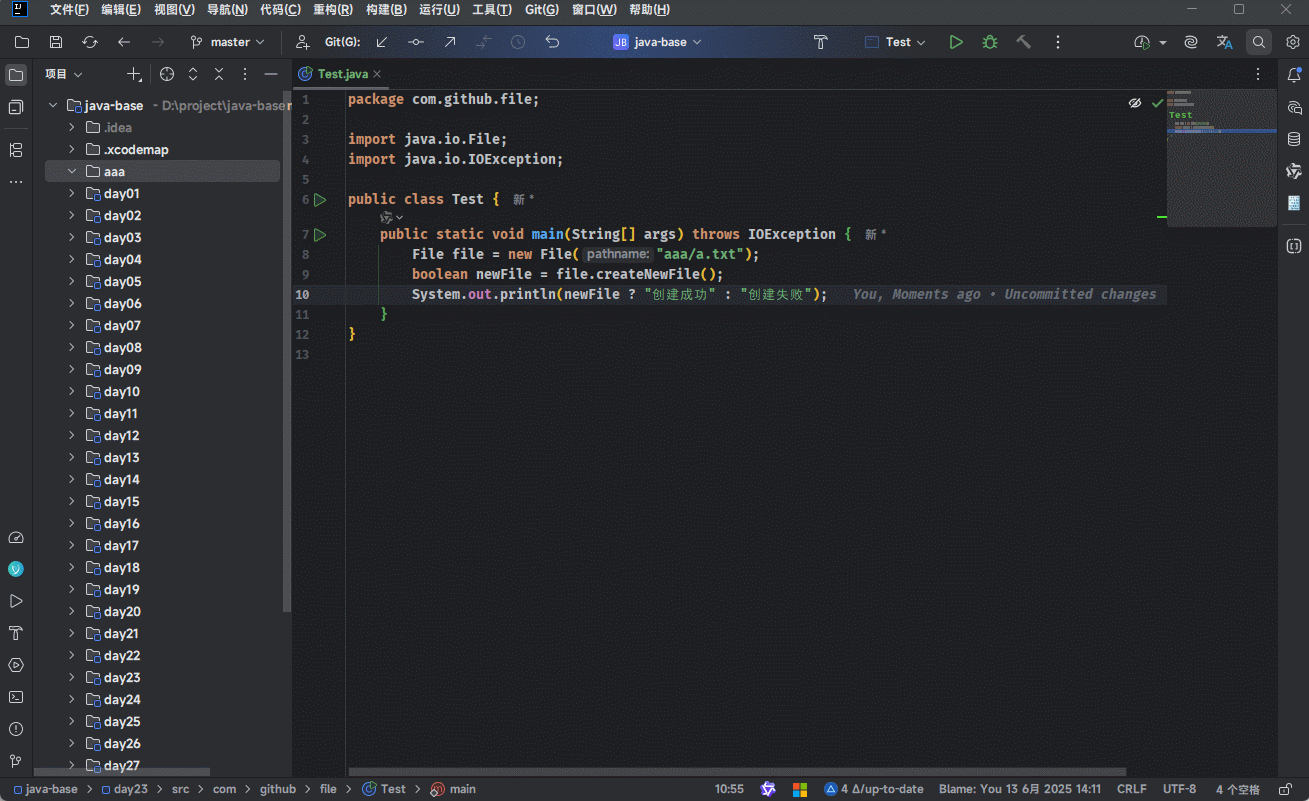
2.4.2 综合练习二
- 需求:定义一个方法,用于寻找某一个文件夹中,是否有以 avi 结尾的小电影。
提醒
暂时不需要考虑子文件夹,即:
- 示例:
java
package com.github.file;
import java.io.File;
import java.io.IOException;
import java.util.Objects;
public class Test {
public static void main(String[] args) throws IOException {
File file = new File("aaa/ccc");
System.out.println(isExistAVI(file) ? "存在" : "不存在");
}
public static boolean isExistAVI(File src) {
// 判断参数
if (null == src || !src.exists() || src.isFile()) {
return false;
}
// 获取当前路径下的所有内容
File[] files = src.listFiles();
// 遍历数组
for (File file : Objects.requireNonNullElse(files, new File[0])) {
if (file.isFile() && file.getName().endsWith(".avi")) {
return true;
}
}
return false;
}
}1
2
3
4
5
6
7
8
9
10
11
12
13
14
15
16
17
18
19
20
21
22
23
24
25
26
27
28
2
3
4
5
6
7
8
9
10
11
12
13
14
15
16
17
18
19
20
21
22
23
24
25
26
27
28
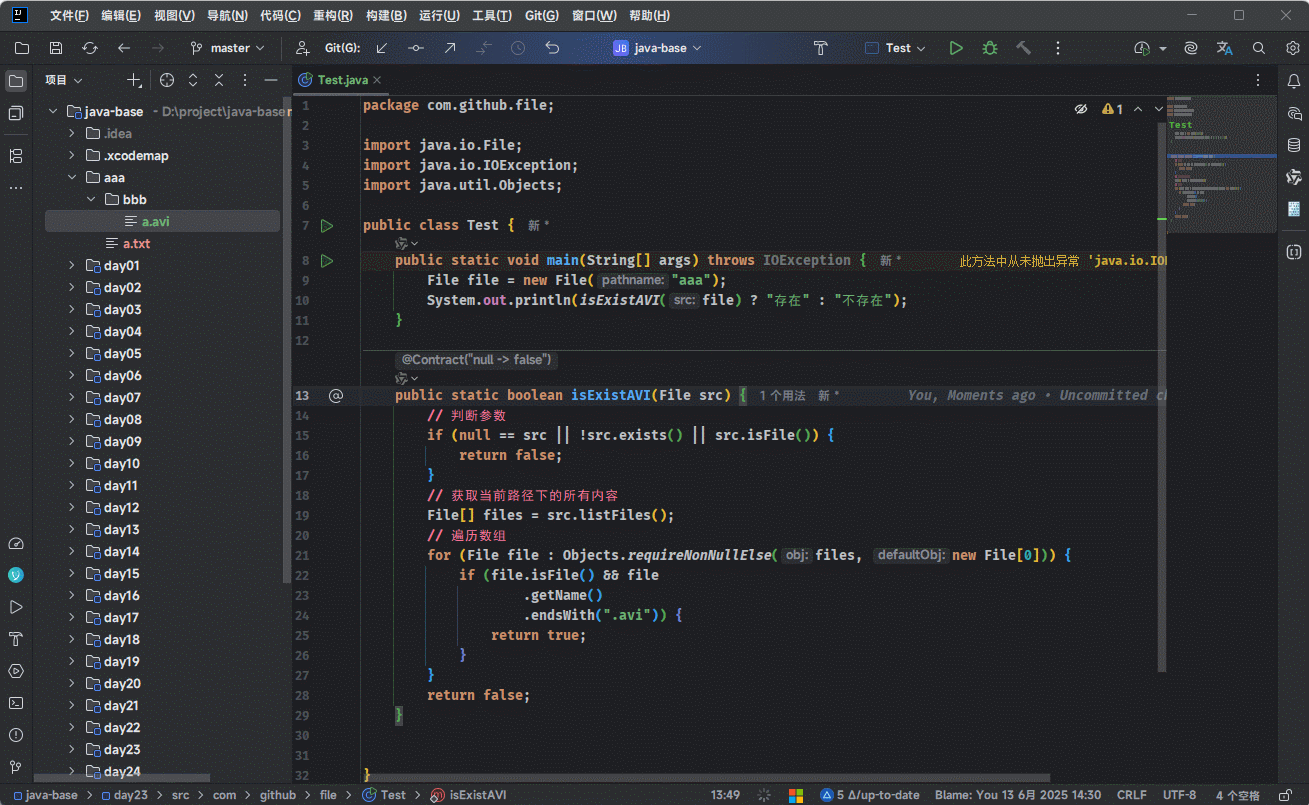
2.4.3 综合练习三
- 需求:定义一个方法,用于寻找某一个文件夹中,所有以 avi 结尾的小电影。
提醒
需要考虑子文件夹,即:
- 示例:
java
package com.github.file;
import java.io.File;
import java.io.IOException;
import java.util.ArrayList;
import java.util.List;
import java.util.Objects;
public class Test {
public static void main(String[] args) throws IOException {
File file = new File("aaa");
System.out.println(findAVI(file).size());
}
public static List<File> findAVI(File src) {
List<File> resultList = new ArrayList<>();
// 判断参数
if (null == src || !src.exists() || src.isFile()) {
return resultList;
}
// 获取当前路径下的所有内容
File[] files = src.listFiles();
// 遍历数组
for (File file : Objects.requireNonNullElse(files, new File[0])) {
// 如果是文件,并且是 avi 文件,则添加到结果列表中
if (file.isFile() && file.getName().endsWith(".avi")) {
resultList.add(file);
} else {
// 如果是文件夹,则递归调用 findAVI 方法
// 再次调用本方法的时候,参数一定是 src 的次一级路径,即:file
resultList.addAll(findAVI(file));
}
}
return resultList;
}
}1
2
3
4
5
6
7
8
9
10
11
12
13
14
15
16
17
18
19
20
21
22
23
24
25
26
27
28
29
30
31
32
33
34
35
36
2
3
4
5
6
7
8
9
10
11
12
13
14
15
16
17
18
19
20
21
22
23
24
25
26
27
28
29
30
31
32
33
34
35
36
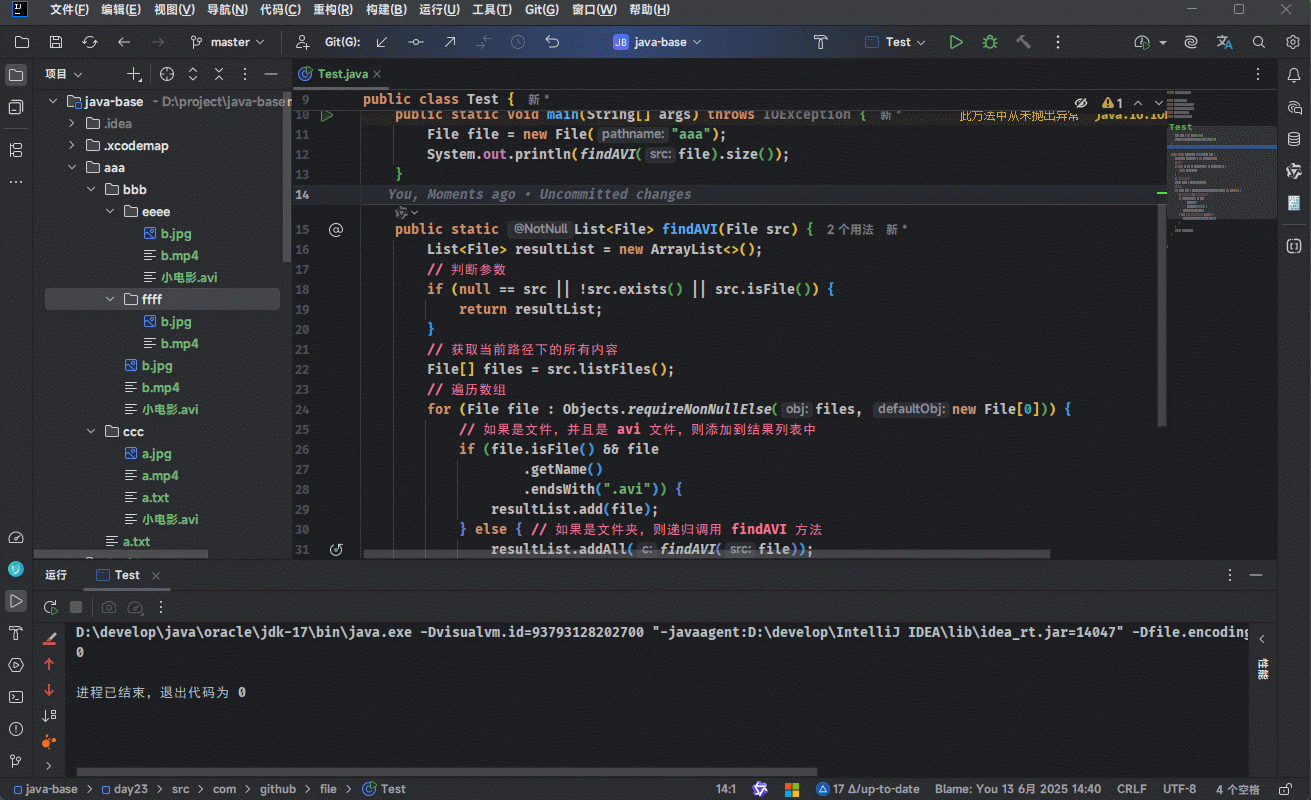
2.4.4 综合练习四
- 需求:定义一个方法,删除一个多级文件夹。
提醒
需要使用递归来实现!!!
- 示例:
java
package com.github.file;
import java.io.File;
import java.io.IOException;
import java.util.Objects;
public class Test {
public static void main(String[] args) throws IOException {
File file = new File("aaa/bbb/eeee");
remove(file);
}
public static void remove(File src) {
// 判断参数
if (null == src || !src.exists() || src.isFile()) {
return;
}
// 获取当前路径下的所有内容
File[] files = src.listFiles();
// 遍历数组
for (File file : Objects.requireNonNullElse(files, new File[0])) {
// 如果是文件,就删除
if (file.isFile()) {
System.out.println(file.getPath());
file.delete();
} else { // 如果是文件夹,则递归调用 findAVI 方法
remove(file);
}
}
// 最后需要删除自己
src.delete();
}
}1
2
3
4
5
6
7
8
9
10
11
12
13
14
15
16
17
18
19
20
21
22
23
24
25
26
27
28
29
30
31
32
33
2
3
4
5
6
7
8
9
10
11
12
13
14
15
16
17
18
19
20
21
22
23
24
25
26
27
28
29
30
31
32
33
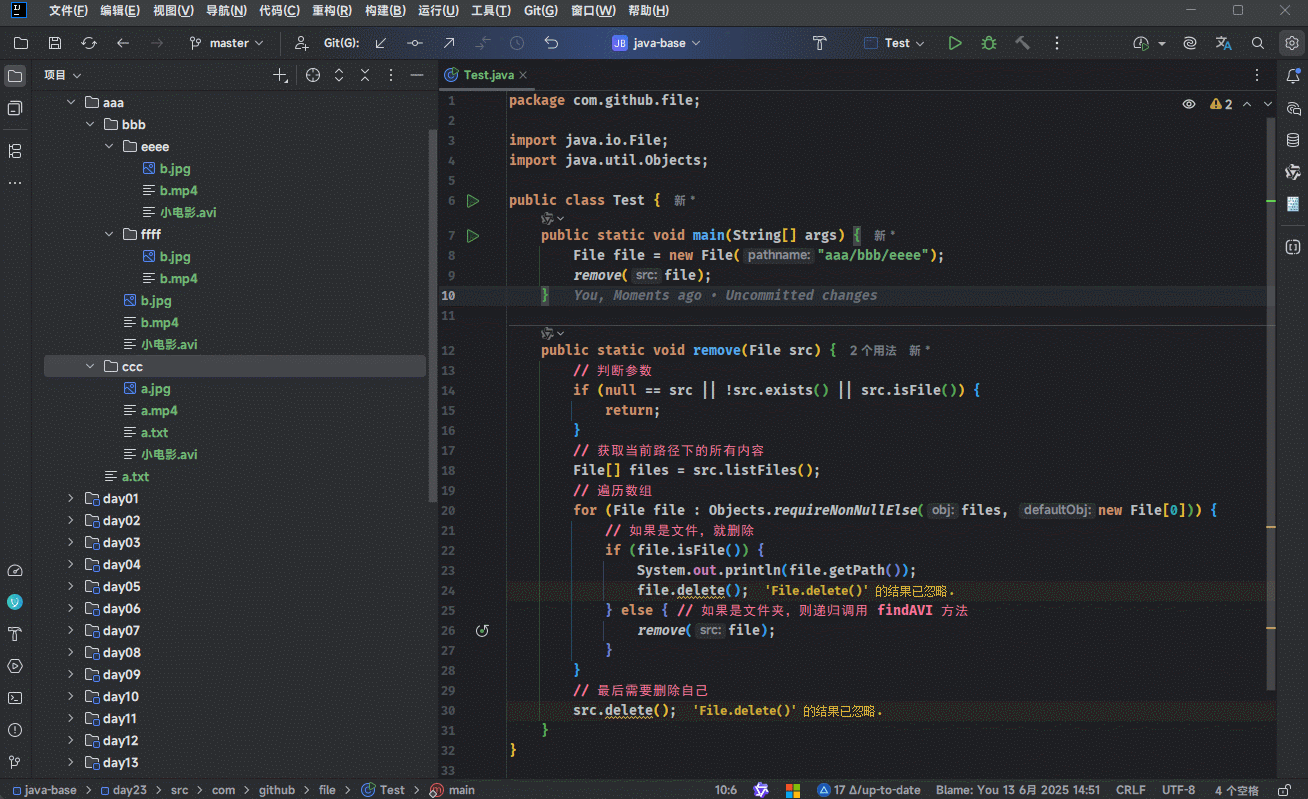
2.4.5 综合练习五
- 需求:统计一个文件夹中每种文件的个数并打印。
提醒
需要使用递归来实现!!!
- 示例:
java
package com.github.collection3;
import java.io.File;
import java.util.HashMap;
import java.util.Map;
import java.util.Objects;
public class Test {
public static void main(String[] args) {
File src = new File("D:\\src");
long total = getLen(src);
System.out.println("文件大小为: " + total);
Map<String, Long> map = analyze(src);
map.forEach((k, v) -> System.out.println(k + ": " + v));
}
public static Long getLen(File src) {
Long total = 0L;
File[] files = src.listFiles();
for (File file : Objects.requireNonNullElse(files, new File[0])) {
if (file.isFile()) {
total += file.length();
} else {
total += getLen(file);
}
}
return total;
}
public static Map<String, Long> analyze(File src) {
Map<String, Long> map = new HashMap<>();
File[] files = src.listFiles();
for (File file : Objects.requireNonNullElse(files, new File[0])) {
if (file.isFile()) {
String name = file.getName();
String suffix = name.substring(name.lastIndexOf(".") + 1);
map.merge(suffix, 1L, Long::sum);
} else {
Map<String, Long> map2 = analyze(file);
map2.forEach((key, value) -> map.merge(key, value, Long::sum));
}
}
return map;
}
}1
2
3
4
5
6
7
8
9
10
11
12
13
14
15
16
17
18
19
20
21
22
23
24
25
26
27
28
29
30
31
32
33
34
35
36
37
38
39
40
41
42
43
44
45
46
47
48
49
2
3
4
5
6
7
8
9
10
11
12
13
14
15
16
17
18
19
20
21
22
23
24
25
26
27
28
29
30
31
32
33
34
35
36
37
38
39
40
41
42
43
44
45
46
47
48
49
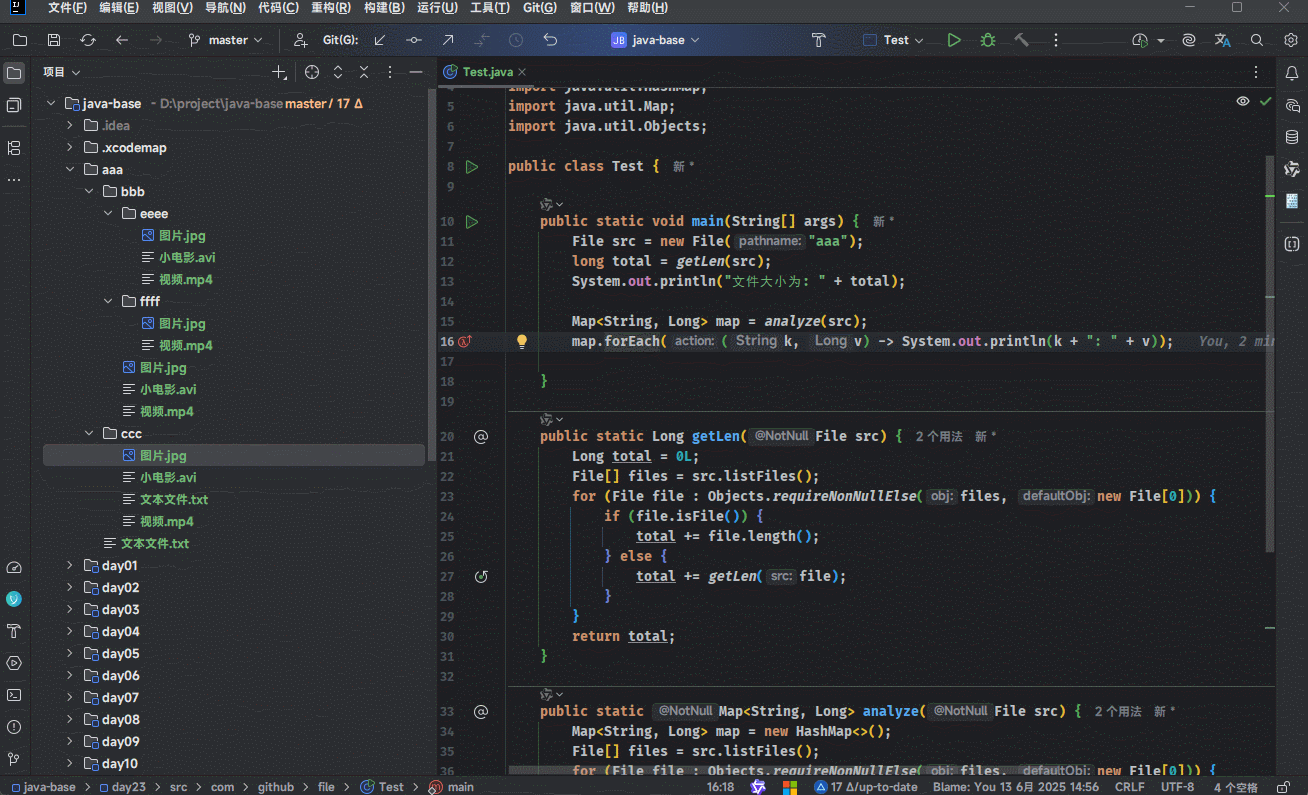
第三章:IO 流(⭐)
3.1 概述
3.1.1 简介
- I/O 是 Input 和 Output 的缩写,IO 技术是非常实用的技术,用于
处理设备之间的数据传输,如:读写文件、网络通讯等。
提醒
IO 流是存储数据和读取数据的解决方案!!!
- 因为 IO 流和 File 息息相关;所以,我们有必要先回顾 File 。
3.1.2 File 和 IO 流
- File 是用来表示系统中
文件或者文件夹的路径。我们可以利用 File 完成以下功能:- ① 获取文件信息(大小、文件名、最后修改时间)。
- ② 判断文件的类型(文件还是文件夹)。
- ③ 创建文件或文件夹。
- ④ 删除文件或文件夹。
- ⑤ ....
注意
- File 类只能对文件文本进行操作,并不能读写文件里面存储的数据!!!
- 如果要进行读写数据,必须要使用 IO 流技术。
- IO 流是用来读写文件中的数据(可以读写文件,或网络中的数据...)。
- 其中,IO 流可以将程序中的数据保存(写出)到本地文件中,我们称之为:
写(Output,写出数据)。
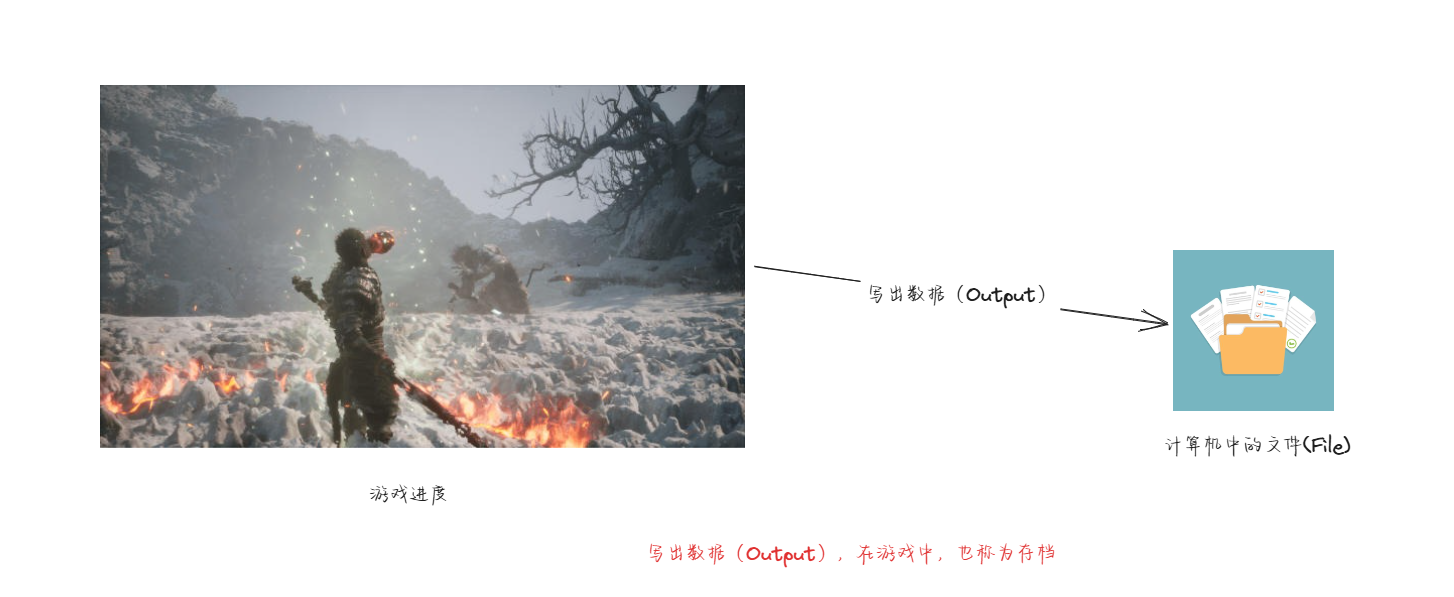
- 其中,IO 流可以将本地文件中的数据读取(加载)到程序中,我们称之为:
读(Input,读取数据)。
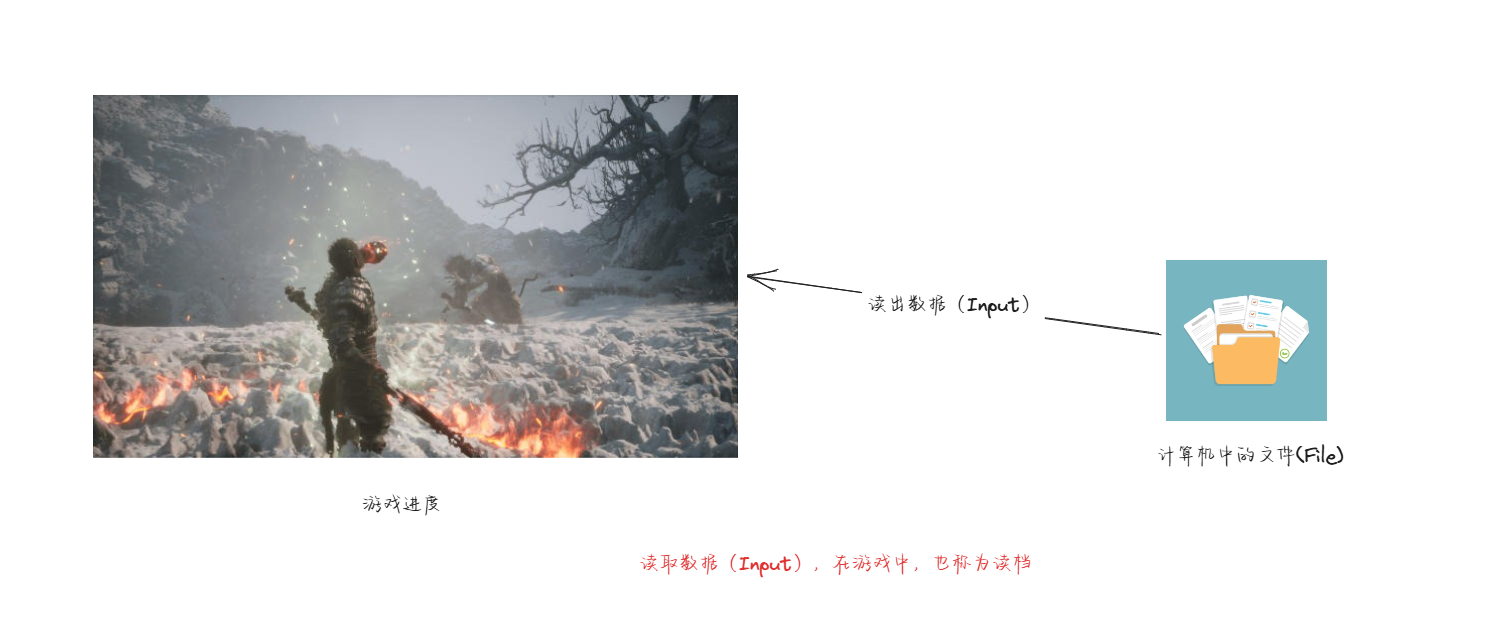
- 在 IO 流中,是以
程序作为参照物来看读写的方向的。
提醒
- ① 是程序在读取文件中的数据,也是程序在向文件中写出数据。
- ② 因为程序是运行在内存中,所以也可以将
内存作为参照物来看读写的方向的。
3.1.3 IO 流分类
- 在 Java 中,IO 流有很多很多种(BIO,Blocking I/O,阻塞式 I/O),如下所示:
提醒
在 Java 中,IO 流的模型分为以下几种:
| 名称 | 全称 | 中文含义 | 模型类型 |
|---|---|---|---|
| BIO | Blocking I/O | 阻塞式 I/O | 同步阻塞 |
| NIO | Non-blocking I/O | 非阻塞 I/O | 同步非阻塞 |
| AIO | Asynchronous I/O | 异步 I/O | 异步非阻塞 |
目前,我们学习的是 BIO,即:阻塞式 I/O,至于什么是阻塞式 I/O,在多线程和网络编程那边讲解!!!
txt
├─📄 Bits.java
├─📄 BufferedInputStream.java
├─📄 BufferedOutputStream.java
├─📄 BufferedReader.java
├─📄 BufferedWriter.java
├─📄 ByteArrayInputStream.java
├─📄 ByteArrayOutputStream.java
├─📄 CharArrayReader.java
├─📄 CharArrayWriter.java
├─📄 CharConversionException.java
...
├─📄 DataOutput.java
├─📄 DataOutputStream.java
├─📄 DefaultFileSystem.java
├─📄 DeleteOnExitHook.java
├─📄 EOFException.java
├─📄 ExpiringCache.java
├─📄 Externalizable.java
...
├─📄 FileCleanable.java
├─📄 FileDescriptor.java
├─📄 FileFilter.java
├─📄 FileInputStream.java
├─📄 FilenameFilter.java
├─📄 FileNotFoundException.java
├─📄 FileOutputStream.java
...1
2
3
4
5
6
7
8
9
10
11
12
13
14
15
16
17
18
19
20
21
22
23
24
25
26
27
2
3
4
5
6
7
8
9
10
11
12
13
14
15
16
17
18
19
20
21
22
23
24
25
26
27
提醒
为了更好的学习 IO 流,我们有必要先对它们进行分类,即:先有一个整体的认识,再一个个的学习。
- 根据
流的方向,我们可以将 IO 流,做如下的分类:
- 根据
操作文件的类型,我们可以将 IO 流,做如下的分类:
提醒
- ① 字节流可以操作所有类型的文件,包括:图片文件、文本文件、音频文件以及视频文件等等。
- ② 字符流可以操作文本类型的文件。
- 对于纯文本文件,最简单的判断方式:使用 Windows 自带的记事本软件。
提醒
- ① 如果某个文件,Windows 自带的记事本软件能打开,显示出来不乱码,就是纯文本文件。
- ② 如果某个文件,Windows 自带的记事本软件能打开;但是,显示出来乱码,就不是纯文本文件。
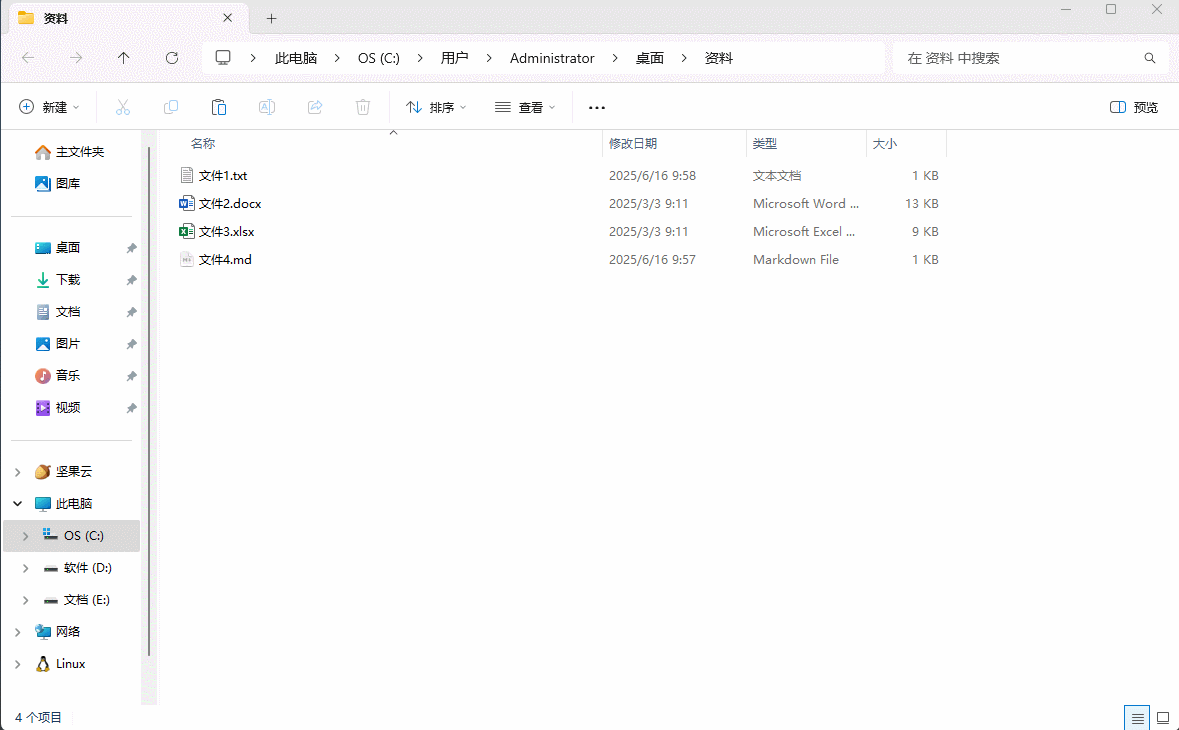
*.txt和*.md才是文本文本3.2 IO 流体系
- IO 流按照
操作文件的类型进行分类,可以分为字节流和字符流:
- 以
字节流为例,按照流的方向进行分类,可以分为字节输入流和字节输出流:
- 以
字符流为例,按照流的方向进行分类,可以分为字符输入流和字符输出流:
- 但是,InputStream、OutputStream、Reader 以及 Writer 都是抽象类,是不能实例化的:
提醒
java
public abstract class InputStream implements Closeable {}1
java
public abstract class OutputStream implements Closeable, Flushable {}1
java
public abstract class Reader implements Readable, Closeable {}1
java
public abstract class Writer implements Appendable, Closeable, Flushable {}1
提醒
为了创建流的实例(对象),我们还需要它们的子类!!!
- 以字节输入流(InputStream)为例,其子类是 FileInputStream,如下所示:
- 以字节输出流(OutputStream)为例,其子类是 FileOutputStream,如下所示:
- 同理,字符输入流(Reader)和字符输出流(Writer)的继承体系就是这样,如下所示:
第四章:基本字节流(⭐)
4.1 概述
- 基本字节流有两种:FileOutputStream 和 FileInputStream。
4.2 FileOutputStream
4.2.1 概述
- FileOutputStream 是操作本地文件的字节输出流,可以将程序中的数据写出到本地文件中。
4.2.2 操作步骤
- ① 创建字节输出流对象。
java
public class FileOutputStream extends OutputStream {
public FileOutputStream(String name) throws FileNotFoundException {
...
}
...
}1
2
3
4
5
6
7
8
2
3
4
5
6
7
8
- ② 写数据。
java
public class FileOutputStream extends OutputStream {
public void write(int b) throws IOException {
...
}
...
}1
2
3
4
5
6
7
8
2
3
4
5
6
7
8
- ③ 释放资源。
java
public class FileOutputStream extends OutputStream {
public void close() throws IOException {
...
}
...
}1
2
3
4
5
6
7
8
2
3
4
5
6
7
8
提醒
- ① 暂时不要写中文,至于原因,后文再解释!!!
- ② Java 中提供了获取字符的 Unicode 编码的方法,以十进制数字返回:
java
public final class Character
implements java.io.Serializable, Comparable<Character>, Constable {
public static int codePointAt(CharSequence seq, int index) {
...
}
...
}1
2
3
4
5
6
7
8
2
3
4
5
6
7
8
- 示例:
java
package com.github.file;
import java.io.FileOutputStream;
import java.io.IOException;
import java.io.OutputStream;
public class Test {
public static void main(String[] args) throws IOException {
// 创建输出流对象(并指定文件的路径)
OutputStream os = new FileOutputStream("day23\\a.txt");
// 写出数据
os.write(Character.codePointAt("a", 0));
// 释放资源
os.close();
}
}1
2
3
4
5
6
7
8
9
10
11
12
13
14
15
16
2
3
4
5
6
7
8
9
10
11
12
13
14
15
16
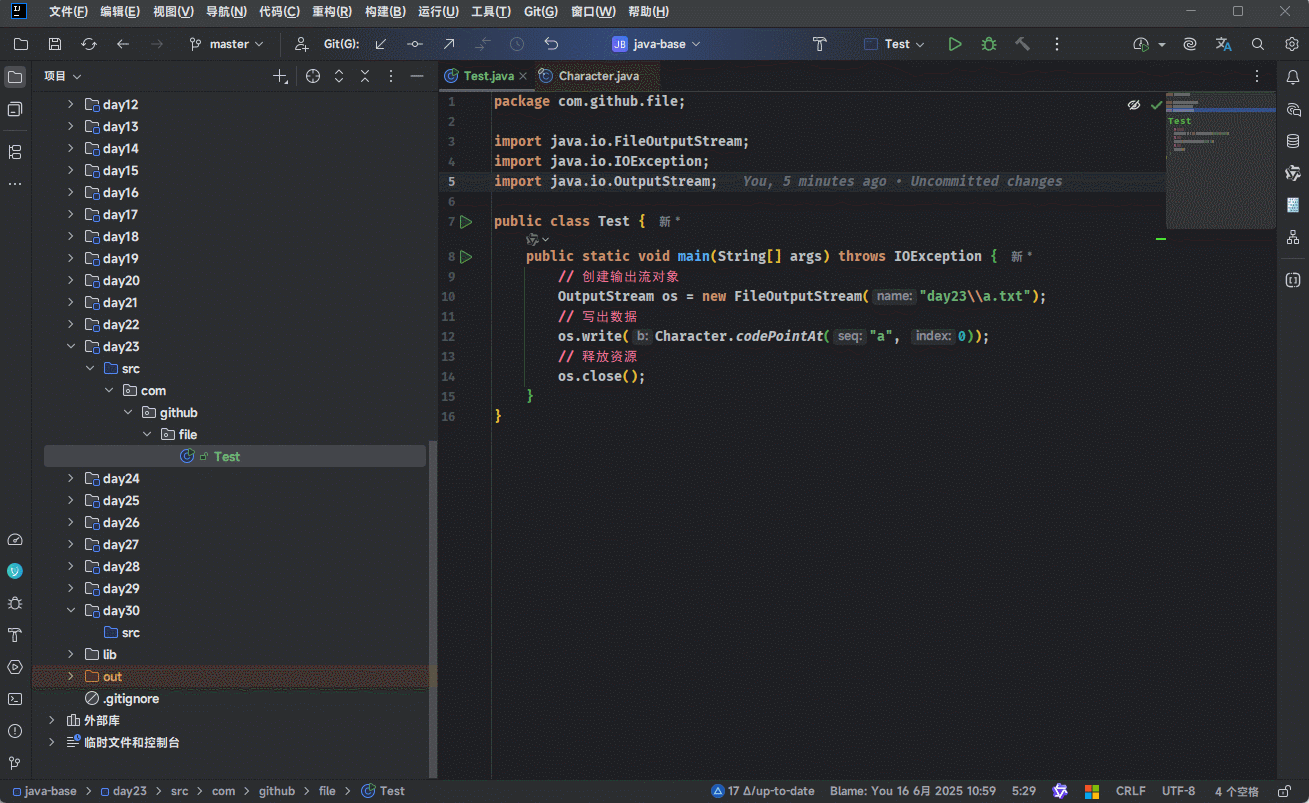
4.2.3 原理
- 电脑硬盘中的的文件非常多,我们的程序是如何知道向那个文件中写入数据的?
- 其实,当我们创建 FileOutputStream 对象的时候,如下所示:
java
OutputStream os = new FileOutputStream("day23\\a.txt");1
- Java 程序会根据我们书写的文件路径,和硬盘上的指定文件建立了一个传输数据的通道:
- 当我们调用 write 方法写出数据的时候,如下所示:
java
os.write(Character.codePointAt("a", 0));1
- 其实就相当于数据在这个通道中进行传输:
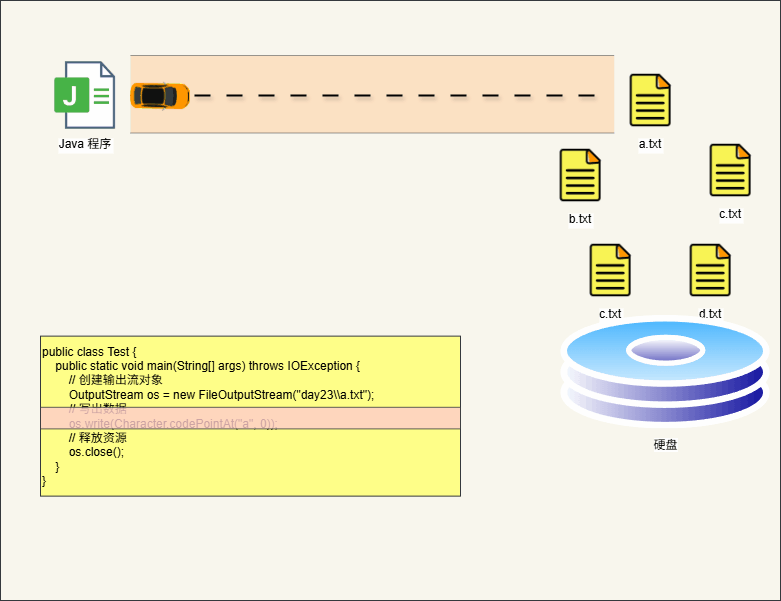
- 当我们调用 close 方法的时候进行资源释放,如下所示:
java
os.close();1
- 其实,就相当于将这个通道给砸碎:

4.2.4 细节
4.2.4.1 创建字节输出流对象的细节
- ① 参数是字符串表示的路径或者 File 对象都是可以的。
FileOutputStream.java
java
public class FileOutputStream extends OutputStream {
/**
* 如果是字符串表示的路径,底层依然会帮你转换为 File 对象
*/
public FileOutputStream(String name) throws FileNotFoundException {
this(name != null ? new File(name) : null, false);
}
public FileOutputStream(File file) throws FileNotFoundException {
this(file, false);
}
...
}1
2
3
4
5
6
7
8
9
10
11
12
13
14
15
16
2
3
4
5
6
7
8
9
10
11
12
13
14
15
16
- ② 如果文件不存在会创建一个新文件;但是,需要确保父级路径是存在的。
java
package com.github.file;
import java.io.FileOutputStream;
import java.io.IOException;
import java.io.OutputStream;
public class Test {
public static void main(String[] args) throws IOException {
// 创建输出流对象(如果文件不存在会创建一个新文件)
OutputStream os = new FileOutputStream("day23\\a.txt");
// 写出数据
os.write(Character.codePointAt("a", 0));
// 释放资源
os.close();
}
}1
2
3
4
5
6
7
8
9
10
11
12
13
14
15
16
2
3
4
5
6
7
8
9
10
11
12
13
14
15
16

java
package com.github.file;
import java.io.FileOutputStream;
import java.io.IOException;
import java.io.OutputStream;
public class Test {
public static void main(String[] args) throws IOException {
// 创建输出流对象(如果文件不存在会创建一个新文件)
// 但是,如果路径中的父级路径不存在,会抛出异常
OutputStream os = new FileOutputStream("day23\\abc\\a.txt");
// 写出数据
os.write(Character.codePointAt("a", 0));
// 释放资源
os.close();
}
}1
2
3
4
5
6
7
8
9
10
11
12
13
14
15
16
17
2
3
4
5
6
7
8
9
10
11
12
13
14
15
16
17
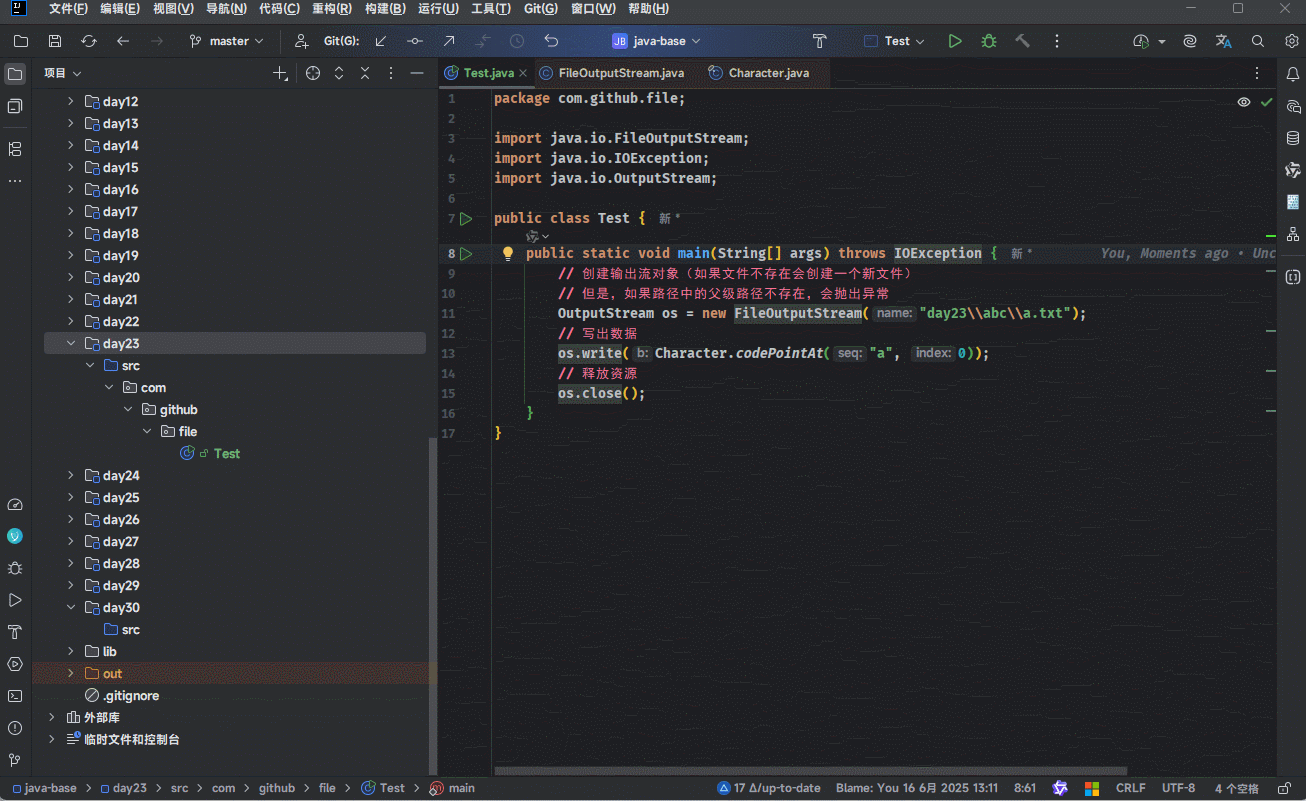
- ③ 如果文件已经存在,则会清空文件,再写入新的数据。
java
package com.github.file;
import java.io.FileOutputStream;
import java.io.IOException;
import java.io.OutputStream;
public class Test {
public static void main(String[] args) throws IOException {
// 如果文件已经存在,则会清空文件,再写入新的数据
OutputStream os = new FileOutputStream("day23\\a.txt");
// 写出数据
os.write(Character.codePointAt("a", 0));
// 释放资源
os.close();
}
}1
2
3
4
5
6
7
8
9
10
11
12
13
14
15
16
2
3
4
5
6
7
8
9
10
11
12
13
14
15
16
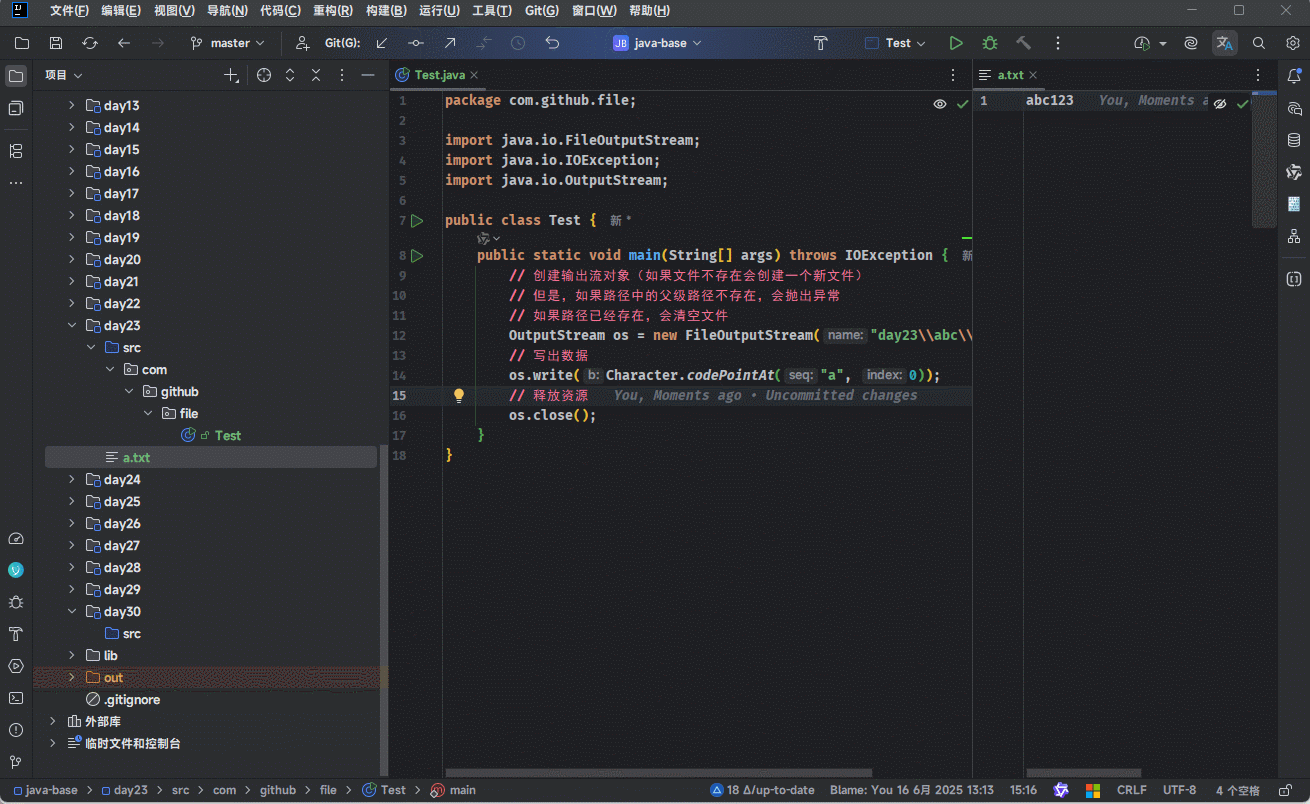
4.2.4.2 写数据的细节
- ① write 方法的参数是整数:
java
public void write(int b) throws IOException {
...
}1
2
3
2
3
- 计算机底层实际上写到本地文件中的是
整数在 ASCII 码表上对应的字符:
提醒
- ①
97对应'a'。 - ②
65对应'A'。 - ③ ...
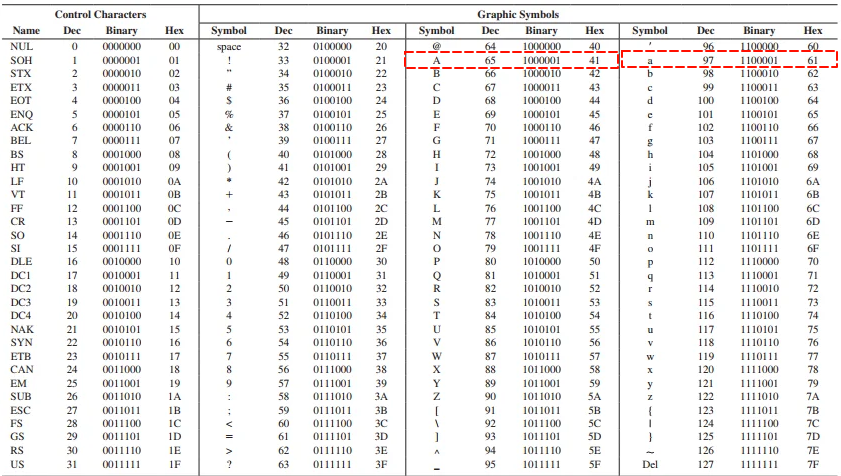
- ② write 方法有三种形式:
| write 格式 | 描述 |
|---|---|
public abstract void write(int b) throws ... {}; | 一次写入一个字节 |
public void write(byte b[]) throws ...{} | 一次写入一个字节数组 |
public void write(byte b[], int off, int len) throws ...{} | 一次写入一个字节数组的一部分 |
java
package com.github.file;
import java.io.FileOutputStream;
import java.io.IOException;
import java.io.OutputStream;
public class Test {
public static void main(String[] args) throws IOException {
// 如果文件已经存在,则会清空文件,再写入新的数据
OutputStream os = new FileOutputStream("day23\\a.txt");
// 写出数据(一次写入一个字节)
os.write(97);
// 释放资源
os.close();
}
}1
2
3
4
5
6
7
8
9
10
11
12
13
14
15
16
2
3
4
5
6
7
8
9
10
11
12
13
14
15
16
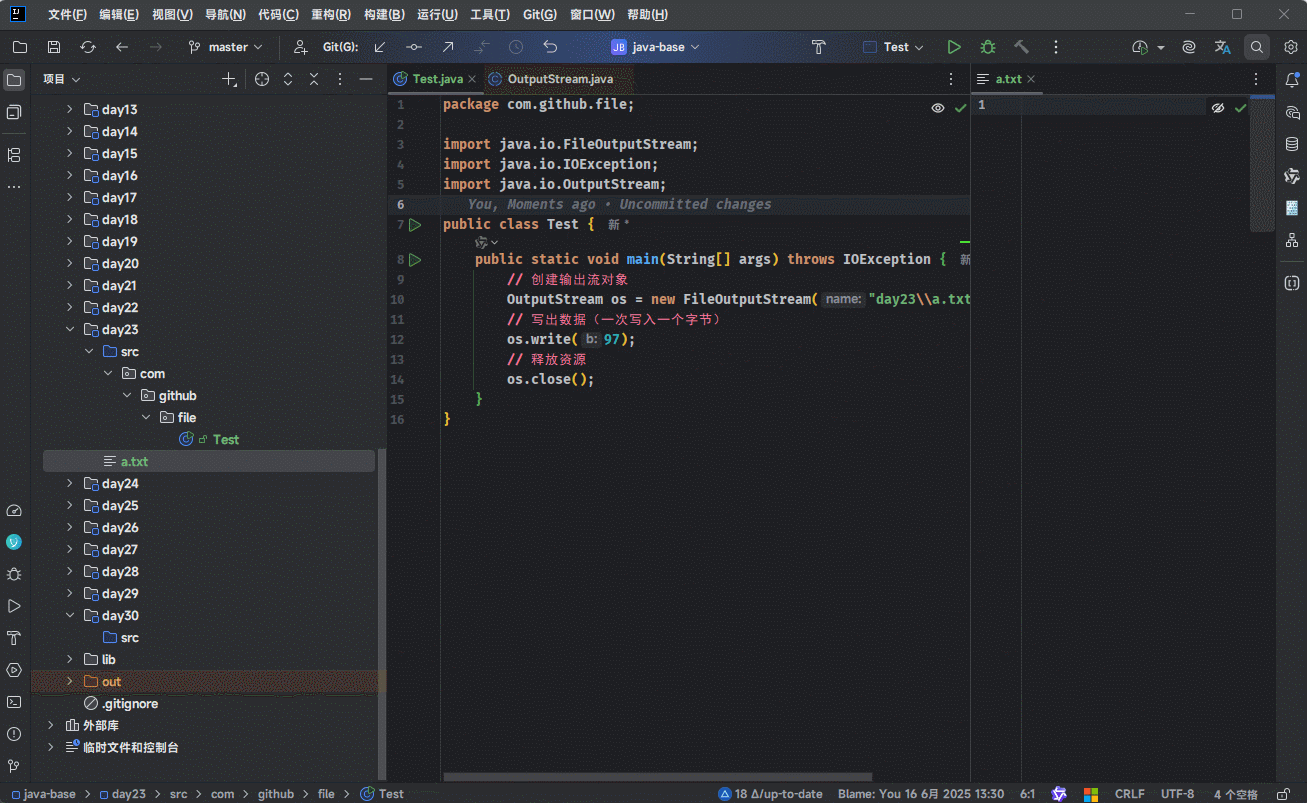
java
package com.github.file;
import java.io.FileOutputStream;
import java.io.IOException;
import java.io.OutputStream;
public class Test {
public static void main(String[] args) throws IOException {
// 创建输出流对象
OutputStream os = new FileOutputStream("day23\\a.txt");
// 写出数据(一次写入一个字节数组)
byte[] bytes = {97, 98, 99, 100, 101};
os.write(bytes);
// 释放资源
os.close();
}
}1
2
3
4
5
6
7
8
9
10
11
12
13
14
15
16
17
2
3
4
5
6
7
8
9
10
11
12
13
14
15
16
17
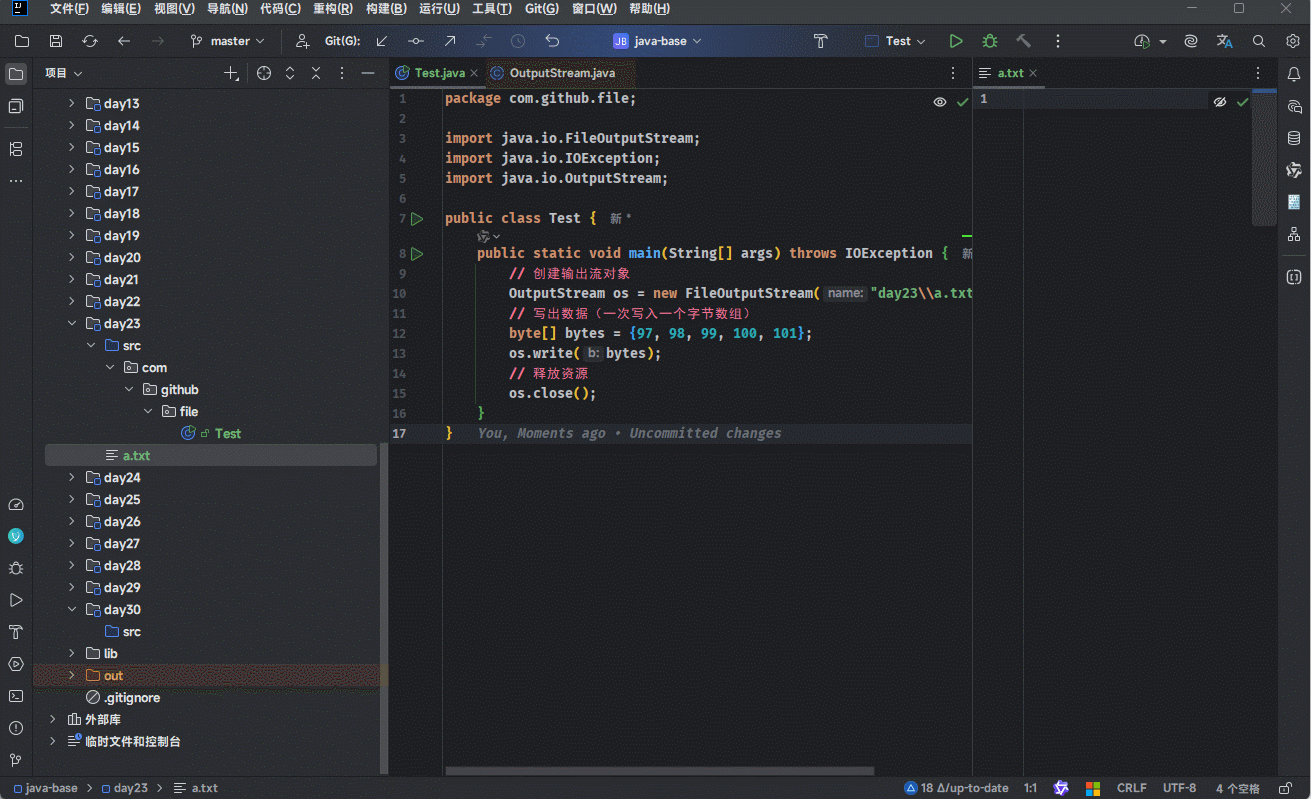
java
package com.github.file;
import java.io.FileOutputStream;
import java.io.IOException;
import java.io.OutputStream;
public class Test {
public static void main(String[] args) throws IOException {
// 创建输出流对象
OutputStream os = new FileOutputStream("day23\\a.txt");
// 写出数据(一次写入一个字节数组的一部分)
byte[] bytes = {97, 98, 99, 100, 101};
os.write(bytes, 0, 3);
// 释放资源
os.close();
}
}1
2
3
4
5
6
7
8
9
10
11
12
13
14
15
16
17
2
3
4
5
6
7
8
9
10
11
12
13
14
15
16
17
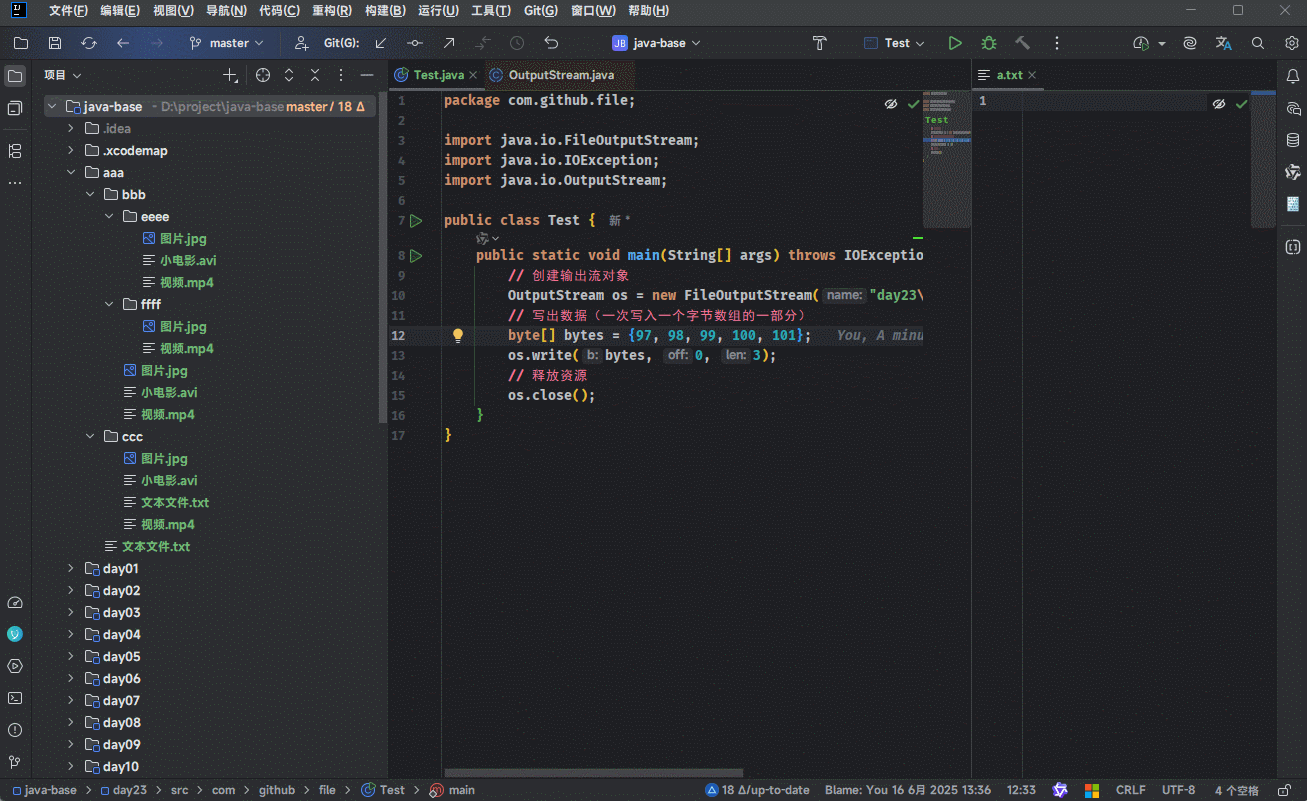
4.2.4.3 释放资源的细节
- 每次使用完流之后,必须释放资源:
java
package com.github.file;
import java.io.FileOutputStream;
import java.io.IOException;
import java.io.OutputStream;
public class Test {
public static void main(String[] args) throws IOException {
// 创建输出流对象
OutputStream os = new FileOutputStream("day23\\a.txt");
// 写出数据(一次写入一个字节数组的一部分)
byte[] bytes = {97, 98, 99, 100, 101};
os.write(bytes, 0, 3);
// 释放资源
os.close();
}
}1
2
3
4
5
6
7
8
9
10
11
12
13
14
15
16
17
2
3
4
5
6
7
8
9
10
11
12
13
14
15
16
17
- 但是,如果我不释放资源,其他人在本地是无法操作该文件,因为该文件已经被 Java 占用了:
java
package com.github.file;
import java.io.FileOutputStream;
import java.io.IOException;
import java.io.OutputStream;
public class Test {
public static void main(String[] args) throws IOException {
// 创建输出流对象
OutputStream os = new FileOutputStream("day23\\a.txt");
// 写出数据(一次写入一个字节数组的一部分)
byte[] bytes = {97, 98, 99, 100, 101};
os.write(bytes, 0, 3);
// 释放资源
// os.close();
// 防止 JVM 退出
while (true);
}
}1
2
3
4
5
6
7
8
9
10
11
12
13
14
15
16
17
18
19
20
2
3
4
5
6
7
8
9
10
11
12
13
14
15
16
17
18
19
20
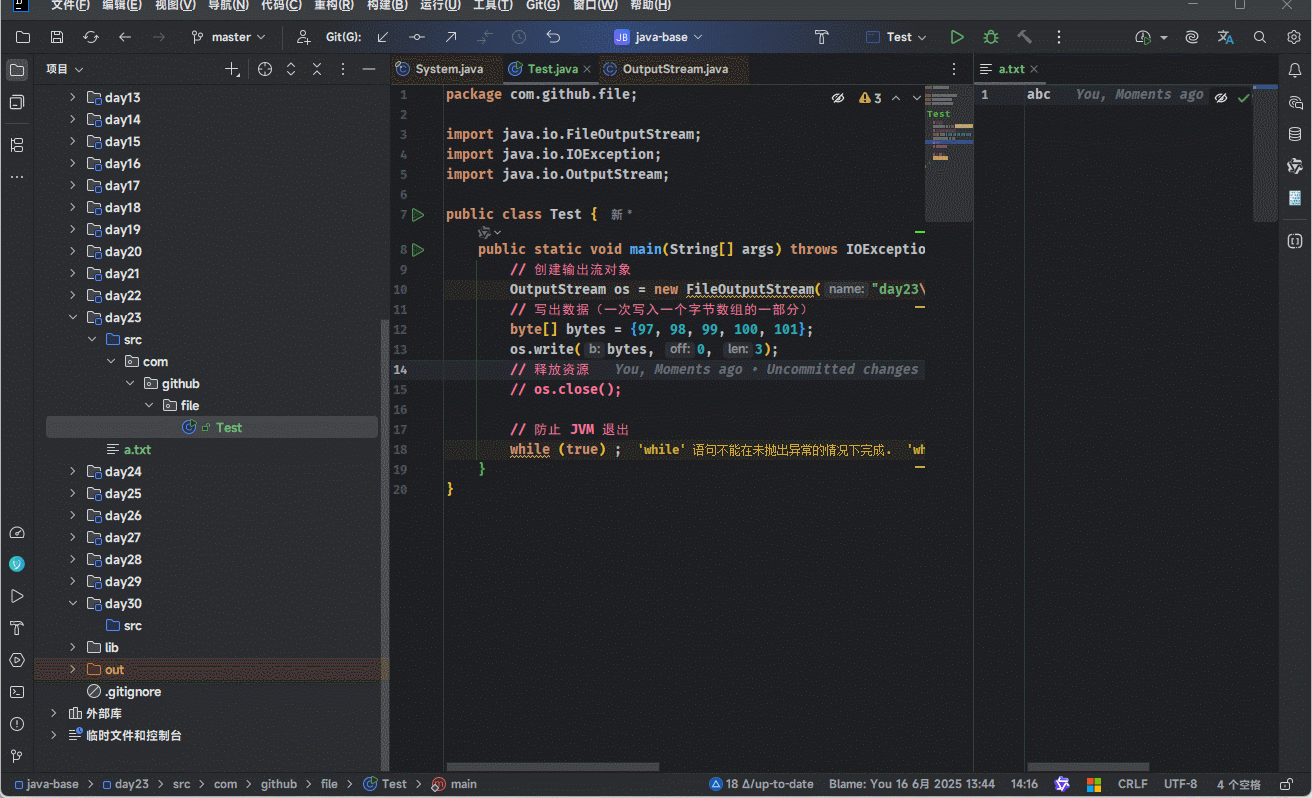
4.2.5 写数据小问题(续写)
- 如果本地文件中已经有数据了,如下所示:
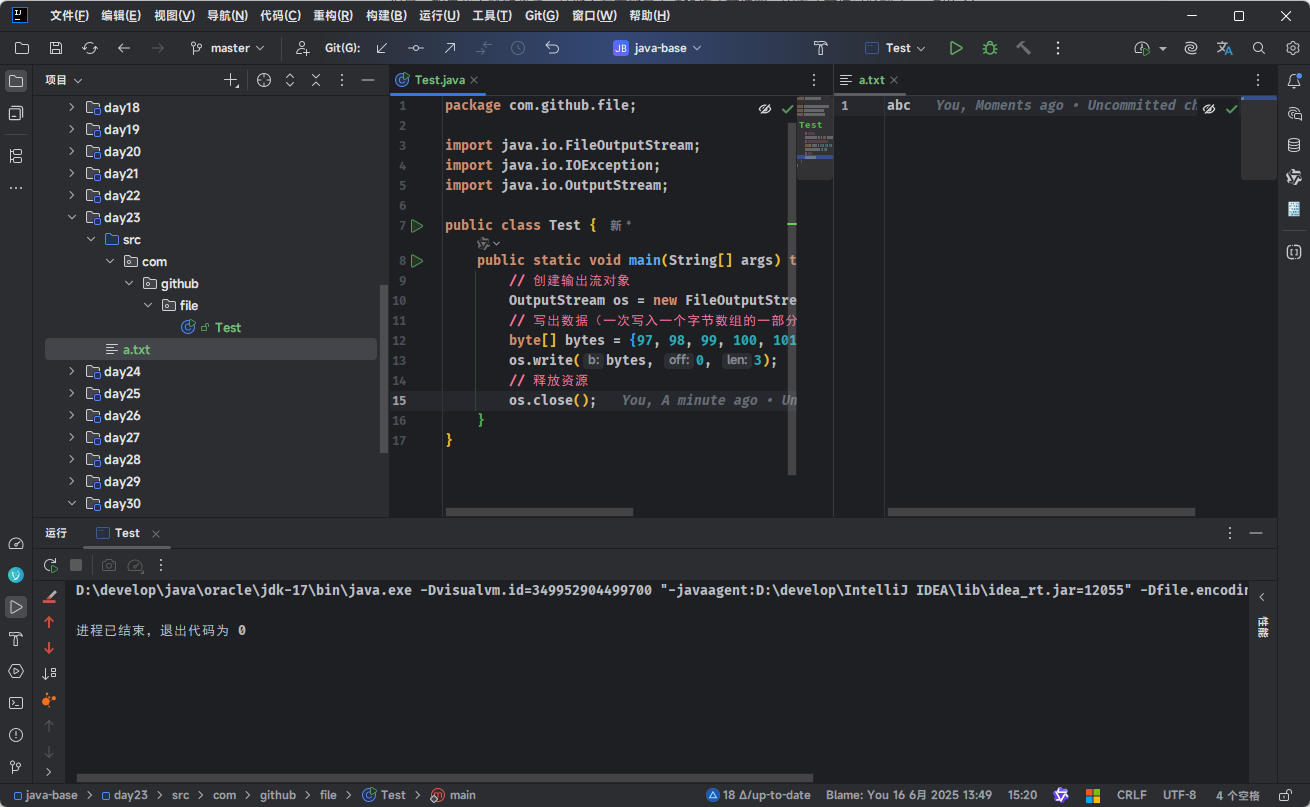
- 现在,每次我重新启动程序的时候,都会清空文件,再写入数据:
java
package com.github.file;
import java.io.FileOutputStream;
import java.io.IOException;
import java.io.OutputStream;
public class Test {
public static void main(String[] args) throws IOException {
// 创建输出流对象
OutputStream os = new FileOutputStream("day23\\a.txt");
// 写出数据(一次写入一个字节数组的一部分)
byte[] bytes = {97, 98, 99, 100, 101};
os.write(bytes, 0, 5);
// 释放资源
os.close();
}
}1
2
3
4
5
6
7
8
9
10
11
12
13
14
15
16
17
2
3
4
5
6
7
8
9
10
11
12
13
14
15
16
17
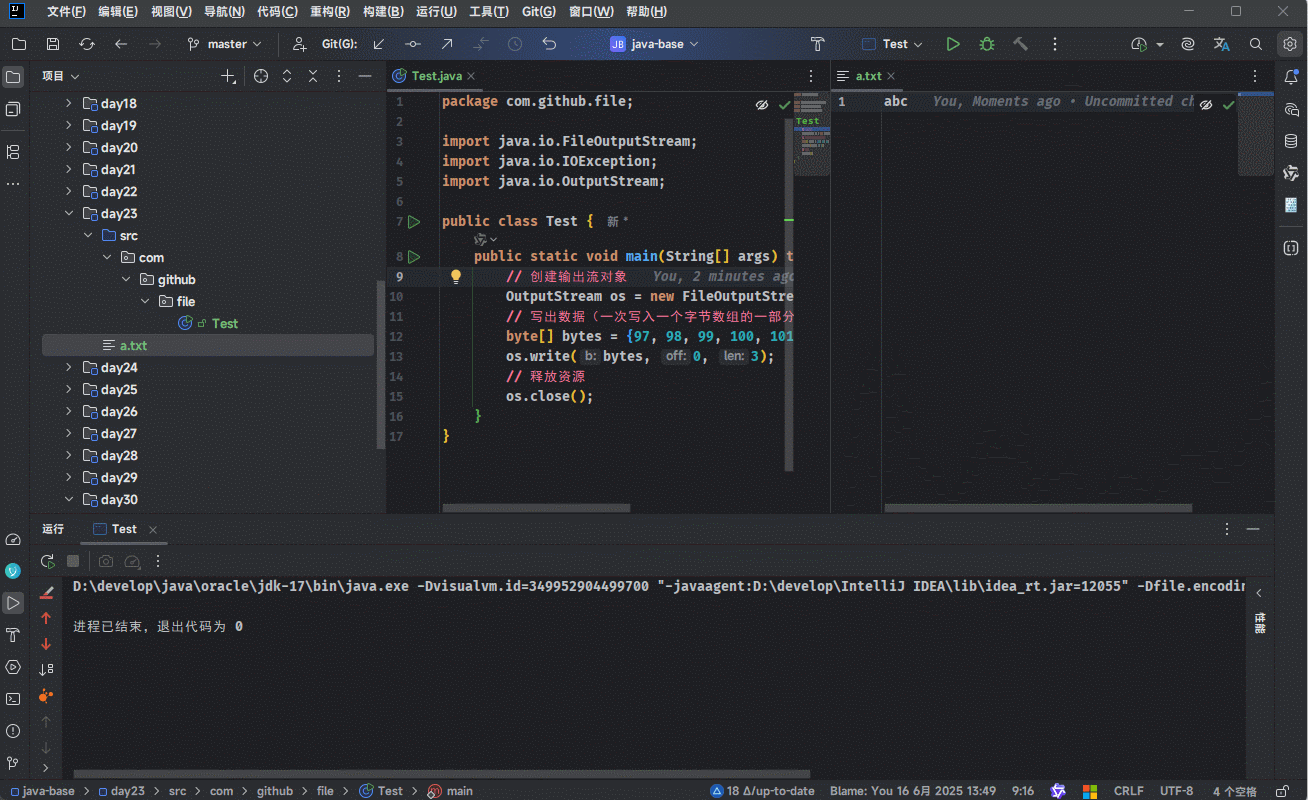
- 但是,我想再次启动程序的时候,不清空文件,而是续写,即:接着之前数据的末尾继续写:
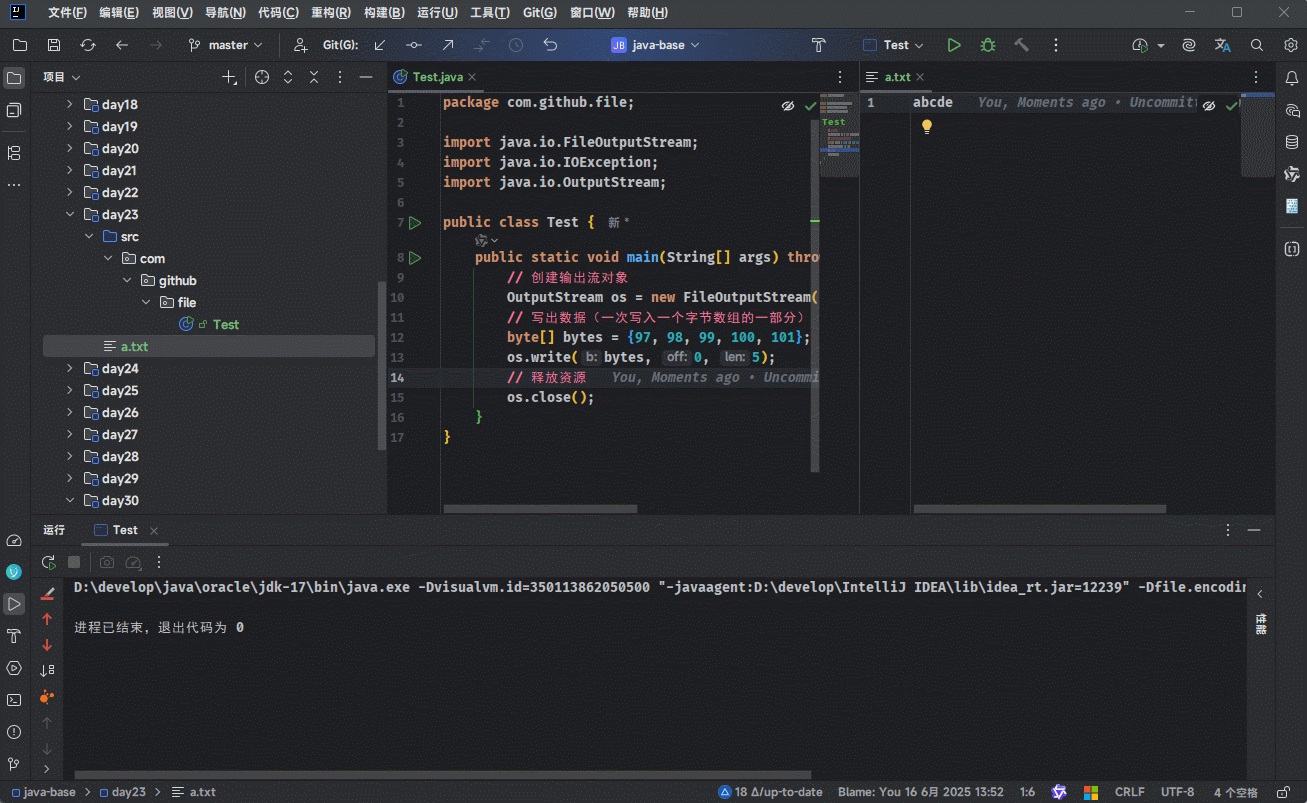
- 此时,就需要使用另一个带有续写开关的构造方法:
java
/**
* @param append 如果为 true,则追加写;如果为 false,则清空写
*/
public FileOutputStream(String name, boolean append) throws FileNotFoundException {
this(name != null ? new File(name) : null, append);
}1
2
3
4
5
6
2
3
4
5
6
- 那么,代码实现,如下所示:
java
package com.github.file;
import java.io.FileOutputStream;
import java.io.IOException;
import java.io.OutputStream;
public class Test {
public static void main(String[] args) throws IOException {
// 创建输出流对象
OutputStream os = new FileOutputStream("day23\\a.txt", true);
// 写出数据(一次写入一个字节数组的一部分)
byte[] bytes = {97, 98, 99, 100, 101};
os.write(bytes, 0, 5);
// 释放资源
os.close();
}
}1
2
3
4
5
6
7
8
9
10
11
12
13
14
15
16
17
2
3
4
5
6
7
8
9
10
11
12
13
14
15
16
17
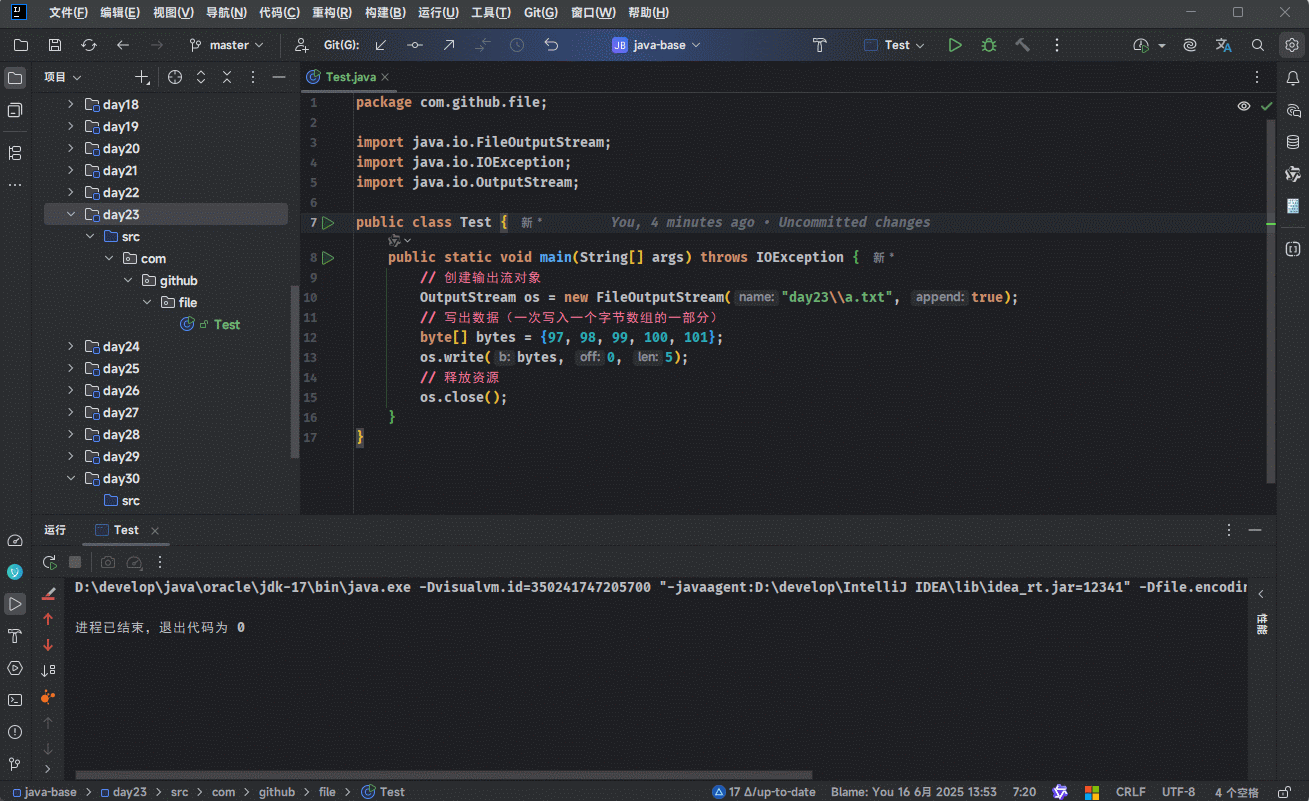
4.2.6 写数据小问题(换行写)
- 之前每调用一次 write 方法,都是数据的末尾接着写:
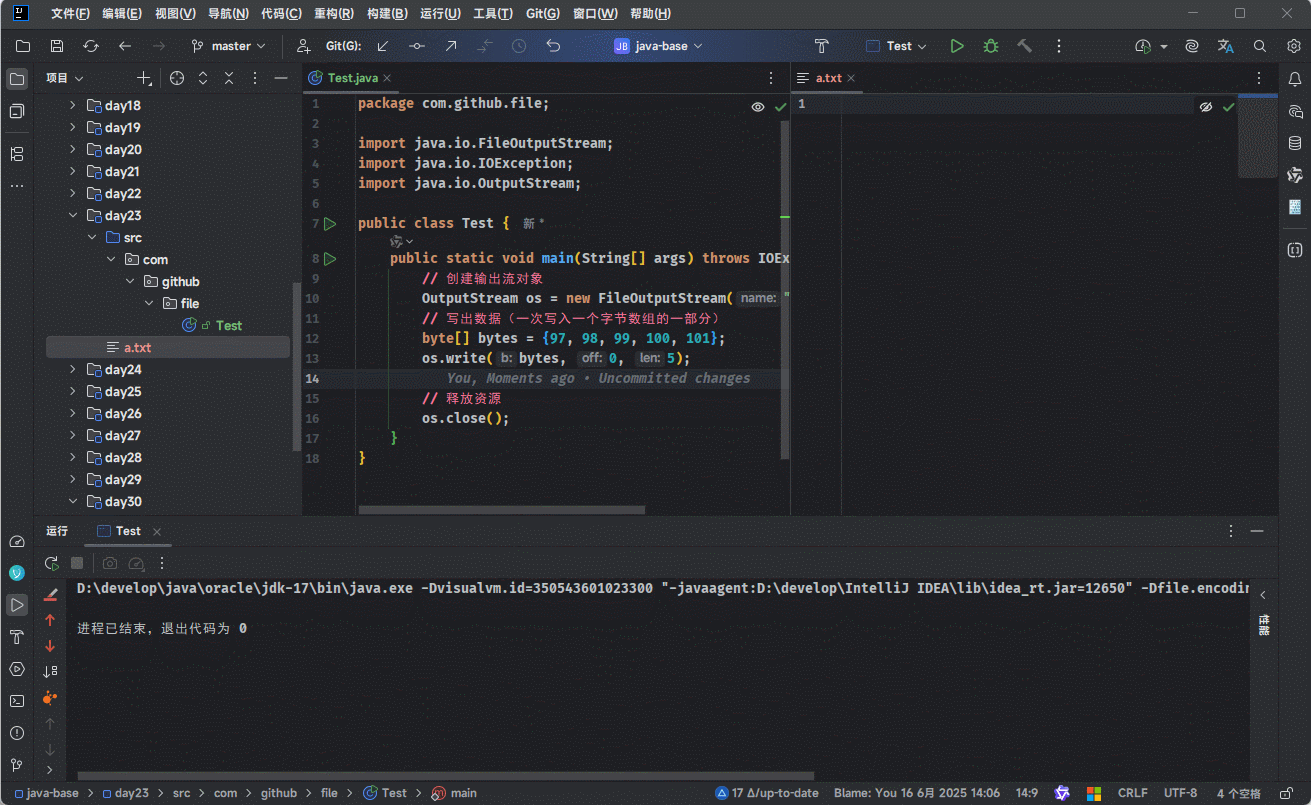
- 现在,我想要的是,每调用一次 write 方法之后换行写,此时就需要增加一个换行符:
提醒
- ① 主流操作系统中的换行符:
| 操作系统 | 换行符 |
|---|---|
| Windows | \r\n |
| Linux | \n |
| MacOS | \r |
- ② Java 中提供了获取当前操作系统的换行符的方法:
java
String lineSeparator = System.lineSeparator();1
java
package com.github.file;
import java.io.FileOutputStream;
import java.io.IOException;
import java.io.OutputStream;
import java.nio.charset.StandardCharsets;
public class Test {
public static void main(String[] args) throws IOException {
// 创建输出流对象
OutputStream os = new FileOutputStream("day23\\a.txt");
// 写出数据(一次写入一个字节数组的一部分)
byte[] bytes = {97, 98, 99, 100, 101};
os.write(bytes, 0, 5);
String lineSeparator = System.lineSeparator();
os.write(lineSeparator.getBytes(StandardCharsets.UTF_8));
os.write(bytes, 1, 4);
os.write(lineSeparator.getBytes(StandardCharsets.UTF_8));
os.write(bytes, 2, 3);
// 释放资源
os.close();
}
}1
2
3
4
5
6
7
8
9
10
11
12
13
14
15
16
17
18
19
20
21
22
23
2
3
4
5
6
7
8
9
10
11
12
13
14
15
16
17
18
19
20
21
22
23
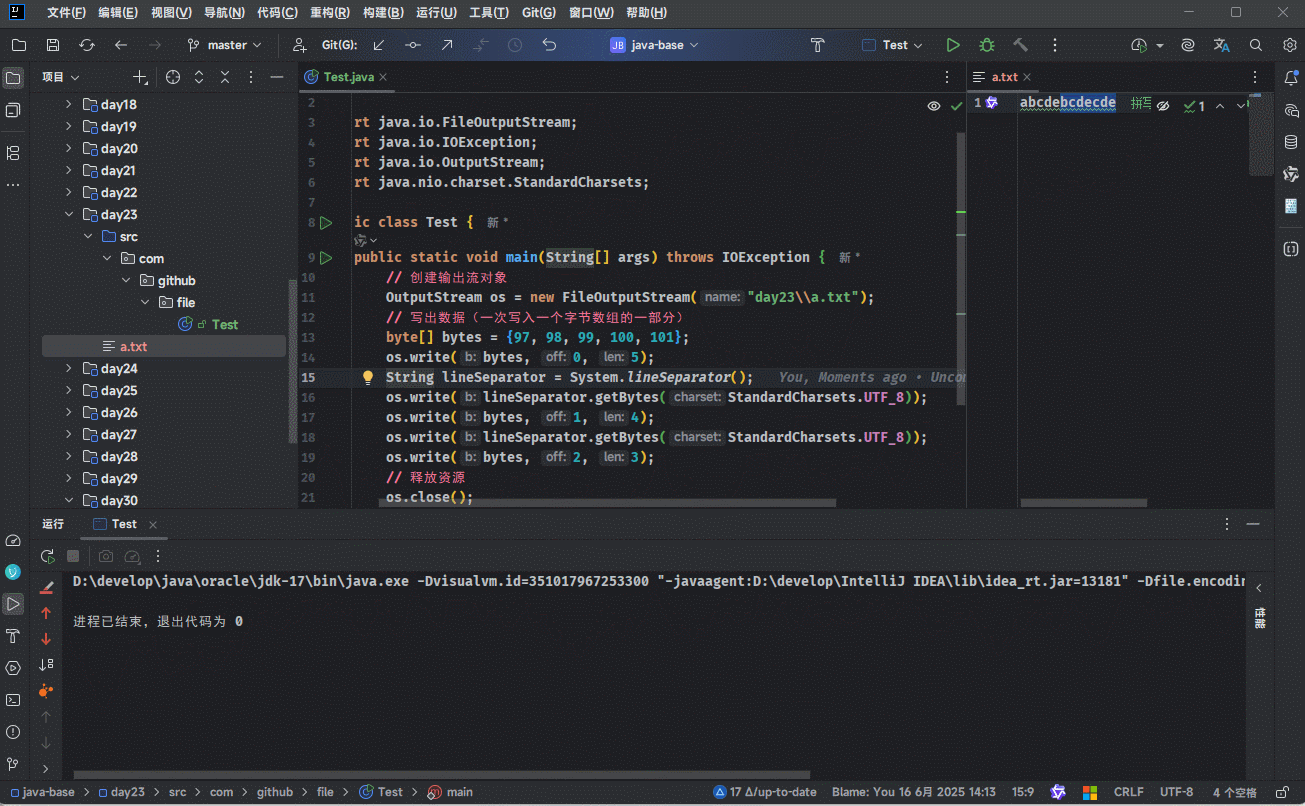
4.2.7 补充
- 有时,我们需要获取字符('a')在 ASCII 码表中的数字(97),Java 提供了 codePointAt 方法:
java
public final class Character
implements java.io.Serializable, Comparable<Character>, Constable {
public static int codePointAt(CharSequence seq, int index) {}
public static int codePointAt(char[] a, int index) {}
public static int codePointAt(char[] a, int index, int limit) {}
}1
2
3
4
5
6
7
8
9
10
2
3
4
5
6
7
8
9
10
- 有时,我们希望根据 ASCII 码表中的数字(97)获取其对应的字符('a'),Java 提供了
java
public final class Character
implements java.io.Serializable, Comparable<Character>, Constable {
public static char[] toChars(int codePoint) {}
public static int toChars(int codePoint, char[] dst, int dstIndex) {}
}1
2
3
4
5
6
7
8
2
3
4
5
6
7
8
- 示例:
java
package com.github.file;
import java.io.IOException;
public class Test {
public static void main(String[] args) throws IOException {
int num = Character.codePointAt("a", 0);
System.out.println(num); // 97
char[] chars = Character.toChars(num);
System.out.println(new String(chars)); // a
}
}1
2
3
4
5
6
7
8
9
10
11
12
13
14
15
2
3
4
5
6
7
8
9
10
11
12
13
14
15
4.3 FileInputStream
4.3.1 概述
- FileInputStream 是操作本地文件的字节输入流,可以将本地文件中的数据读取到程序中。
4.3.2 操作步骤
- ① 创建字节输出流对象。
java
public class FileInputStream extends InputStream {
public FileInputStream(String name) throws FileNotFoundException {
...
}
public FileInputStream(File file) throws FileNotFoundException {
...
}
...
}1
2
3
4
5
6
7
8
9
10
11
12
2
3
4
5
6
7
8
9
10
11
12
- ② 读取数据:
java
public class FileInputStream extends InputStream {
// 一次读取一个字节,读取的数据是在 ASCII 码表上字符对应的数字
// 如果读到末尾,返回 -1
public int read() throws IOException {
...
}
...
}1
2
3
4
5
6
7
8
9
10
2
3
4
5
6
7
8
9
10
- ③ 释放资源:
java
public class FileInputStream extends InputStream {
public void close() throws IOException {
...
}
...
}1
2
3
4
5
6
7
8
2
3
4
5
6
7
8
- 示例:
java
package com.github.file;
import java.io.FileInputStream;
import java.io.IOException;
import java.io.InputStream;
public class Test {
public static void main(String[] args) throws IOException {
// 创建输入流对象
InputStream is = new FileInputStream("day23\\a.txt");
// 读取数据
// 一次读取一个字节,读取的数据是在 ASCII 码表上字符对应的数字
// 如果读到末尾,返回 -1
int read = is.read();
System.out.println(read);
// 释放资源
is.close();
}
}1
2
3
4
5
6
7
8
9
10
11
12
13
14
15
16
17
18
19
20
21
22
2
3
4
5
6
7
8
9
10
11
12
13
14
15
16
17
18
19
20
21
22
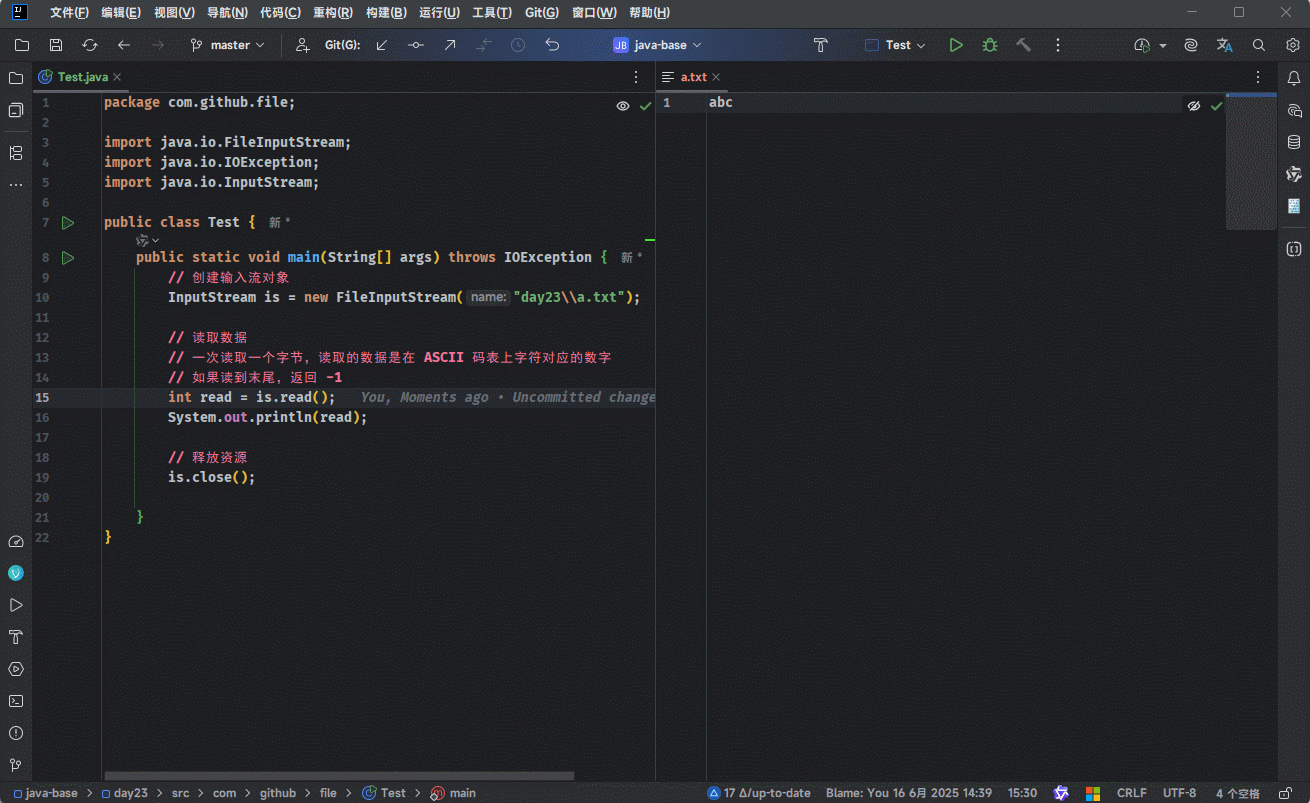
4.3.3 原理
- 电脑硬盘中的的文件非常多,我们的程序是如何知道从那个文件中读取数据的?
- 其实,当我们创建 FileInputStream 对象的时候,如下所示:
java
InputStream is = new FileInputStream("day23\\a.txt");1
- Java 程序会根据我们书写的文件路径,和硬盘上的指定文件建立了一个传输数据的通道:
- 当我们调用 read 方法读取数据的时候,如下所示
java
int read = is.read();
System.out.println(read);1
2
2
- 其实就相当于数据在这个通道中进行传输:
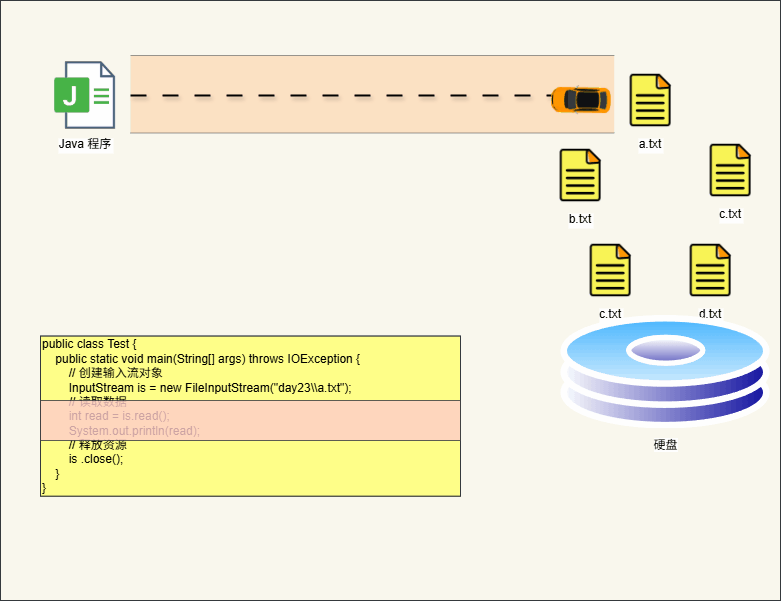
- 当我们调用 close 方法的时候进行资源释放,如下所示:
java
is.close();1
- 其实,就相当于将这个通道给砸碎:
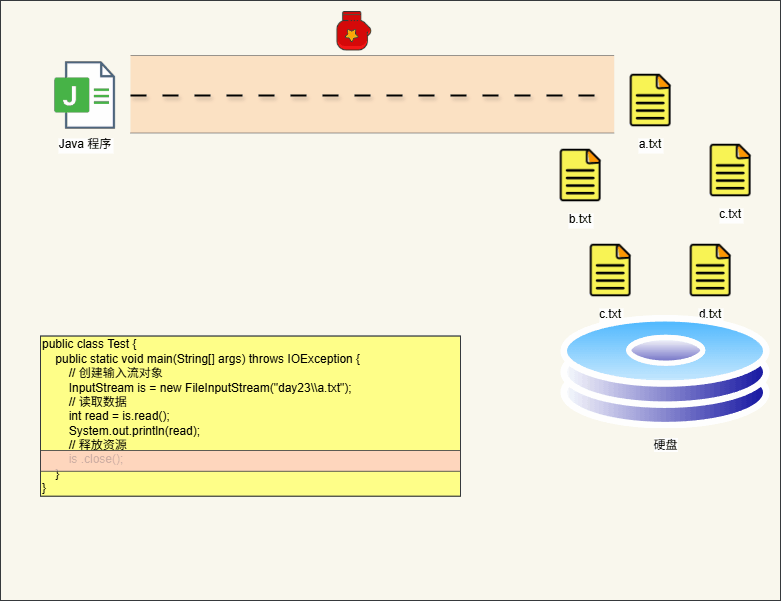
4.3.4 细节
4.3.4.1 创建字节输入流细节
- 如果文件不存在,就报错。
提醒
- ① 对于输出流而言,如果文件不存在,则创建。
点我查看 原因
- 输出流是将程序中的数据写出到文件中,重要的是
数据,而数据就存在于程序中。 - 文件不存在,创建一个文件,再写入数据,逻辑没毛病(数据没丢)!!!
- ② 对于输入流而言,如果文件不存在,则报错。
点我查看 原因
- 输入流是需要将文件中的数据从
文件中读取到内存中,虽然数据很重要;但是,没有文件,从哪里读? - 如果 Java 也设计为:文件不存在,输入流也创建新文件,那么新文件中空数据,没什么意义。
java
package com.github.file;
import java.io.FileInputStream;
import java.io.IOException;
import java.io.InputStream;
public class Test {
public static void main(String[] args) throws IOException {
// 创建输入流对象(如果文件不存在,就报错)
InputStream is = new FileInputStream("day23\\b.txt");
// 读取数据
// 一次读取一个字节,读取的数据是在 ASCII 码表上字符对应的数字
// 如果读到末尾,返回 -1
int read = is.read();
System.out.println(read);
// 释放资源
is.close();
}
}1
2
3
4
5
6
7
8
9
10
11
12
13
14
15
16
17
18
19
20
21
2
3
4
5
6
7
8
9
10
11
12
13
14
15
16
17
18
19
20
21
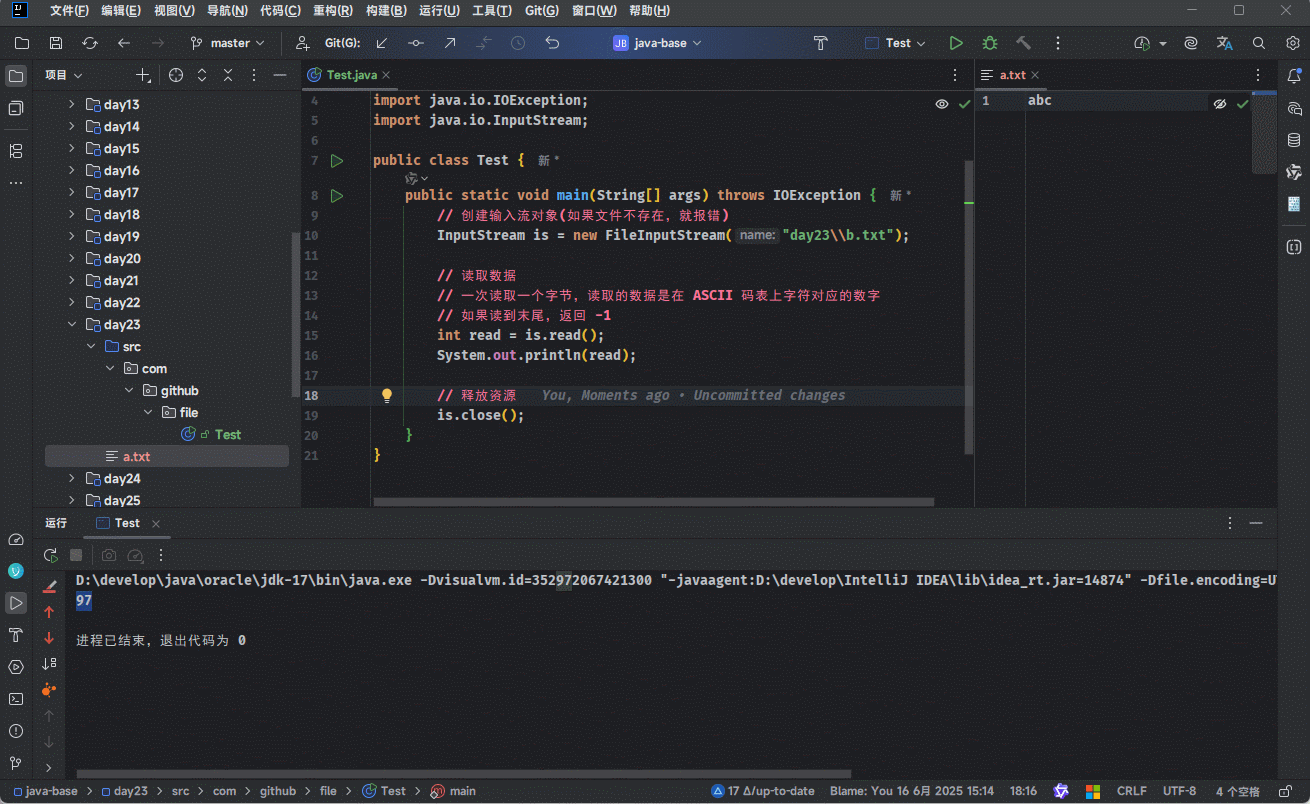
4.3.4.2 读数据的细节
- ① 一次读取一个字节,读取的是数据在 ASCII 码表上对应的数字:
java
package com.github.file;
import java.io.FileInputStream;
import java.io.IOException;
import java.io.InputStream;
public class Test {
public static void main(String[] args) throws IOException {
// 创建输入流对象
InputStream is = new FileInputStream("day23\\a.txt");
// 读取数据
// 一次读取一个字节,读取的数据是在 ASCII 码表上字符对应的数字
int read = is.read();
System.out.println(read);
read = is.read();
System.out.println(read);
read = is.read();
System.out.println(read);
// 释放资源
is.close();
}
}1
2
3
4
5
6
7
8
9
10
11
12
13
14
15
16
17
18
19
20
21
22
23
24
2
3
4
5
6
7
8
9
10
11
12
13
14
15
16
17
18
19
20
21
22
23
24
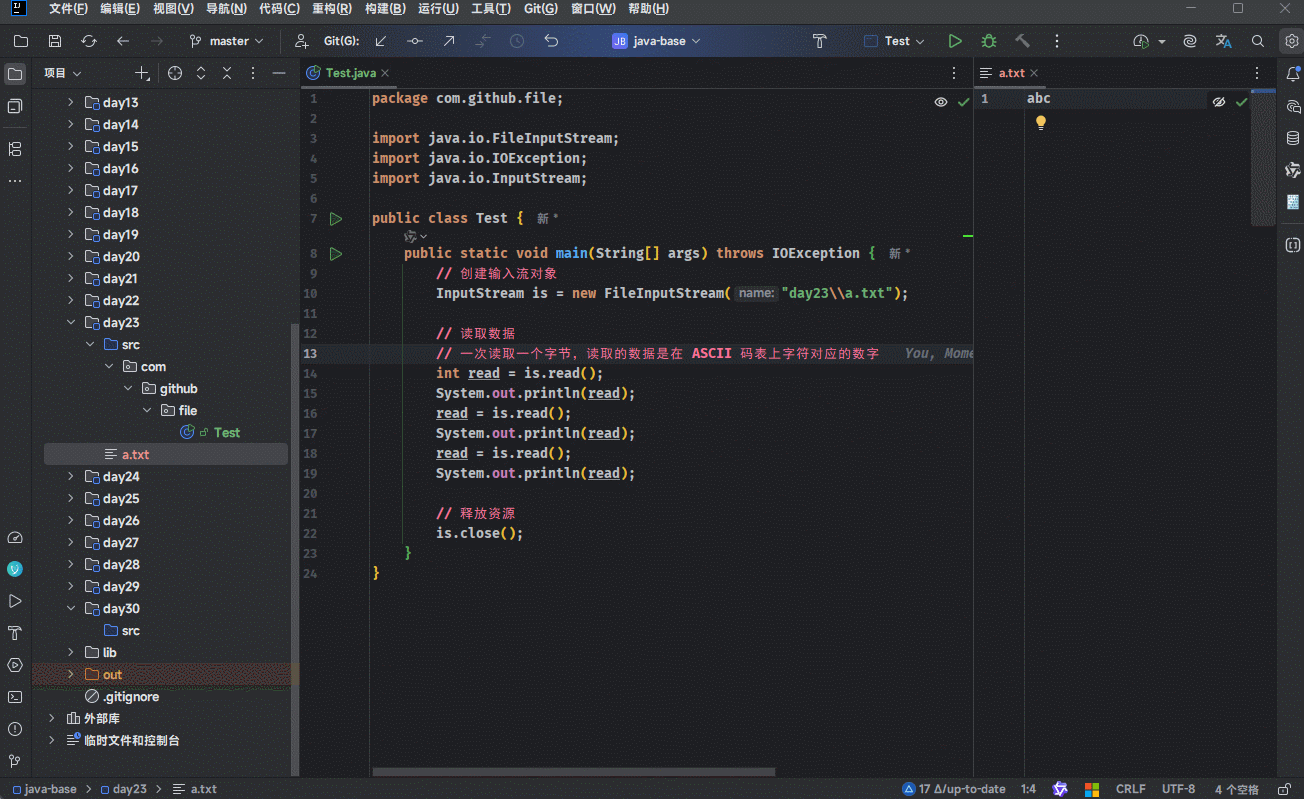
- ② 如果读取到文件末尾,就返回 -1 。
提醒
其实,在计算机中,文件末尾 -1 被称为 End of file(EOF,就地文本),在 IOStatus 类中有定义:
java
public final class IOStatus {
private IOStatus() { }
@Native public static final int EOF = -1; // End of file
...
}1
2
3
4
5
6
7
8
2
3
4
5
6
7
8
java
package com.github.file;
import java.io.FileInputStream;
import java.io.IOException;
import java.io.InputStream;
public class Test {
public static void main(String[] args) throws IOException {
// 创建输入流对象
InputStream is = new FileInputStream("day23\\a.txt");
// 读取数据
// 一次读取一个字节,读取的数据是在 ASCII 码表上字符对应的数字
int read = is.read();
System.out.println(read);
read = is.read();
System.out.println(read);
read = is.read();
System.out.println(read);
read = is.read();
System.out.println(read); // -1
read = is.read();
System.out.println(read); // -1
// 释放资源
is.close();
}
}1
2
3
4
5
6
7
8
9
10
11
12
13
14
15
16
17
18
19
20
21
22
23
24
25
26
27
2
3
4
5
6
7
8
9
10
11
12
13
14
15
16
17
18
19
20
21
22
23
24
25
26
27
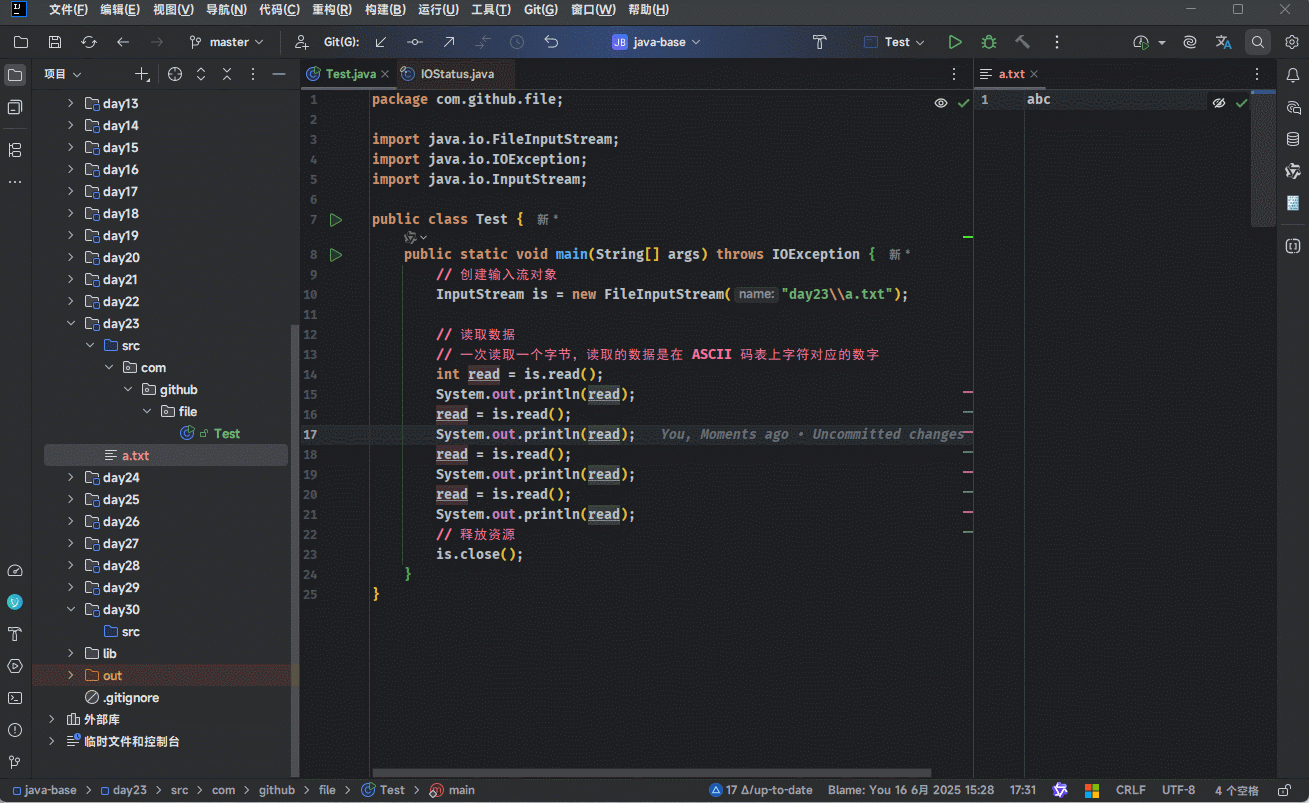
4.3.4.3 释放资源的细节
- 每次使用完流之后,必须释放资源:
java
package com.github.file;
import java.io.FileInputStream;
import java.io.IOException;
import java.io.InputStream;
public class Test {
public static void main(String[] args) throws IOException {
// 创建输入流对象
InputStream is = new FileInputStream("day23\\a.txt");
// 读取数据
// 一次读取一个字节,读取的数据是在 ASCII 码表上字符对应的数字
int read = is.read();
System.out.println(read);
read = is.read();
System.out.println(read);
read = is.read();
System.out.println(read);
read = is.read();
System.out.println(read);
read = is.read();
System.out.println(read);
// 释放资源
is.close();
}
}1
2
3
4
5
6
7
8
9
10
11
12
13
14
15
16
17
18
19
20
21
22
23
24
25
26
27
2
3
4
5
6
7
8
9
10
11
12
13
14
15
16
17
18
19
20
21
22
23
24
25
26
27
- 但是,如果我不释放资源,其他人在本地是无法操作该文件,因为该文件已经被 Java 占用了:
java
package com.github.file;
import java.io.FileInputStream;
import java.io.IOException;
import java.io.InputStream;
public class Test {
public static void main(String[] args) throws IOException {
// 创建输入流对象
InputStream is = new FileInputStream("day23\\a.txt");
// 读取数据
// 一次读取一个字节,读取的数据是在 ASCII 码表上字符对应的数字
int read = is.read();
System.out.println(read);
read = is.read();
System.out.println(read);
read = is.read();
System.out.println(read);
read = is.read();
System.out.println(read);
read = is.read();
System.out.println(read);
// 释放资源
// is.close();
// 防止 JVM 退出
while (true) ;
}
}1
2
3
4
5
6
7
8
9
10
11
12
13
14
15
16
17
18
19
20
21
22
23
24
25
26
27
28
29
30
2
3
4
5
6
7
8
9
10
11
12
13
14
15
16
17
18
19
20
21
22
23
24
25
26
27
28
29
30
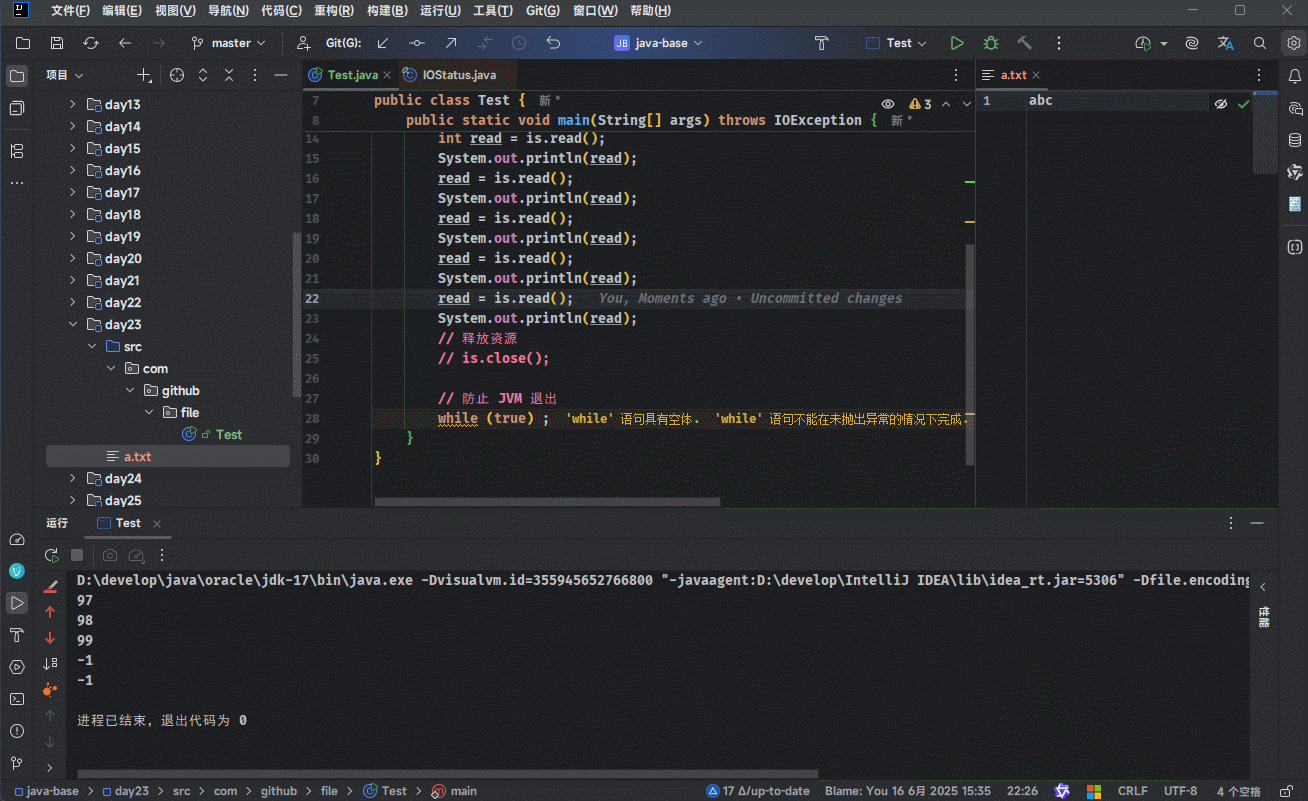
4.3.5 循环读取数据
- ① 当我们创建字节输入流对象的时候,默认是指向第 1 个数据的:
- ② 每调用一次 read() 方法,就返回指定位置上的数据,并移动指针到下一个位置(如果到了文件末尾,就返回 -1):
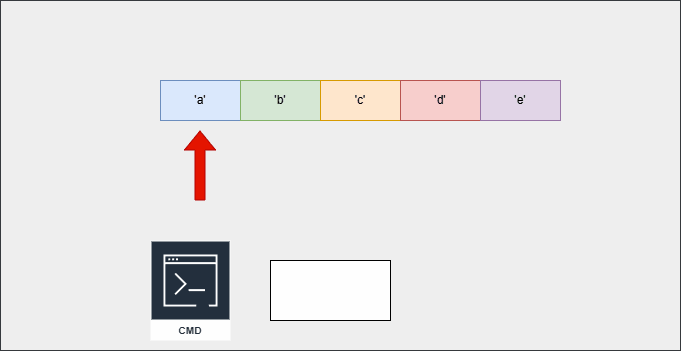
- 示例:
java
package com.github.file;
import java.io.FileInputStream;
import java.io.IOException;
import java.io.InputStream;
public class Test {
public static void main(String[] args) throws IOException {
// 创建输入流对象
InputStream is = new FileInputStream("day23\\a.txt");
// 读取数据
// 一次读取一个字节,读取的数据是在 ASCII 码表上字符对应的数字
// 读取到文件末尾,返回 -1
int b;
while ((b = is.read()) != -1) {
System.out.println(b);
System.out.println(Character.toChars(b));
}
// 释放资源
is.close();
}
}1
2
3
4
5
6
7
8
9
10
11
12
13
14
15
16
17
18
19
20
21
22
23
24
25
2
3
4
5
6
7
8
9
10
11
12
13
14
15
16
17
18
19
20
21
22
23
24
25
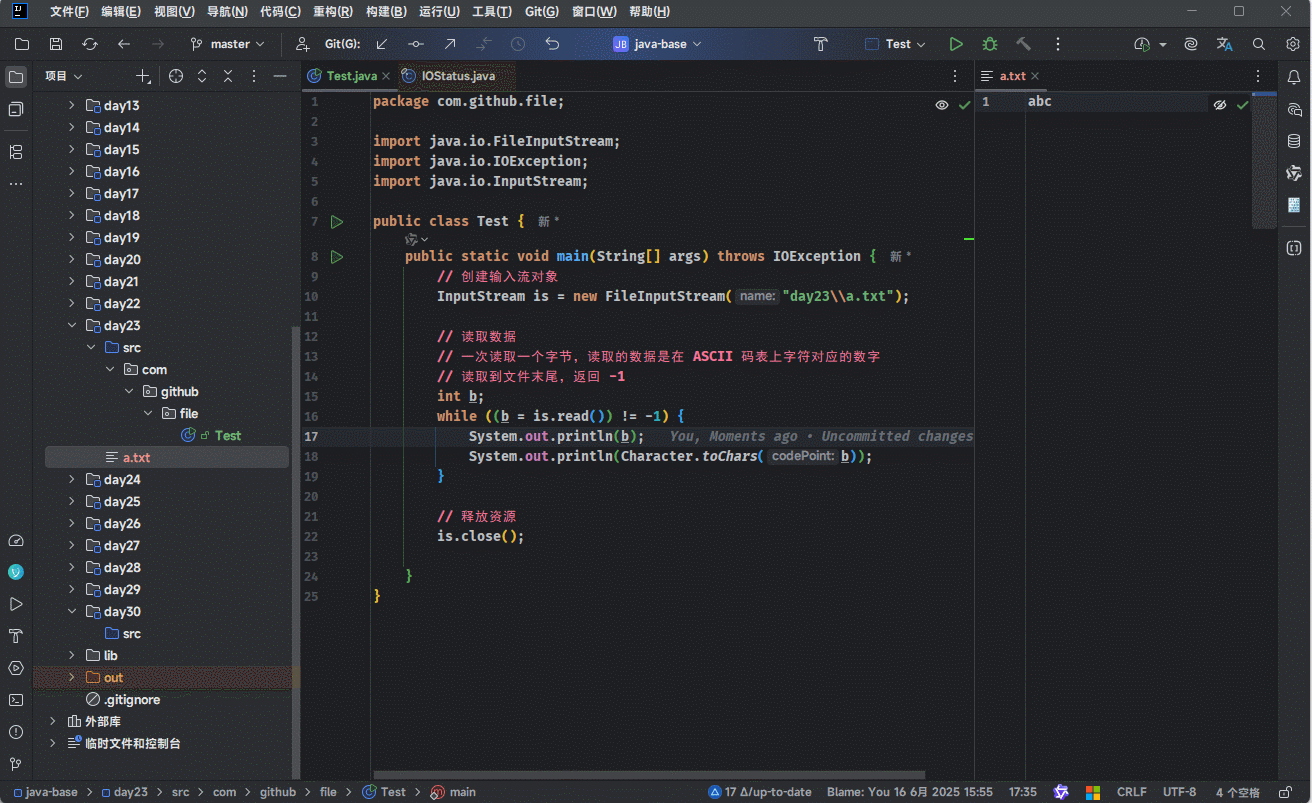
4.3.6 循环读取数据的细节
- 之前,我们是这样循环读取数据的,如下所示:
java
package com.github.file;
import java.io.FileInputStream;
import java.io.IOException;
import java.io.InputStream;
public class Test {
public static void main(String[] args) throws IOException {
// 创建输入流对象
InputStream is = new FileInputStream("day23\\a.txt");
// 读取数据
// 一次读取一个字节,读取的数据是在 ASCII 码表上字符对应的数字
// 读取到文件末尾,返回 -1
int b;
while ((b = is.read()) != -1) {
System.out.println(b);
System.out.println(Character.toChars(b));
}
// 释放资源
is.close();
}
}1
2
3
4
5
6
7
8
9
10
11
12
13
14
15
16
17
18
19
20
21
22
23
24
25
2
3
4
5
6
7
8
9
10
11
12
13
14
15
16
17
18
19
20
21
22
23
24
25

- 其内存中的示意图,如下所示:
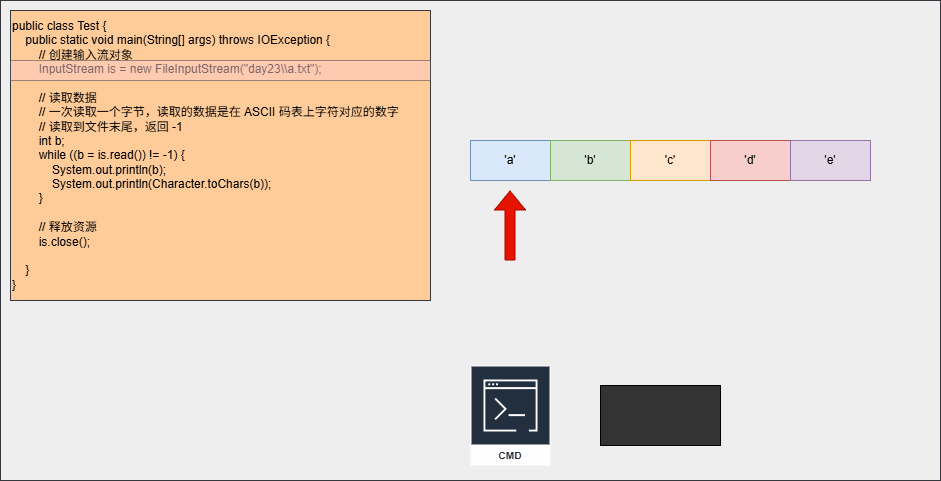
- 但是,有些同学就不这么写,他一定要调用两次 read() 方法,会发现结果不对,如下所示:
java
package com.github.file;
import java.io.FileInputStream;
import java.io.IOException;
import java.io.InputStream;
public class Test {
public static void main(String[] args) throws IOException {
// 创建输入流对象
InputStream is = new FileInputStream("day23\\a.txt");
// 读取数据
// 一次读取一个字节,读取的数据是在 ASCII 码表上字符对应的数字
// 读取到文件末尾,返回 -1
while (is.read() != -1) {
System.out.println(is.read());
}
// 释放资源
is.close();
}
}1
2
3
4
5
6
7
8
9
10
11
12
13
14
15
16
17
18
19
20
21
22
23
2
3
4
5
6
7
8
9
10
11
12
13
14
15
16
17
18
19
20
21
22
23
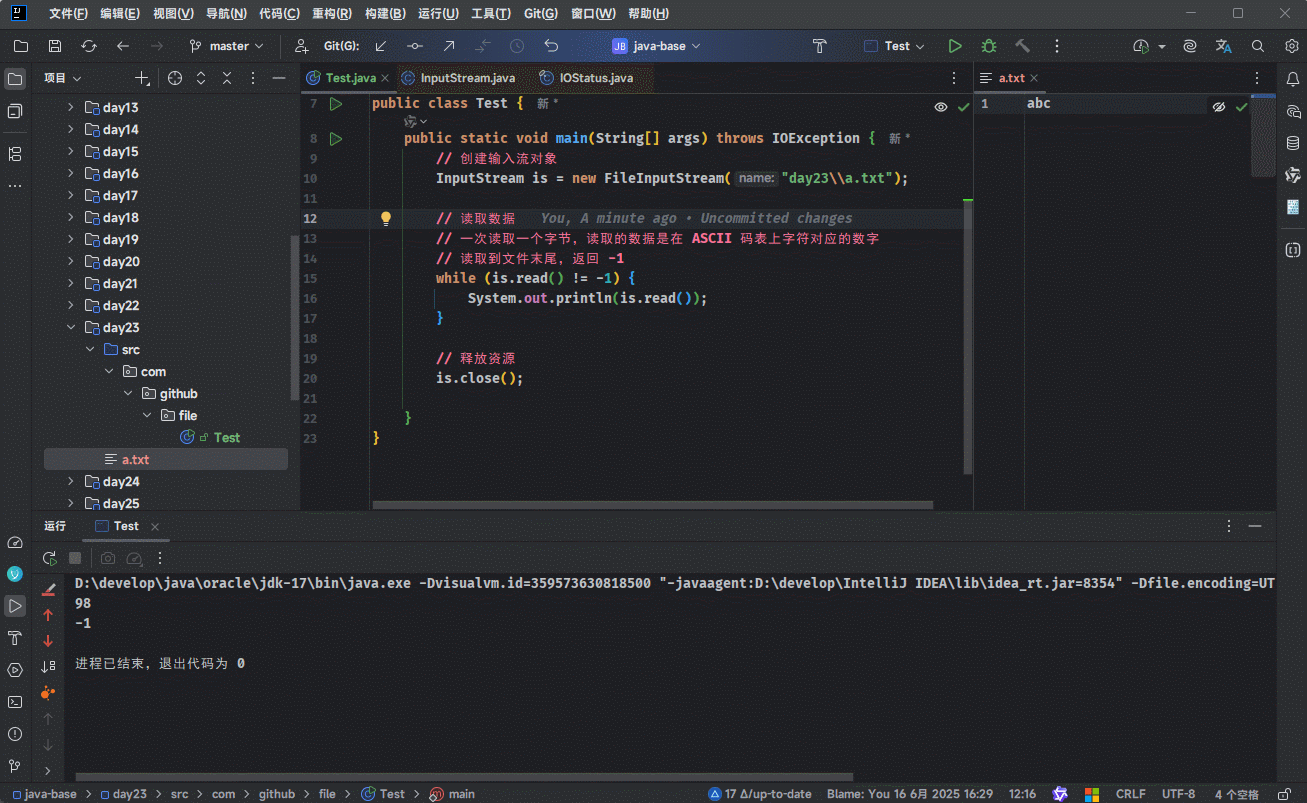
- 其内存中的示意图,如下所示:
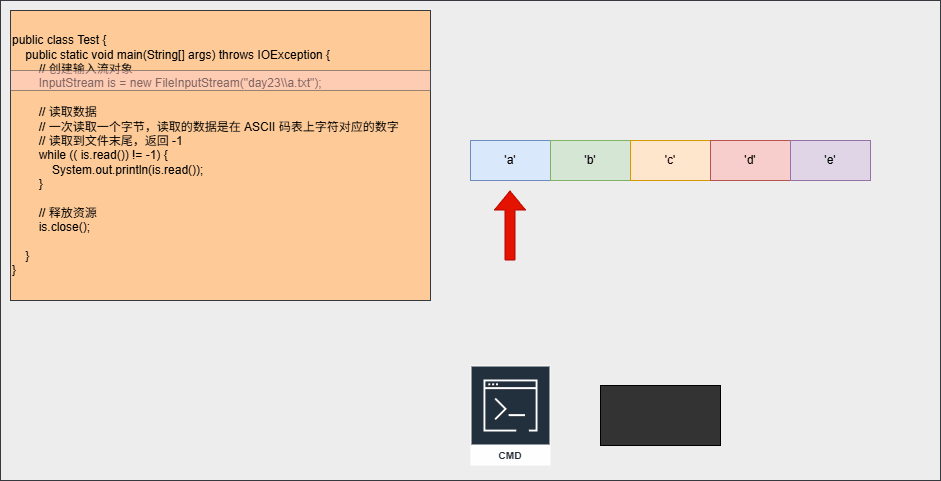
4.4 拷贝文件
4.4.1 概述
- 拷贝文件:通过
字节输入流将源文件的数据读取到程序中,并通过字节输出流将程序中的数据写出到目的地文件中。 - 其动态示意图,如下所示:

4.4.2 文件拷贝
- 文件的拷贝(复制),其主要思想是:边读边写,并且先打开的流最后关闭。
提醒
- ① 先拷贝小文件。
- ② 需要统计耗时!!!
- 示例:
java
package com.github.file;
import java.io.*;
public class Test {
public static void main(String[] args) throws IOException {
// 创建字节输入流对象和字节输出流对象,以便关联源文件和目的地文件
InputStream is = new FileInputStream("day23\\a.txt");
OutputStream os = new FileOutputStream("day23\\b.txt");
// 复制文件:边读边写
int b;
while ((b = is.read()) != -1) {
os.write(b);
}
// 关闭资源:先开的最后关闭
os.close();
is.close();
}
}1
2
3
4
5
6
7
8
9
10
11
12
13
14
15
16
17
18
19
20
21
2
3
4
5
6
7
8
9
10
11
12
13
14
15
16
17
18
19
20
21
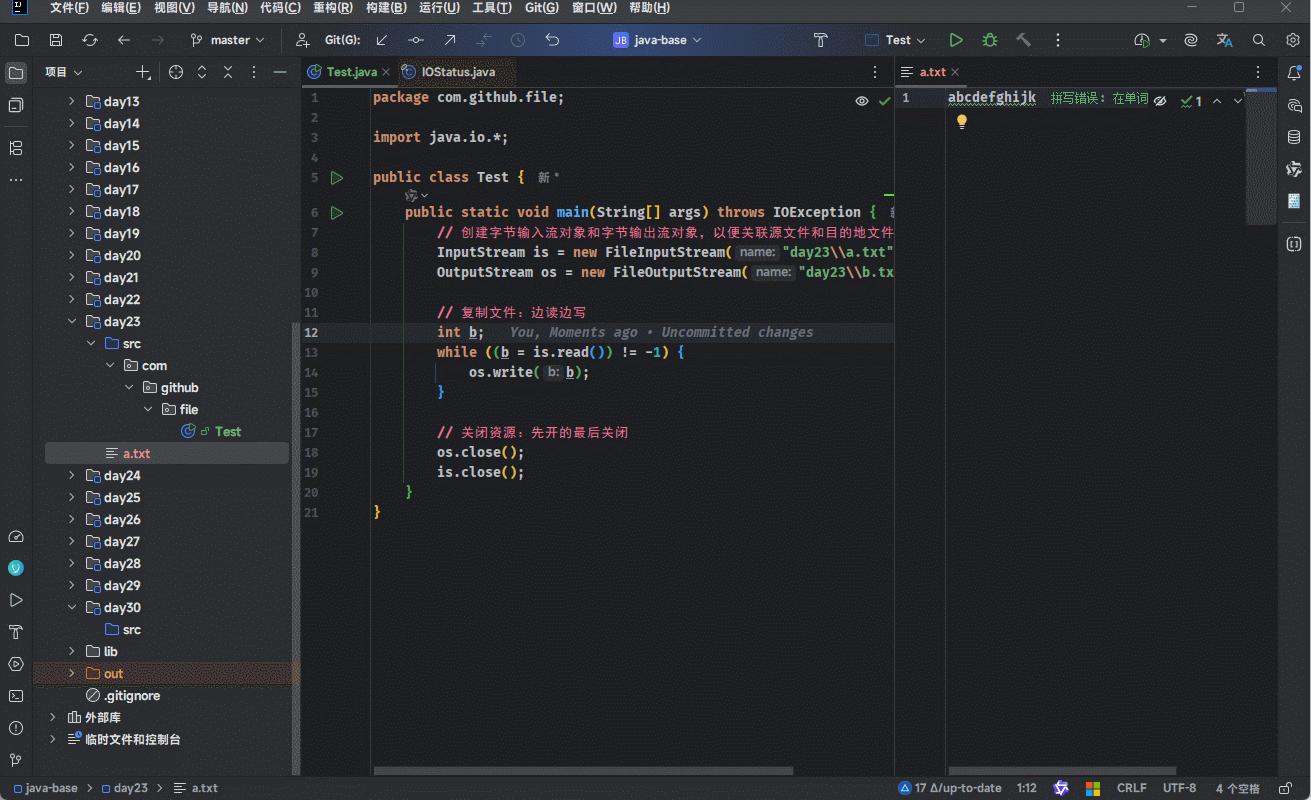
- 示例:
java
package com.github.file;
import java.io.*;
import java.time.Instant;
import java.time.temporal.ChronoUnit;
public class Test {
public static void main(String[] args) throws IOException {
Instant start = Instant.now();
// 创建字节输入流对象和字节输出流对象,以便关联源文件和目的地文件
InputStream is = new FileInputStream("day23\\a.txt");
OutputStream os = new FileOutputStream("day23\\b.txt");
// 复制文件:边读边写
int b;
while ((b = is.read()) != -1) {
os.write(b);
}
// 关闭资源:先开的最后关闭
os.close();
is.close();
Instant now = Instant.now();
long between = ChronoUnit.MILLIS.between(start, now);
System.out.printf("耗时:%s ms", between);
}
}1
2
3
4
5
6
7
8
9
10
11
12
13
14
15
16
17
18
19
20
21
22
23
24
25
26
27
28
29
30
2
3
4
5
6
7
8
9
10
11
12
13
14
15
16
17
18
19
20
21
22
23
24
25
26
27
28
29
30
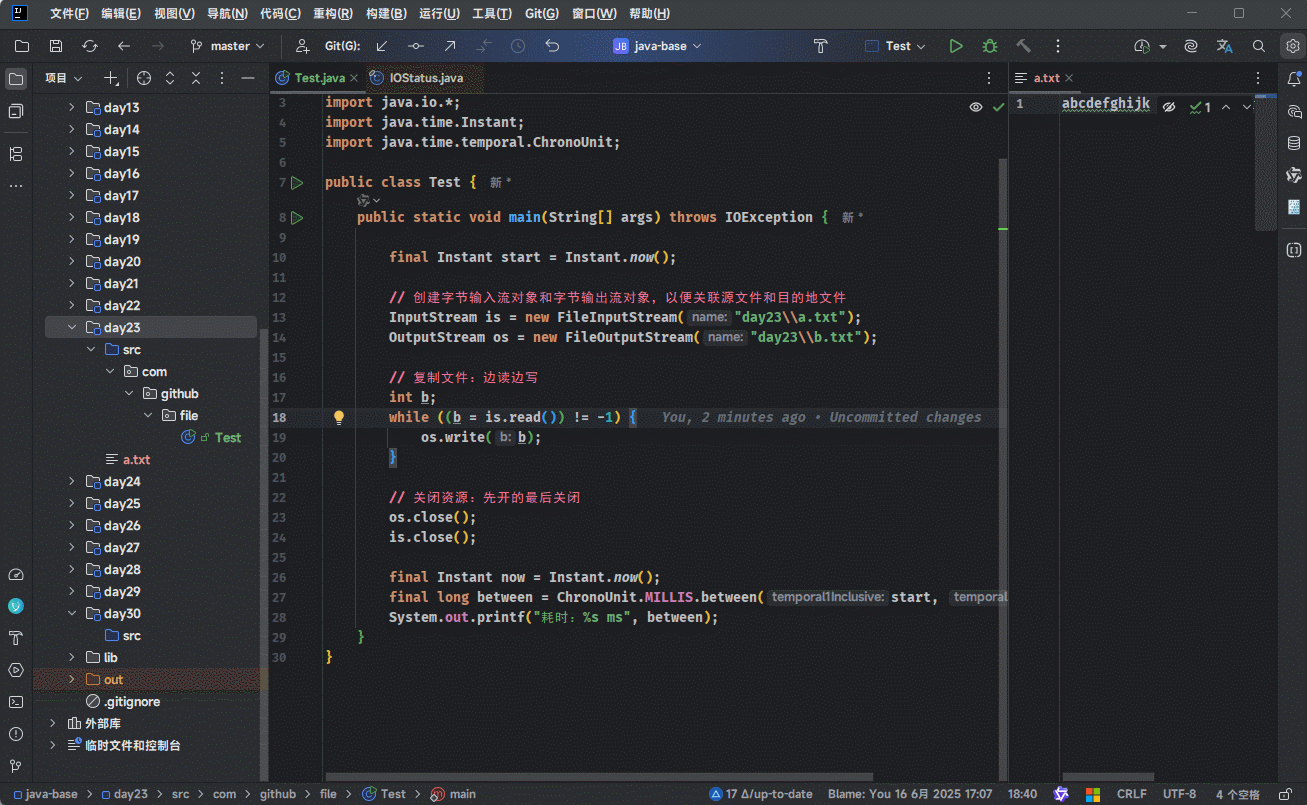
4.4.3 大文件拷贝
4.4.3.1 概述
- 我们可以使用上述复制文件的代码来尝试拷贝大文件,如下所示:
java
package com.github.file;
import java.io.*;
import java.time.Instant;
import java.time.temporal.ChronoUnit;
public class Test {
public static void main(String[] args) throws IOException {
final Instant start = Instant.now();
// 创建字节输入流对象和字节输出流对象,以便关联源文件和目的地文件
InputStream is = new FileInputStream("D:\\movie.avi");
OutputStream os = new FileOutputStream("D:\\movie-copy.avi");
// 复制文件:边读边写
int b;
while ((b = is.read()) != -1) {
os.write(b);
}
// 关闭资源:先开的最后关闭
os.close();
is.close();
final Instant now = Instant.now();
final long between = ChronoUnit.MILLIS.between(start, now);
System.out.printf("耗时:%s ms", between); // 耗时:149844 ms
}
}1
2
3
4
5
6
7
8
9
10
11
12
13
14
15
16
17
18
19
20
21
22
23
24
25
26
27
28
29
30
2
3
4
5
6
7
8
9
10
11
12
13
14
15
16
17
18
19
20
21
22
23
24
25
26
27
28
29
30
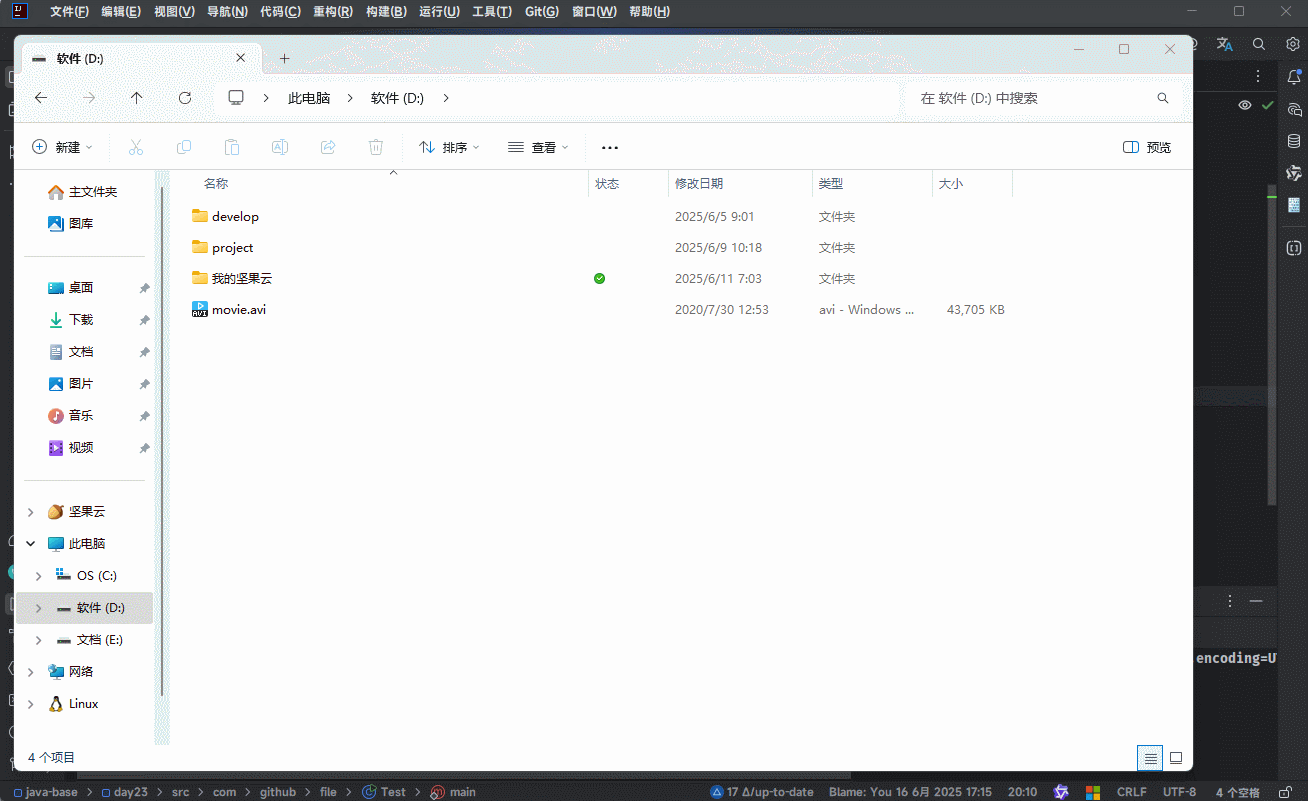
提醒
我们会发现速度非常慢,原因就在于复制文件的时候,每次只读写了一个字节!!!
- 一般情况下,我们会将
要拷贝的文件称为数据源,而将文件拷贝到哪里去称为目的地,并且程序是运行在内存中的。
- 当我们在代码中创建
字节输入流对象和字节输出流对象的时候,程序就和数据源以及目的地建立了传输数据的通道:
- 当进行复制文件的时候(边读边写),我们是通过临时变量
b来记录当前读取的数据:
- 在循环中,我们使用
read()方法读取数据时,底层是将读取到的数据存储到临时变量b中:
- 在循环中,我们使用
write()方法写出数据时,底层是将临时变量b中的数据写到目的地:
- 就这么不停的读、不停的写,直到拷贝完所有数据为止。
提醒
- ① 最大的弊端就在于每次只读写一个字节,太慢了(性能的短板或瓶颈)。
- ② 如果一个文件是 30 MB,换算为字节是
30*1024*1024=31457280B,就需要循环31457280多次,能不慢吗?
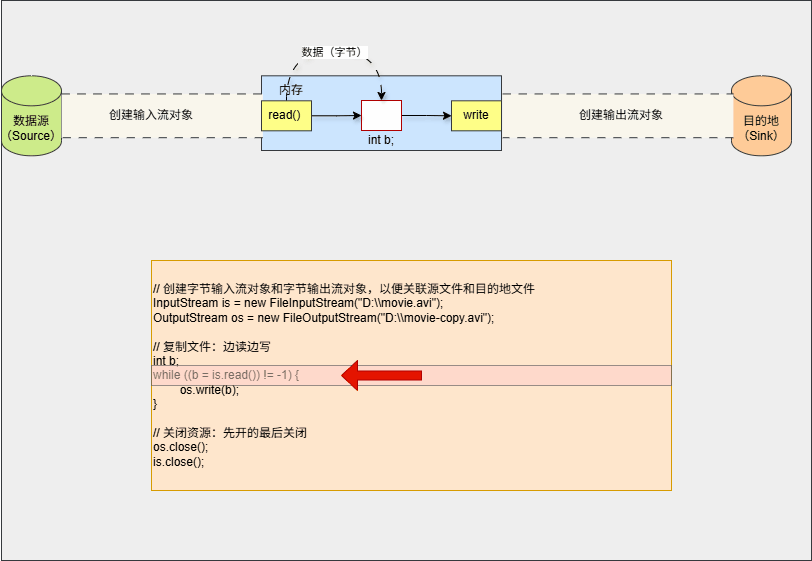
4.4.3.2 一次读取多个字节
- 既然我们已经知道了性能的短板(瓶颈)就在于每次只读写一个字节,那么我们读写读写多个字节,不就可以提高文件拷贝的速度?
- FileInputStream 提供了多个重载的 read() 方法:
| 方法名称 | 描述 |
|---|---|
public abstract int read() throws IOException; | 一次读一个字节数据 |
public int read(byte[] buffer) throws IOException {} | 一次读一个字节数组数据 |
注意
read(byte[] buffer):一次读一个字节数组的数据,每次读取会尽可能将数组装满!!!
- ① 如果数组的长度是 2 ,那么该方法一次会尽量读 2 个字节的数据。
- ② 如果数组的长度是 100 ,那么该方法一次会尽量读 100 个字节的数据。
- ③ ...
- ④ 由于数组也会占用内存空间,如果数组的长度很长很长,内存可能会直接溢出。
- ⑤ 通常情况下,我们都会设置 1024 的整数倍,如:
1024=1KB、1024*1024*5=5MB。
- 我们可以先将数组(缓冲区)的长度设置为 2 ,来观察效果:
java
package com.github.file;
import java.io.*;
public class Test {
public static void main(String[] args) throws IOException {
// 创建字节输入流对象
InputStream is = new FileInputStream("day23\\\\a.txt");
// 创建缓冲区
byte[] buffer = new byte[2];
// 读取数据
// 一次读取多个字节数组,具体读多少,和数组的长度有关
// 返回值:本次读取到了多少个字节数据,如果返回 -1,表示没有数据了
int len = is.read(buffer);
System.out.println(len); // 2
System.out.println(new String(buffer)); // ab
// 关闭资源:先开的最后关闭
is.close();
}
}1
2
3
4
5
6
7
8
9
10
11
12
13
14
15
16
17
18
19
20
21
22
23
2
3
4
5
6
7
8
9
10
11
12
13
14
15
16
17
18
19
20
21
22
23
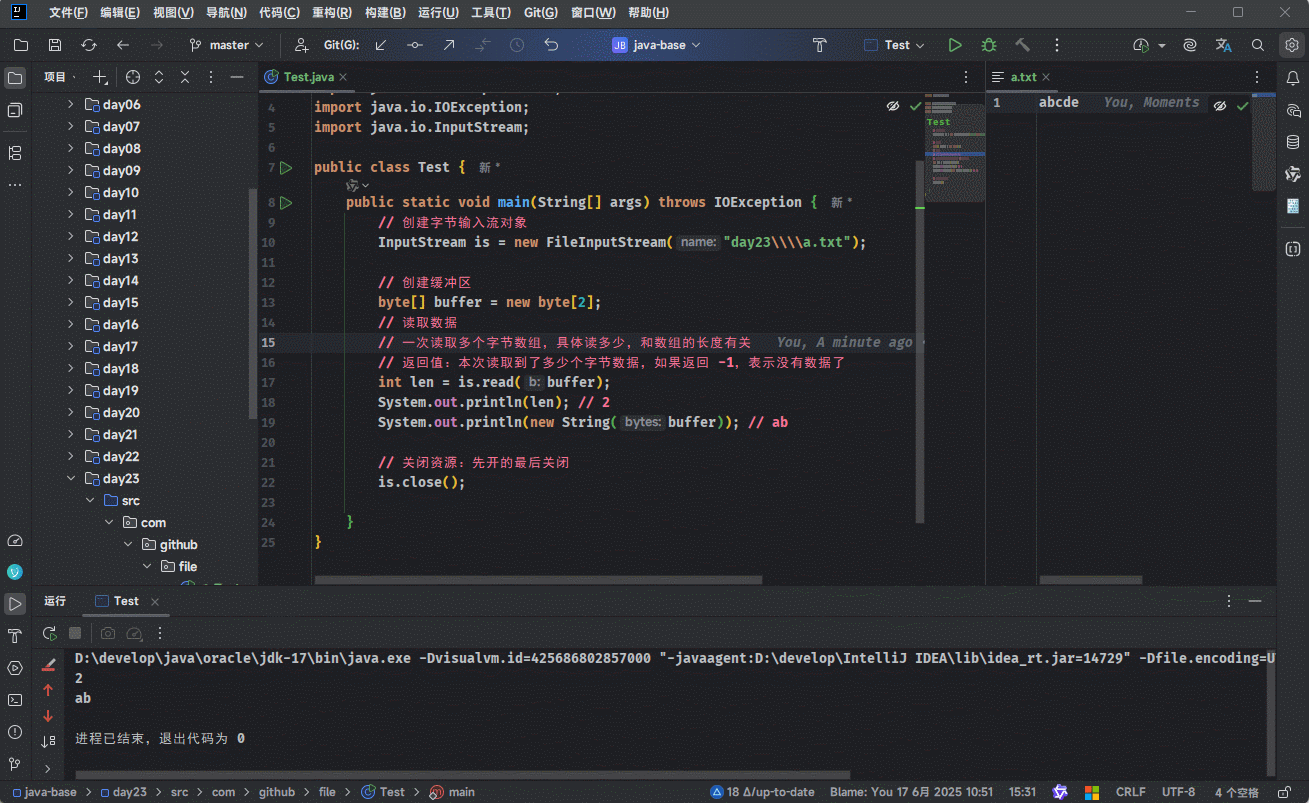
- 多读几次数据,直接读取到文件末尾:
java
package com.github.file;
import java.io.FileInputStream;
import java.io.IOException;
import java.io.InputStream;
public class Test {
public static void main(String[] args) throws IOException {
// 创建字节输入流对象
InputStream is = new FileInputStream("day23\\\\a.txt");
// 创建缓冲区
byte[] buffer = new byte[2];
// 读取数据
// 一次读取多个字节数组,具体读多少,和数组的长度有关
// 返回值:本次读取到了多少个字节数据,如果返回 -1,表示没有数据了
int len = is.read(buffer);
System.out.println(len); // 2
System.out.println(new String(buffer)); // ab
len = is.read(buffer);
System.out.println(len); // 2
System.out.println(new String(buffer)); // cd
len = is.read(buffer);
System.out.println(len); // 1
System.out.println(new String(buffer)); // ???
// 关闭资源:先开的最后关闭
is.close();
}
}1
2
3
4
5
6
7
8
9
10
11
12
13
14
15
16
17
18
19
20
21
22
23
24
25
26
27
28
29
30
31
32
33
2
3
4
5
6
7
8
9
10
11
12
13
14
15
16
17
18
19
20
21
22
23
24
25
26
27
28
29
30
31
32
33
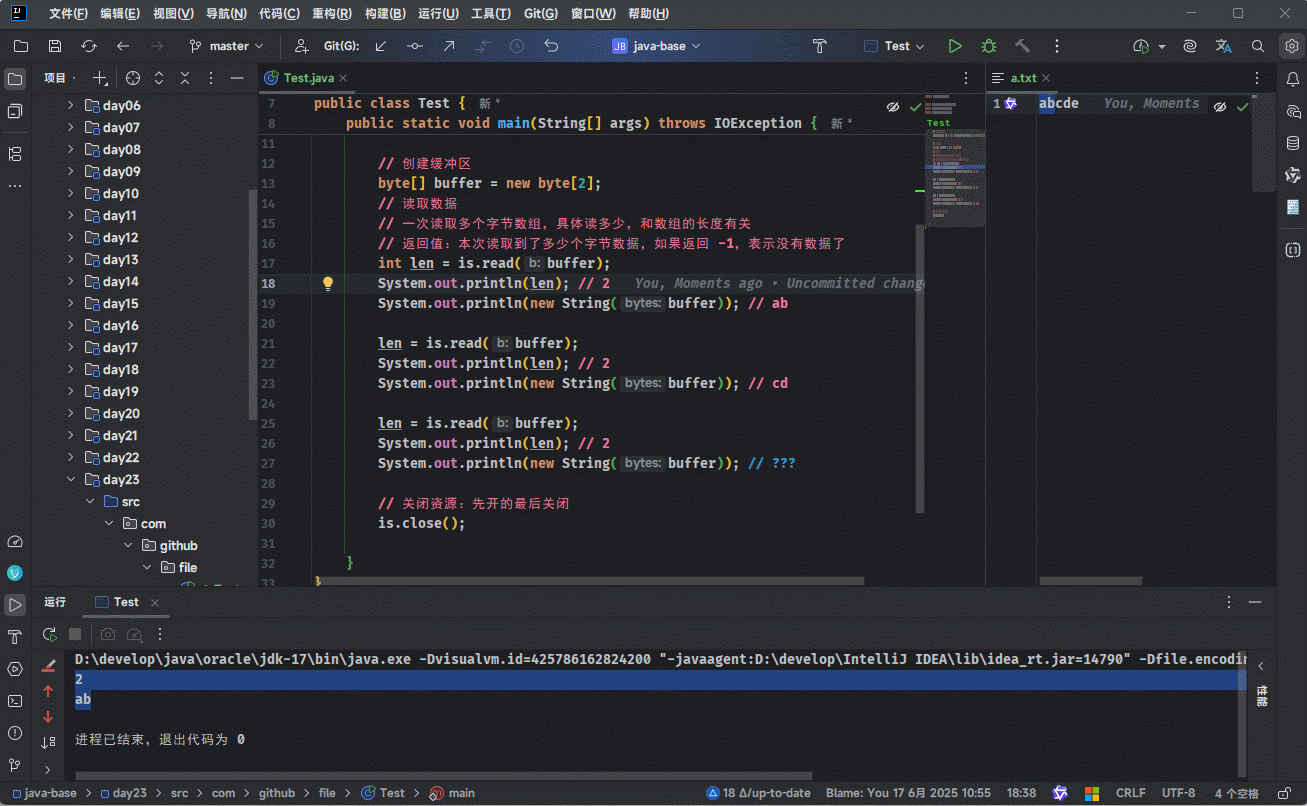
提醒
我们会发现最后一次数据,是不对的,至于原因是什么,接着往下看!!!
- 当代码执行到
创建字节输入流对象时,就意味着内存和数据源有了一个传输数据的通道:
- 当代码执行到创建缓冲区(字节数组)时,就意味着内存中已经创建了数组对象:
- 当代码执行到读取数据到缓冲区(数组)时:
提醒
底层做了以下两件事:
- ① 将读取到的数据存储到缓冲区中,即:buffer 数组中是
'a'和'b'。 - ② 读取到了 2 个字节的数据,那么长度 len 就等于 2 ,就意味着内存中有一个临时变量,其值是 2 。
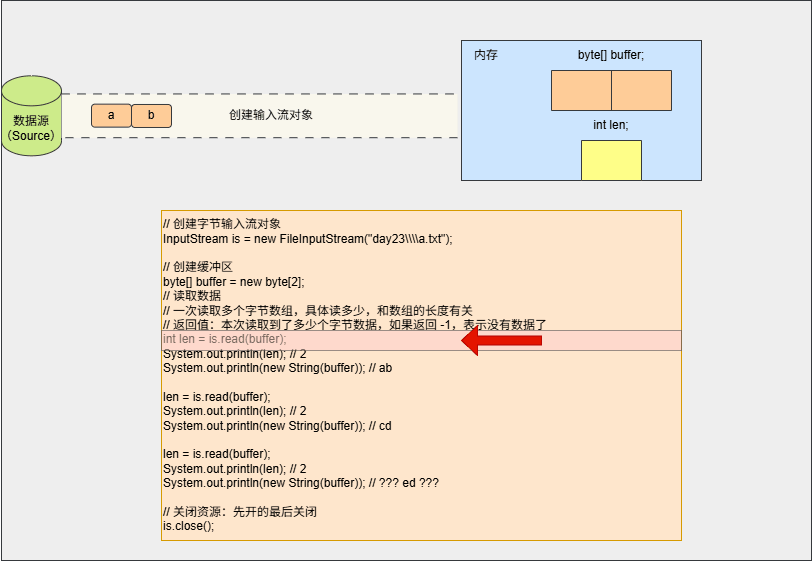
- 同理,读取
'c'和'd'到缓冲区时,也是相同的逻辑:
提醒
底层做了以下两件事:
- ① 将读取到的数据存储到缓冲区中,即:buffer 数组中是
'c'和'd'。 - ② 读取到了 2 个字节的数据,那么长度 len 就等于 2 ,就意味着内存中有一个临时变量,其值是 2 。
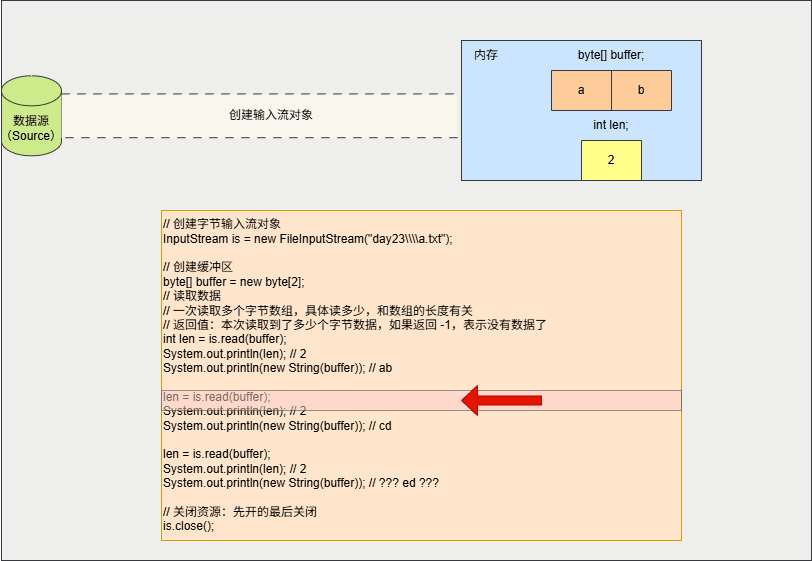
- 但是,当读取了
'e'的时候,逻辑就和上面没有什么不同:
提醒
底层做了以下两件事:
- ① 将读取到的数据存储到缓冲区中,即:buffer 数组中是
'e'。 - ② 读取到了 1 个字节的数据,那么长度 len 就等于 1 ,就意味着内存中有一个临时变量,其值是 1 。
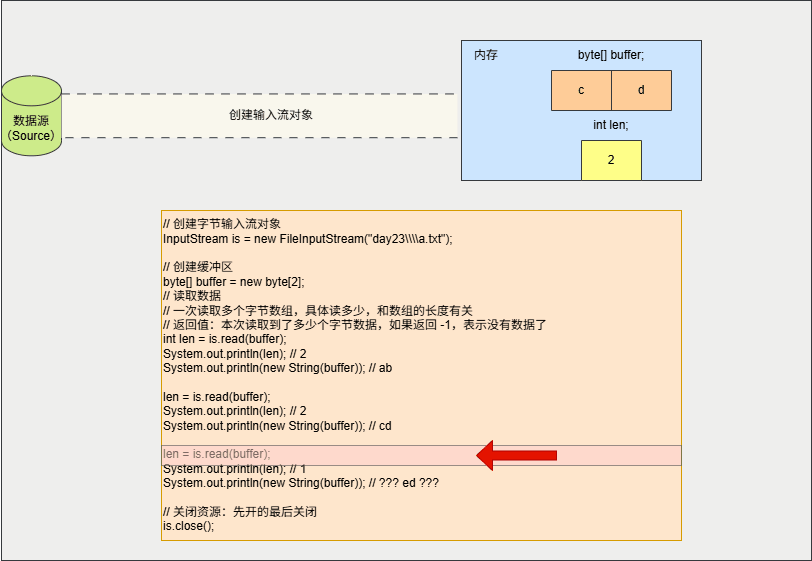
重要
问题就在于实际只读取了 1 个字节的数据;但是,打印的时候,却将缓冲区中的数据全部输出!!!
- 解决方案很简单,读取多少长度的数据,就从缓冲区到取多少长度的数据。
java
package com.github.file;
import java.io.FileInputStream;
import java.io.IOException;
import java.io.InputStream;
public class Test {
public static void main(String[] args) throws IOException {
// 创建字节输入流对象
InputStream is = new FileInputStream("day23\\a.txt");
// 创建缓冲区
byte[] buffer = new byte[2];
// 读取数据
// 一次读取多个字节数组,具体读多少,和数组的长度有关
// 返回值:本次读取到了多少个字节数据,如果返回 -1,表示没有数据了
int len = is.read(buffer);
System.out.println(len); // 2
System.out.println(new String(buffer,0,len)); // ab
len = is.read(buffer);
System.out.println(len); // 2
System.out.println(new String(buffer,0,len)); // cd
len = is.read(buffer);
System.out.println(len); // 1
System.out.println(new String(buffer,0,len)); // e
// 关闭资源:先开的最后关闭
is.close();
}
}1
2
3
4
5
6
7
8
9
10
11
12
13
14
15
16
17
18
19
20
21
22
23
24
25
26
27
28
29
30
31
32
33
2
3
4
5
6
7
8
9
10
11
12
13
14
15
16
17
18
19
20
21
22
23
24
25
26
27
28
29
30
31
32
33
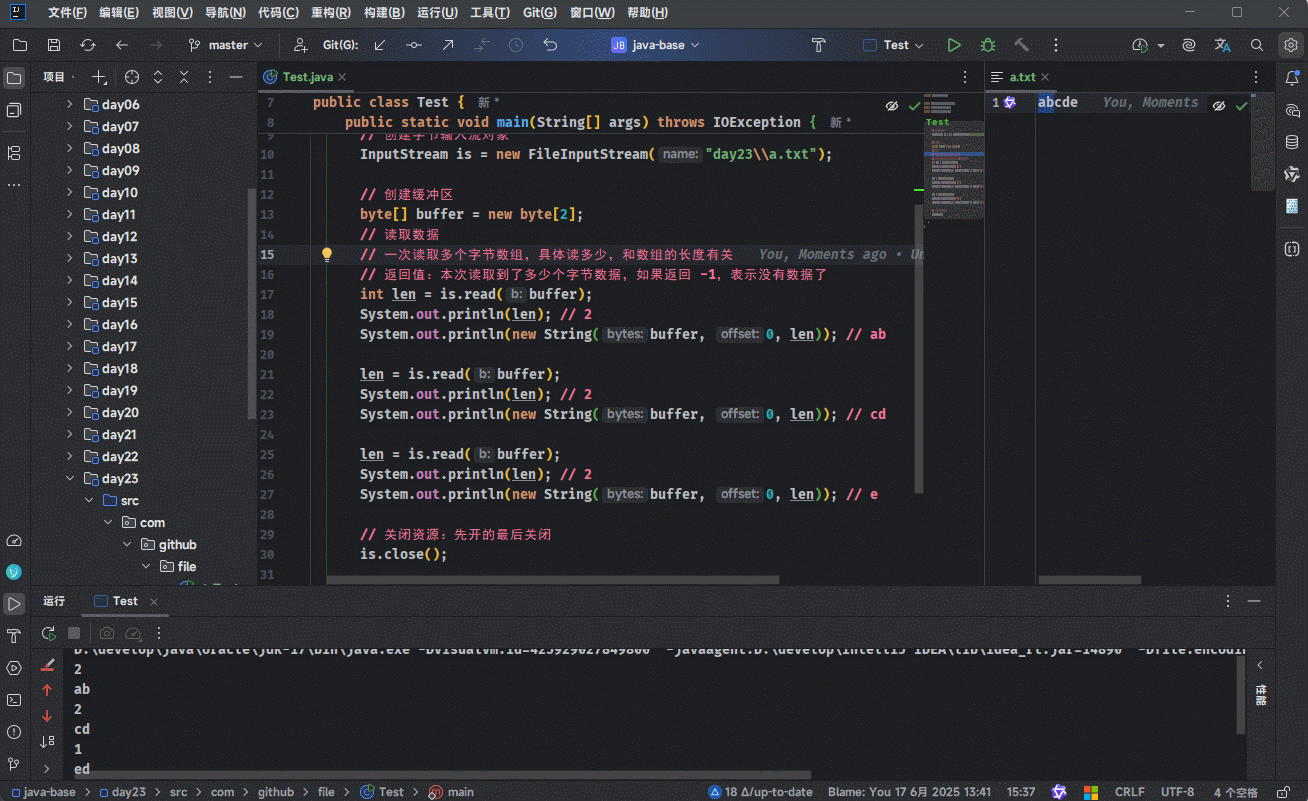
- 和之前一样,我们也可以使用
循环来读取数据,如下所示:
java
package com.github.file;
import java.io.FileInputStream;
import java.io.IOException;
import java.io.InputStream;
public class Test {
public static void main(String[] args) throws IOException {
// 创建字节输入流对象
InputStream is = new FileInputStream("day23\\a.txt");
// 创建缓冲区
byte[] buffer = new byte[2];
// 读取数据
int len;
while ((len = is.read(buffer)) != -1) {
System.out.println(new String(buffer, 0, len));
}
// 关闭资源:先开的最后关闭
is.close();
}
}1
2
3
4
5
6
7
8
9
10
11
12
13
14
15
16
17
18
19
20
21
22
2
3
4
5
6
7
8
9
10
11
12
13
14
15
16
17
18
19
20
21
22
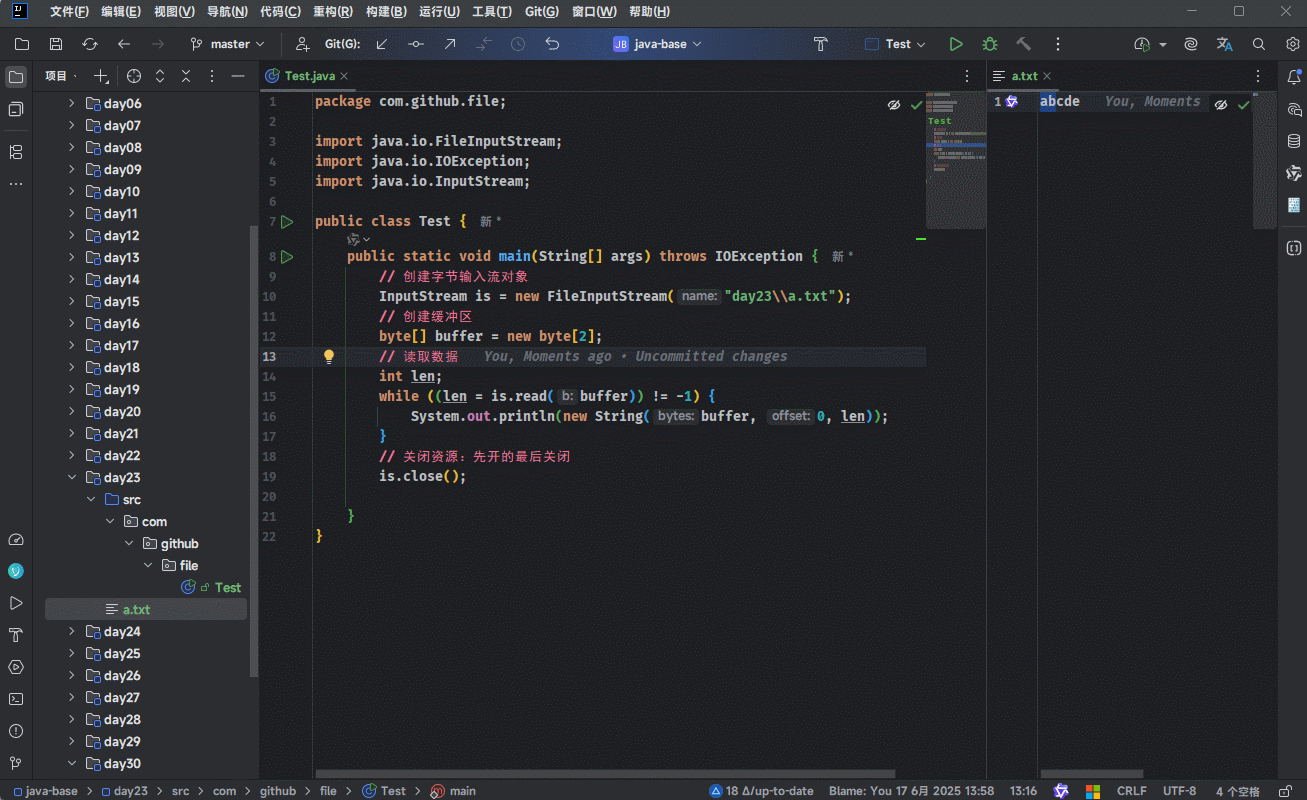
4.4.3.3 大文件拷贝
- 文件的拷贝(复制),其主要思想是:边读边写,并且先打开的流最后关闭。
提醒
- ① 使用两种方式来进行文件拷贝。
- ② 需要统计耗时!!!
- 示例:一次读取一个字节
java
package com.github.file;
import java.io.*;
import java.time.Instant;
import java.time.temporal.ChronoUnit;
public class Test {
public static void main(String[] args) throws IOException {
Instant start = Instant.now();
// 创建字节输入流对象和字节输出流对象,以便关联源文件和目的地文件
InputStream is = new FileInputStream("D:\\movie.avi");
OutputStream os = new FileOutputStream("D:\\movie-copy.avi");
// 复制文件:边读边写
int b;
while ((b = is.read()) != -1) {
os.write(b);
}
// 关闭资源:先开的最后关闭
os.close();
is.close();
Instant now = Instant.now();
long between = ChronoUnit.MILLIS.between(start, now);
System.out.printf("耗时:%s ms", between); // 耗时:149844 ms
}
}1
2
3
4
5
6
7
8
9
10
11
12
13
14
15
16
17
18
19
20
21
22
23
24
25
26
27
28
29
30
2
3
4
5
6
7
8
9
10
11
12
13
14
15
16
17
18
19
20
21
22
23
24
25
26
27
28
29
30

- 示例:一次读取多个字节
java
package com.github.file;
import java.io.*;
import java.time.Instant;
import java.time.temporal.ChronoUnit;
public class Test {
public static void main(String[] args) throws IOException {
Instant start = Instant.now();
// 创建字节输入流对象
InputStream is = new FileInputStream("D:\\movie.avi");
OutputStream os = new FileOutputStream("D:\\movie-copy.avi");
// 创建缓冲区
byte[] buffer = new byte[1024 * 1024 * 5];
// 读取数据
int len;
while ((len = is.read(buffer)) != -1) {
os.write(buffer, 0, len);
}
// 关闭资源:先开的最后关闭
os.close();
is.close();
Instant now = Instant.now();
long between = ChronoUnit.MILLIS.between(start, now);
System.out.printf("耗时:%s ms", between); // 耗时:34 ms
}
}1
2
3
4
5
6
7
8
9
10
11
12
13
14
15
16
17
18
19
20
21
22
23
24
25
26
27
28
29
2
3
4
5
6
7
8
9
10
11
12
13
14
15
16
17
18
19
20
21
22
23
24
25
26
27
28
29
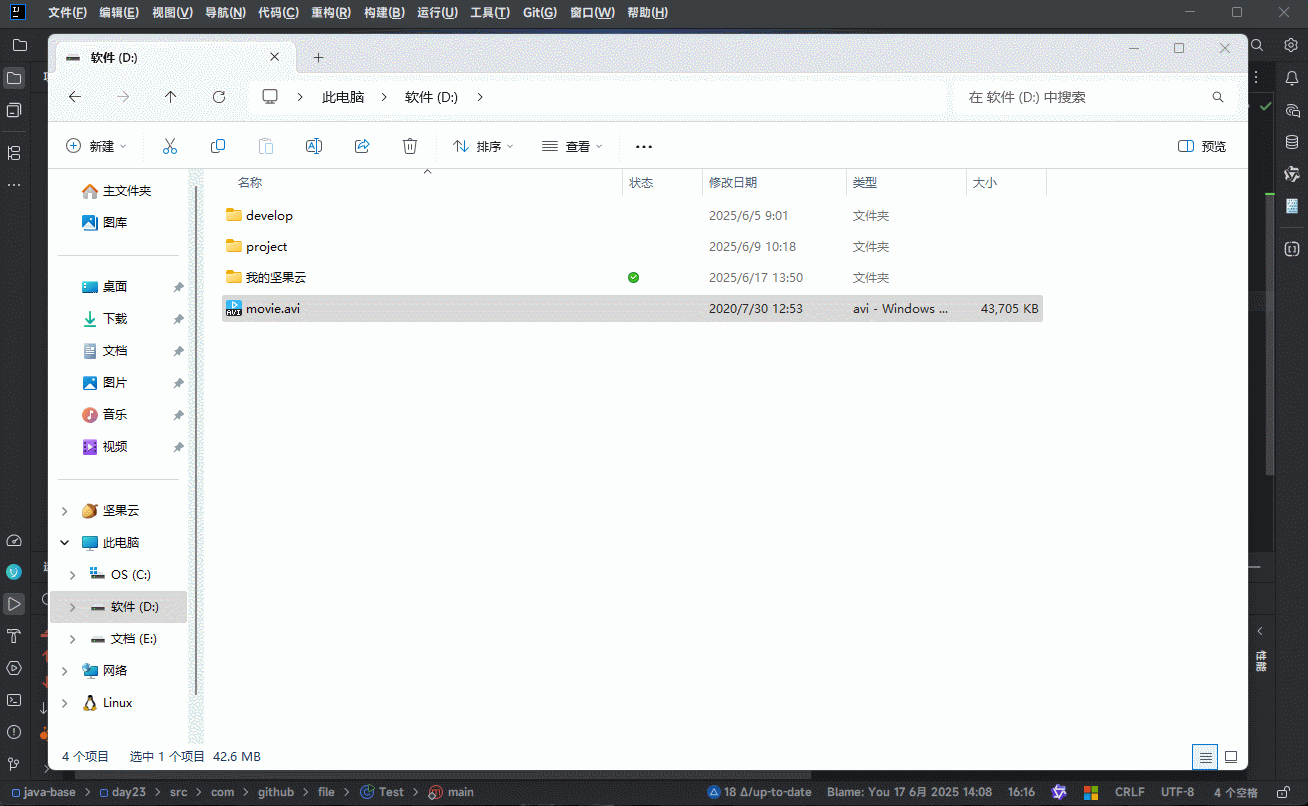
4.5 异常处理
4.5.1 概述
- 之前,我们对于异常处理,都是采取的抛出的模型:
java
package com.github.file;
import java.io.FileOutputStream;
import java.io.IOException;
import java.io.OutputStream;
public class Test {
public static void main(String[] args) throws IOException {
// 创建输出流对象(并指定文件的路径)
OutputStream os = new FileOutputStream("day23\\a.txt");
// 写出数据
os.write(Character.codePointAt("a", 0));
// 释放资源
os.close();
}
}1
2
3
4
5
6
7
8
9
10
11
12
13
14
15
16
2
3
4
5
6
7
8
9
10
11
12
13
14
15
16
提醒
采取抛出异常的方式,如果程序出现了问题,就会直接终止!!!
- 为了避免上述的情况,我们就需要手动处理异常,难道直接放到 try 语句块中?
java
package com.github.file;
import java.io.FileOutputStream;
import java.io.IOException;
import java.io.OutputStream;
public class Test {
public static void main(String[] args) {
try {
// 创建输出流对象(并指定文件的路径)
OutputStream os = new FileOutputStream("day23\\a.txt");
// 写出数据
os.write(Character.codePointAt("a", 0));
// 释放资源
os.close();
} catch (IOException e) {
e.printStackTrace();
}
}
}1
2
3
4
5
6
7
8
9
10
11
12
13
14
15
16
17
18
19
20
2
3
4
5
6
7
8
9
10
11
12
13
14
15
16
17
18
19
20
- 上面的方式是不对的,因为
创建流对象和写出数据都有可能出现异常,导致不能释放资源:
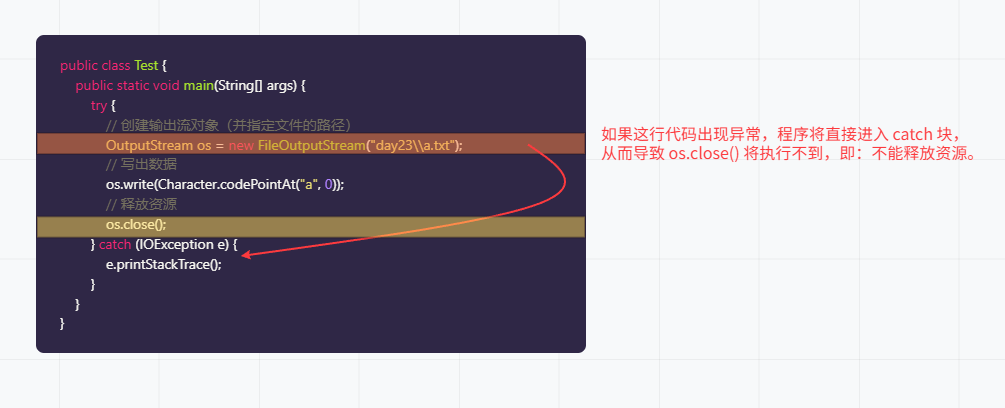
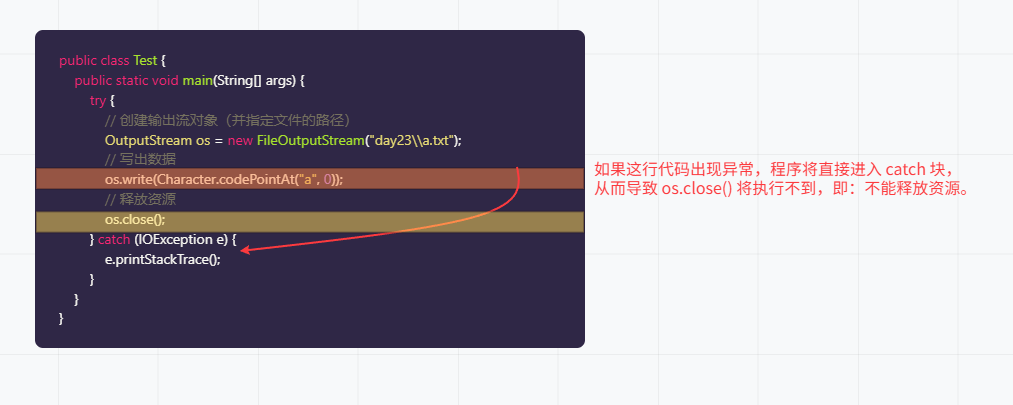
4.5.2 异常处理
- 针对上面的情况,我们可以使用 finally 块来解决:
java
try {
}catch(异常类型 e){
}catch(异常类型2 e){
}catch(异常类型n e){
}finally {
}1
2
3
4
5
6
7
8
9
10
11
2
3
4
5
6
7
8
9
10
11
提醒
- ① finally 块中的内容一定会被执行,除非虚拟机停止。
- ② 有很多情况会导致虚拟机停止,如:使用
kill -9 pid或者调用System.exit(0)。 - ③ 对于捕获到的异常,我们通常不会处理,而是将异常信息记录到日志中,然后直接向上抛(Spring 框架有全局异常处理器机制,能帮我们统一处理项目中出现的所有异常);但是,资源必须关闭!!!
- 示例:
Test.java
java
package com.github.file;
import java.io.FileOutputStream;
import java.io.IOException;
import java.io.OutputStream;
public class Test {
public static void main(String[] args) {
OutputStream os = null;
try {
// 创建输出流对象(并指定文件的路径)
os = new FileOutputStream("day23\\a.txt");
// 写出数据
os.write(97);
} catch (IOException e) {
e.printStackTrace();
} finally {
// 释放资源
if (null != os) {
try {
os.close();
} catch (IOException e) {
e.printStackTrace();
}
}
}
}
}1
2
3
4
5
6
7
8
9
10
11
12
13
14
15
16
17
18
19
20
21
22
23
24
25
26
27
28
2
3
4
5
6
7
8
9
10
11
12
13
14
15
16
17
18
19
20
21
22
23
24
25
26
27
28
4.5.3 异常处理新方案(JDK 7、JDK9)
- JDK7 之前,我们需要手动释放资源:
java
try {
// 可能出现的异常代码
}catch(异常类名 变量名){
// 异常处理代码
}finally {
// 执行所有的资源释放操作
}1
2
3
4
5
6
7
2
3
4
5
6
7
- JDK7 之后,Java 推出一个名为
AutoCloseable的接口,这个接口非常有用!!!
提醒
- ① 只要流实现了该接口,就可以在特定的情况下自动释放资源,即:不需要再手动释放资源了。
- ② 所谓的特定的情况:指的就是 try with resources 语法!!!
java
try (创建流对象1;创建流对象2) {
// 可能出现的异常代码
} catch (异常类名 变量名) {
e.printStackTrace();
}1
2
3
4
5
2
3
4
5
- JDK9 之后,也可以将创建流对象的语句提取到 try 语句之前:
java
创建流对象1;创建流对象2;
try (流1;流2) {
// 可能出现的异常代码
} catch (异常类名 变量名) {
e.printStackTrace();
}1
2
3
4
5
6
2
3
4
5
6
- 示例:JDK7 的异常处理方案
java
package com.github.file;
import java.io.*;
public class Test {
public static void main(String[] args) {
// 创建字节输入流对象
try (InputStream is = new FileInputStream("D:\\movie.avi");
OutputStream os = new FileOutputStream("D:\\movie-copy.avi")) {
// 创建缓冲区
byte[] buffer = new byte[1024 * 1024 * 5];
// 读取数据
int len;
while ((len = is.read(buffer)) != -1) {
os.write(buffer, 0, len);
}
} catch (FileNotFoundException e) {
e.printStackTrace();
} catch (IOException e) {
e.printStackTrace();
}
}
}1
2
3
4
5
6
7
8
9
10
11
12
13
14
15
16
17
18
19
20
21
22
23
24
2
3
4
5
6
7
8
9
10
11
12
13
14
15
16
17
18
19
20
21
22
23
24
- 示例:
java
package com.github.file;
import java.io.*;
public class Test {
public static void main(String[] args) throws FileNotFoundException {
// 创建字节输入流对象
InputStream is = new FileInputStream("D:\\movie.avi");
OutputStream os = new FileOutputStream("D:\\movie-copy.avi");
try (is; os) {
// 创建缓冲区
byte[] buffer = new byte[1024 * 1024 * 5];
// 读取数据
int len;
while ((len = is.read(buffer)) != -1) {
os.write(buffer, 0, len);
}
} catch (IOException e) {
e.printStackTrace();
}
}
}1
2
3
4
5
6
7
8
9
10
11
12
13
14
15
16
17
18
19
20
21
22
23
2
3
4
5
6
7
8
9
10
11
12
13
14
15
16
17
18
19
20
21
22
23
4.5.4 异常处理终究方案
- 在实际开发中,我们会借助 Lombok 的
@Cleanup注解和@SneakyThrows注解来进行异常处理。
提醒
- ①
@Cleanup注解会帮助我们自动进行资源管理,即:帮我们自动调用 close() 方法。 - ②
@SneakyThrows注解会帮助我们抛出异常。
- 示例:
java
package com.github;
import lombok.Cleanup;
import lombok.SneakyThrows;
import java.io.*;
public class Test {
@SneakyThrows
public static void main(String[] args) {
// 创建字节输入流对象
@Cleanup InputStream is = new FileInputStream("D:\\movie.avi");
@Cleanup OutputStream os = new FileOutputStream("D:\\movie-copy.avi");
// 创建缓冲区
byte[] buffer = new byte[1024 * 1024 * 5];
// 读取数据
int len;
while ((len = is.read(buffer)) != -1) {
os.write(buffer, 0, len);
}
}
}1
2
3
4
5
6
7
8
9
10
11
12
13
14
15
16
17
18
19
20
21
22
2
3
4
5
6
7
8
9
10
11
12
13
14
15
16
17
18
19
20
21
22
java
package com.github;
import java.io.FileInputStream;
import java.io.FileOutputStream;
import java.io.InputStream;
import java.io.OutputStream;
import java.util.Collections;
public class Test {
public static void main(String[] args) {
try {
InputStream is = new FileInputStream("D:\\movie.avi");
try {
OutputStream os = new FileOutputStream("D:\\movie-copy.avi");
try {
byte[] buffer = new byte[5242880];
int len;
while((len = is.read(buffer)) != -1) {
os.write(buffer, 0, len);
}
} finally {
if (Collections.singletonList(os).get(0) != null) {
os.close();
}
}
} finally {
if (Collections.singletonList(is).get(0) != null) {
is.close();
}
}
} catch (Throwable $ex) {
throw $ex;
}
}
}1
2
3
4
5
6
7
8
9
10
11
12
13
14
15
16
17
18
19
20
21
22
23
24
25
26
27
28
29
30
31
32
33
34
35
36
37
38
39
40
41
2
3
4
5
6
7
8
9
10
11
12
13
14
15
16
17
18
19
20
21
22
23
24
25
26
27
28
29
30
31
32
33
34
35
36
37
38
39
40
41